24 September 2024
 Recent silkscreen, Next. Like all the others, it is in an edition of six.
Recent silkscreen, Next. Like all the others, it is in an edition of six.
8 September 2024
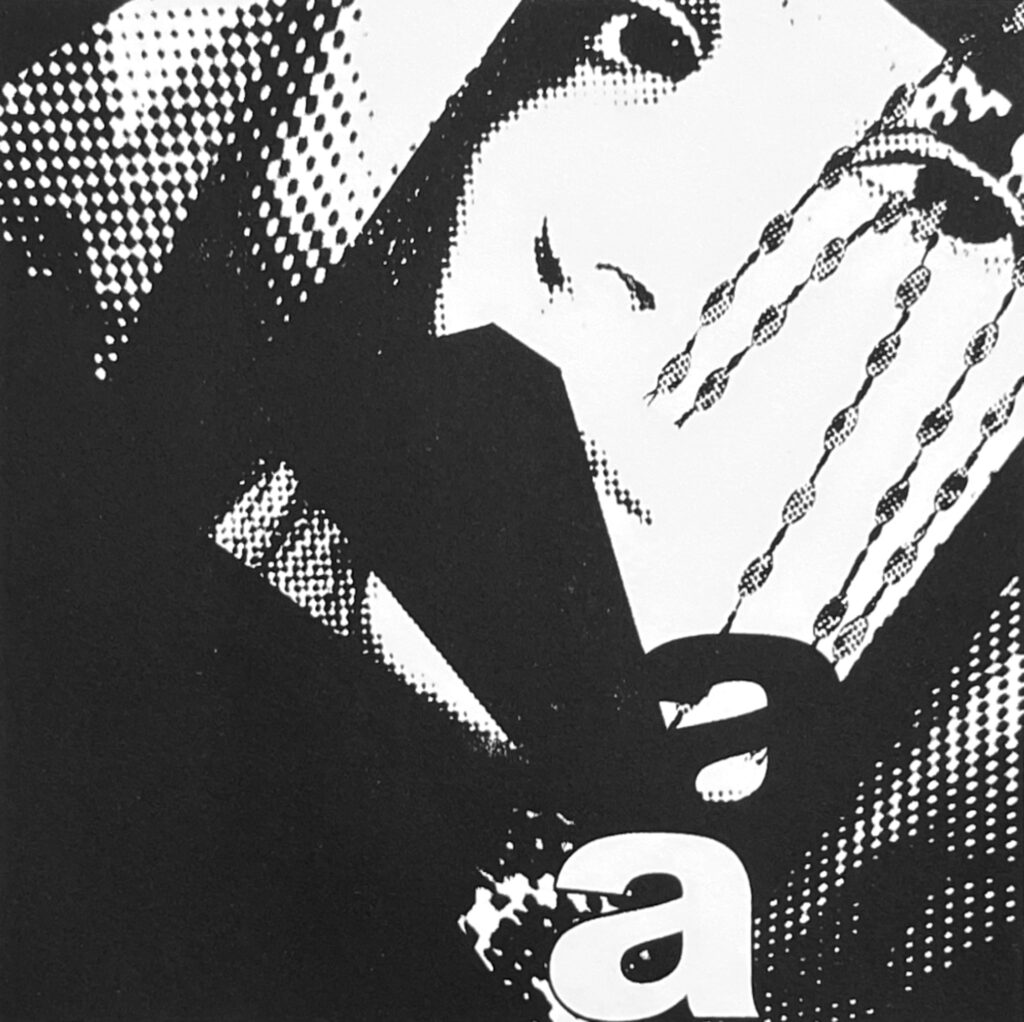 Recent silkscreen, My Ride is here.
Recent silkscreen, My Ride is here.
18 August 2024
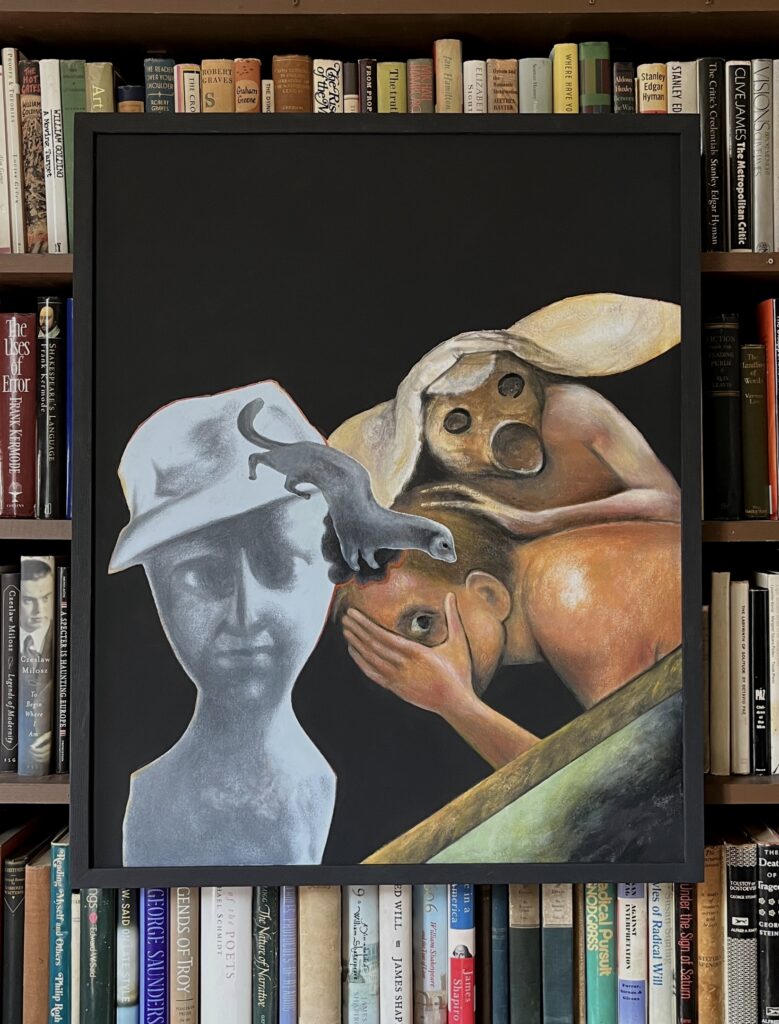
The finished painting I HEARD SOMETHING BREAK is now hanging in our kitchen. It goes for GBP 2500. Note the sort of price difference between one of my paintings and a framed limited edition print as below.
5 August 2024
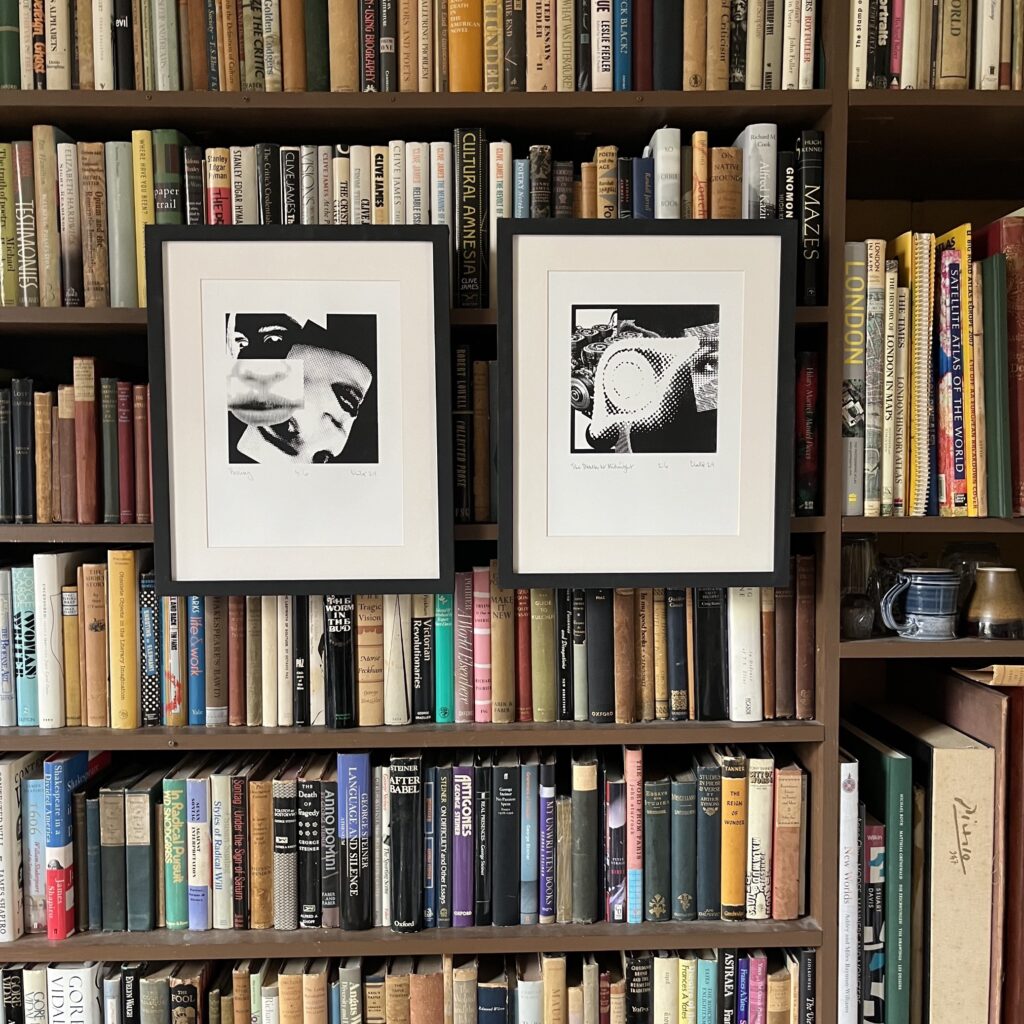
I’m starting to make a set of framed silkscreens for a show. But if you buy first from my studio, you avoid commission and can buy each for GBP 200. See further information in Shopping section.
2 July 2024

Here is the brilliant short story by Geoff Ryman and David Jeffrey with my silkscreen on the cover.
11 June 2024

“Uplift”, my latest painting, is 1000 mm square and took many months to come through because it had started in a completely different place.
23 May 2024

“Genius Loci” is the latest in the Roberto Bolaño series. The background suggests that the upper left reaches of Hieronymus Bosch’s Garden of Earthly Delights might provide a calm retreat from a violent death and might be an alcove in that mysterious future place: 2666. And note: Genius Loci became the overall working title for this portfolio of work.
29 March 2024

Recent visits to the Thames-side Print Studio have produced 12 new editions, the above, Rose Garden of the Disappeared, being one. Each edition is limited to only six hand-pulled prints.
4 February 2024
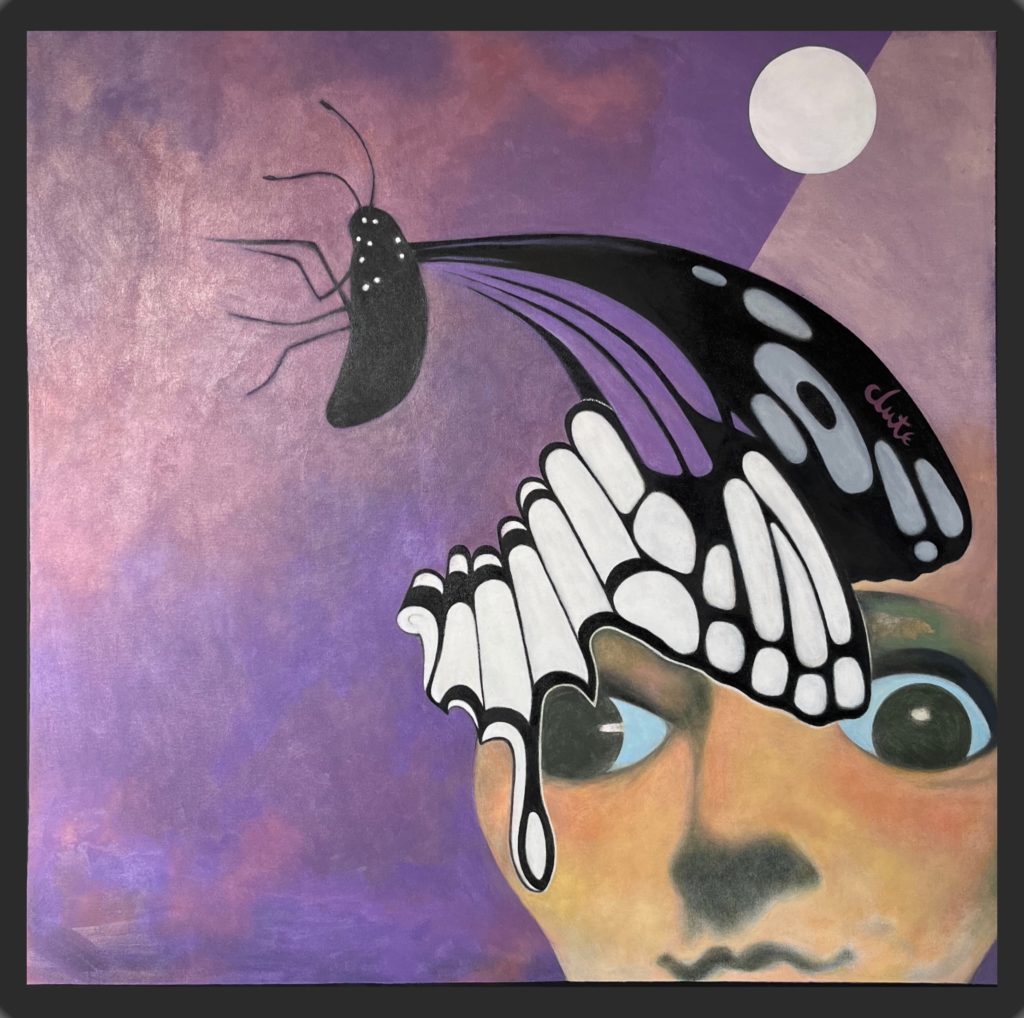
Last night I participated in an evening at Tiraffe, Southampton Row, a good central London location, organised by Geoff Ryman, where he was promoting his novella, “The Many Different Forms of Love”. A silkscreen image of mine was on the cover. Geoff wanted me to have several artworks there including the recent painting above, “The Future Passed”. I spoke a few words about the current project where I’m looking at broken women. The one in this painting is a doll with wonky eyes, but she stands for many others. The idea came to me after reading Roberto Bolaño’s 2666 where there’s that huge section about the women murdered in a Mexican town; the section goes on and on. And I couldn’t help thinking about those lost women and I found that I wanted to retrieve something of their presence, and so I’m making artworks imagining fleeting moments of these women in some strange future place, maybe in the year 2666, where they are looking back out at us from their world.
2 February 2024
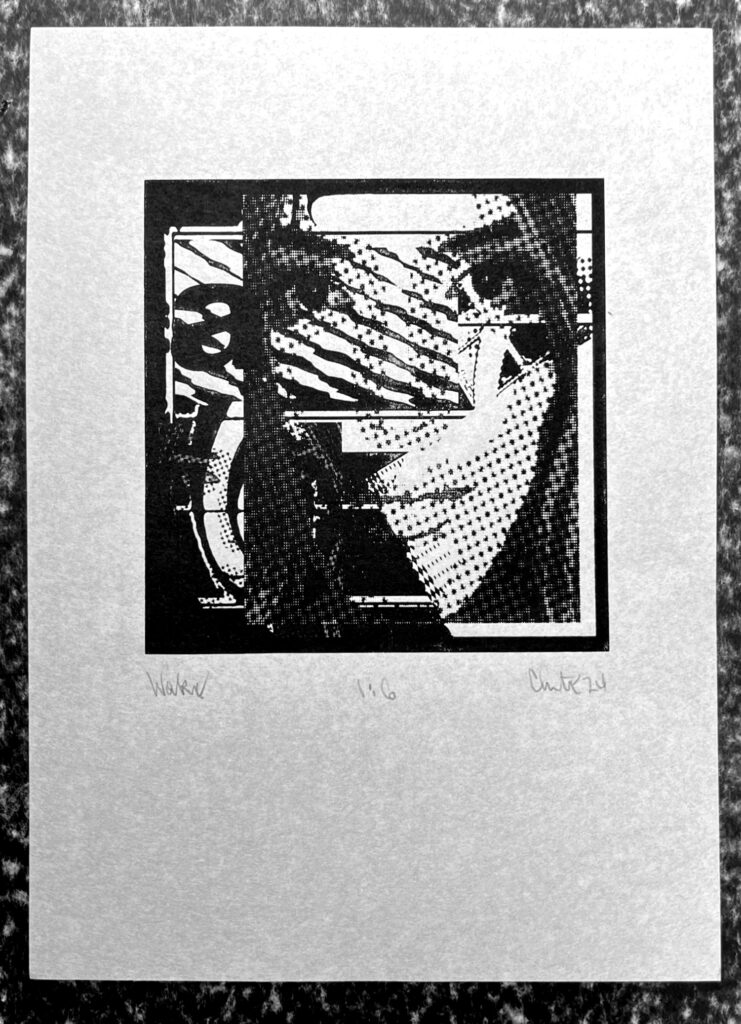
Here’s one of my latest silkscreens and it is printed on Tosa Shi Japanese paper. I plan for more work on this lovely light surface.
21 January 2024
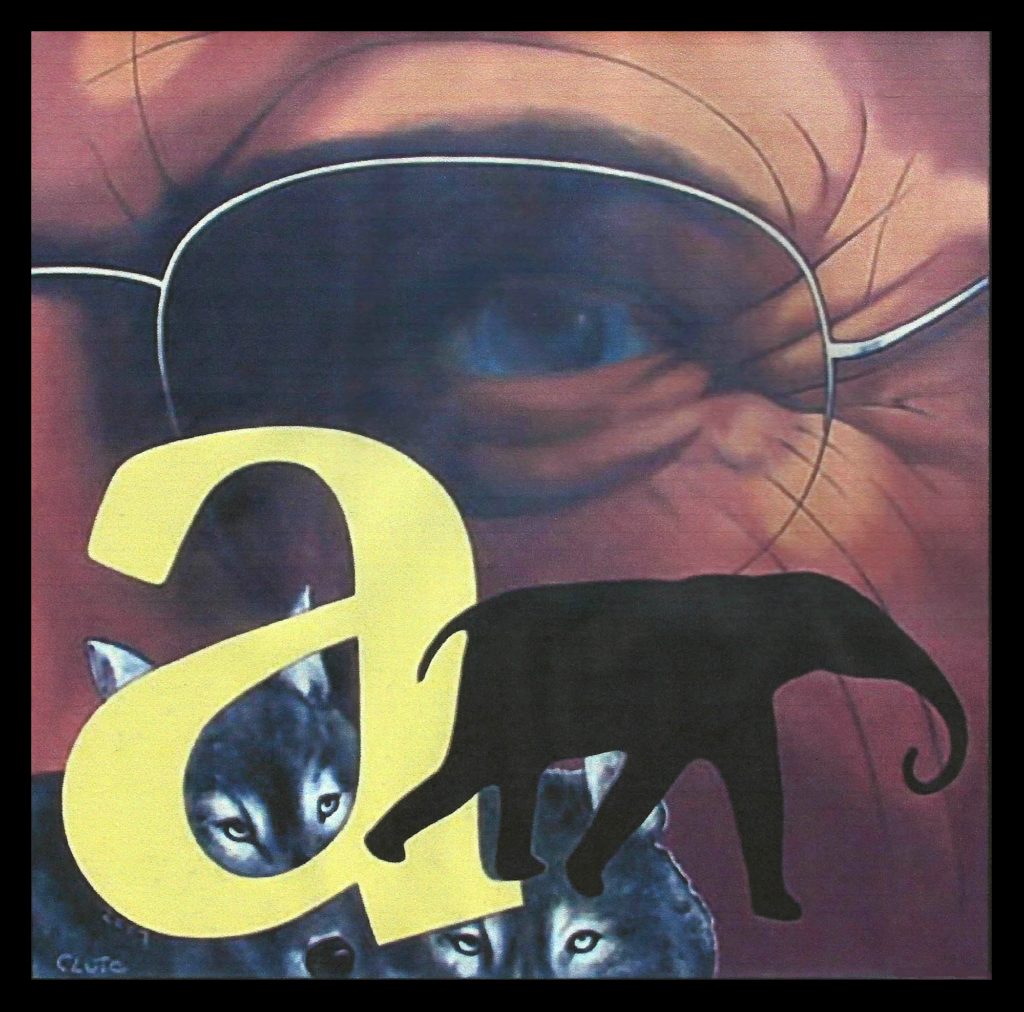
Gene Cantors, one of the 76 paintings from the book, Masques of the Disappeared, reviewed by Paul Kincaid in the latest Interzone # 297. He notes that Judith Clute moves in the world of Science fiction, but that “you will look in vain for a glimpse of such generic clichés as gigantic space ships, weird aliens, or women menaced by monsters. And yet it seems to me that her works touch more eloquently upon the essence of science fiction than any of such familiar devices.” And he adds that the general disorientating effect of her work is “like the science fiction that insinuates itself most effectively into the psyche.”
14 January 2024
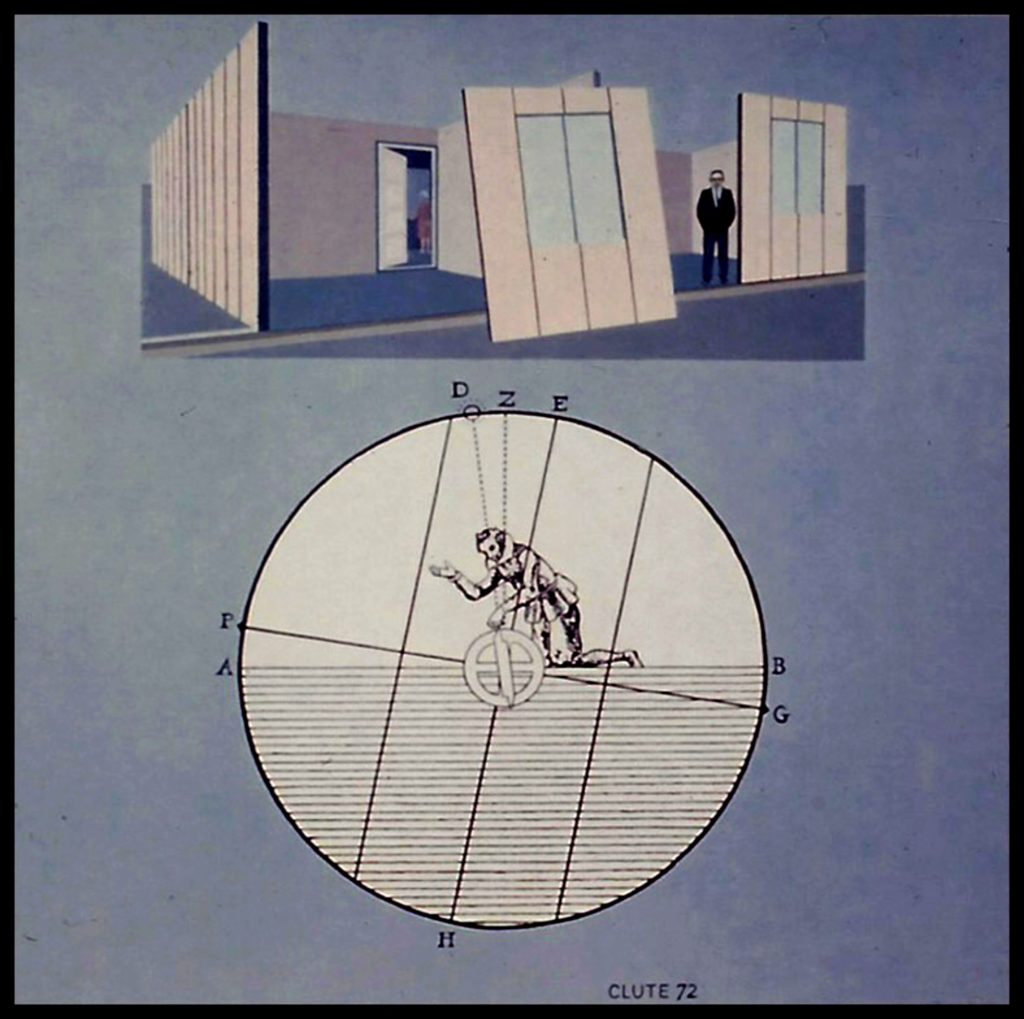
Today’s offering is a painting titled Measuring from 1972 and it’s worth a mention in here for how it shows that even 52 years ago I was approaching the feeling of us as unstable creatures: trying to steady ourselves in this our shifting world. (It also makes me smile because I’m in the midst of reading Thomas Pynchon’s brilliant and funny Mason & Dixon.) … And also I set down, from the book below, one of the etchings, Mill of the Gods, 2015, size: 180 x 140 mm
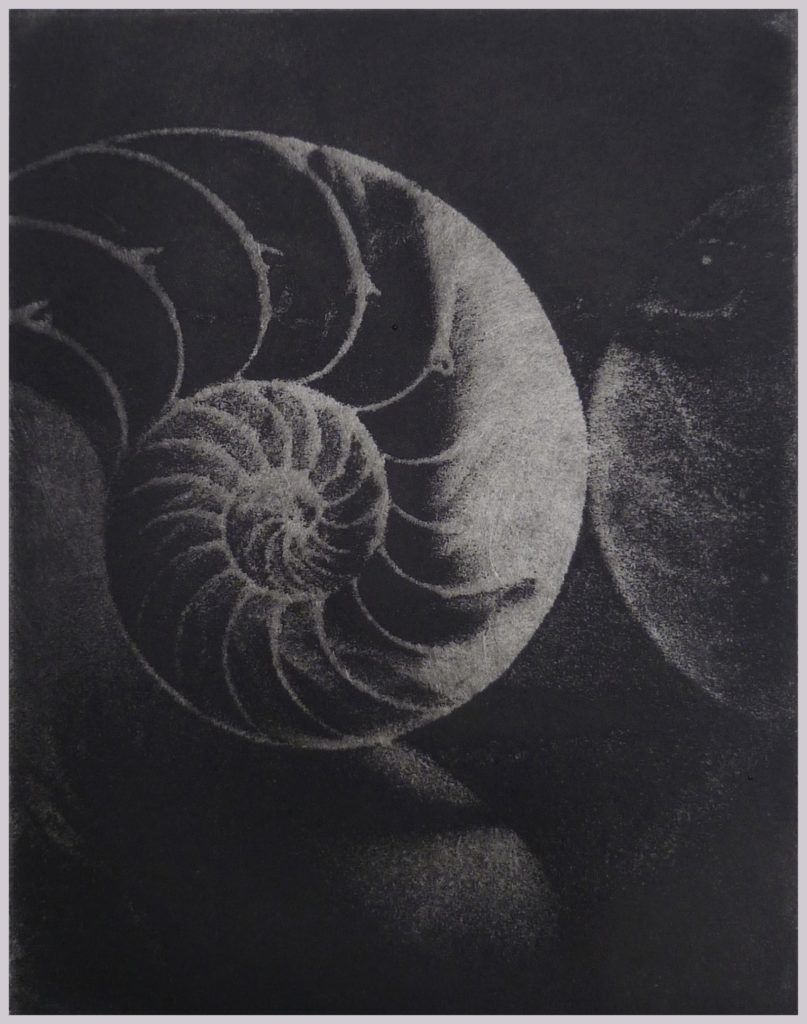
21 December 2023
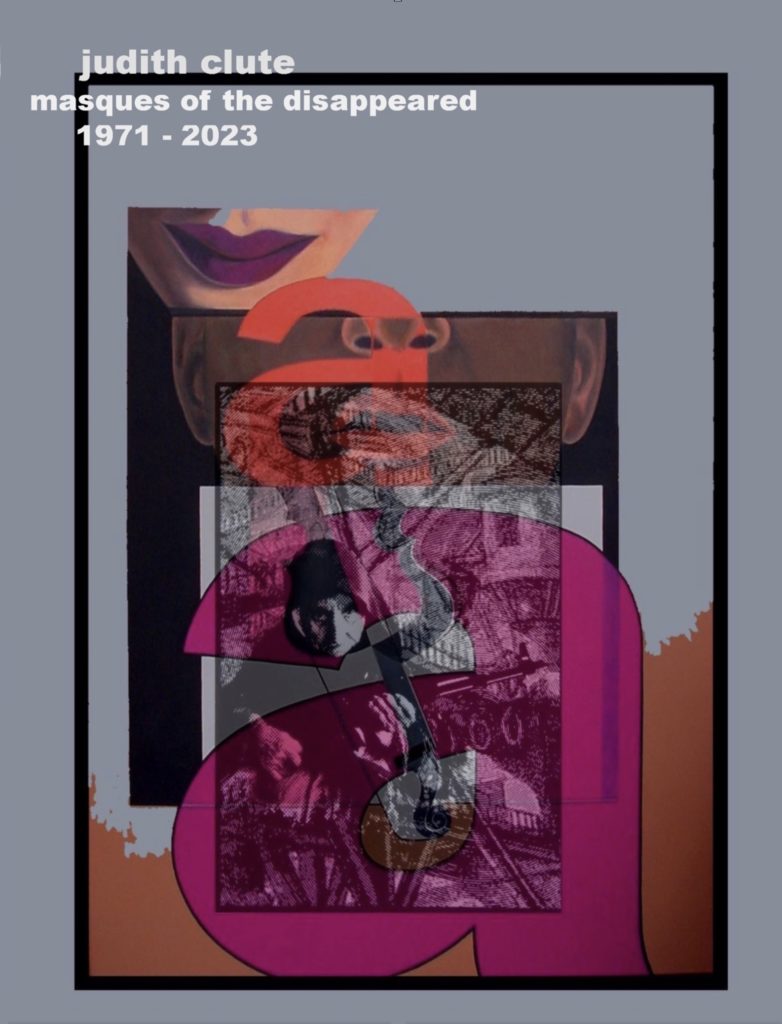
Masques of the Disappeared
This book of 76 paintings and 46 prints, published by Polder House, and launched on the 6th of November 2023 – is a limited and signed edition of 100 copies. There are still copies available, as of this late December 2023 date.
Pricing for this first edition UK: £50.00. p&p included.
ABROAD: £45.00 with posting added. Current cost of posting abroad is sadly considerable. For American and Canadian addresses, a book sent with tracking number directly from the UK runs around about £25.00.
PAYMENT: PayPal or wire transfer. We can work this out when you contact me. judith.clute@gmail.com 07561 805607
“The paintings and prints here represent a sustained understanding of art and the world in our times. Clute sees the play between the two as a drama: a masque whose sustaining actors are not kings and queens and fairies but us. Some of us have disappeared; many have simply gone to dust; some of us walk the walk that Clute describes. Figures and emblems, shapes and apprehensions, appear and reappear through these visions. Each stands alone as a work of art: but no man is an island. Each is joined. Each joins in this great long masque of celebration and mourning.”
9 November 2023
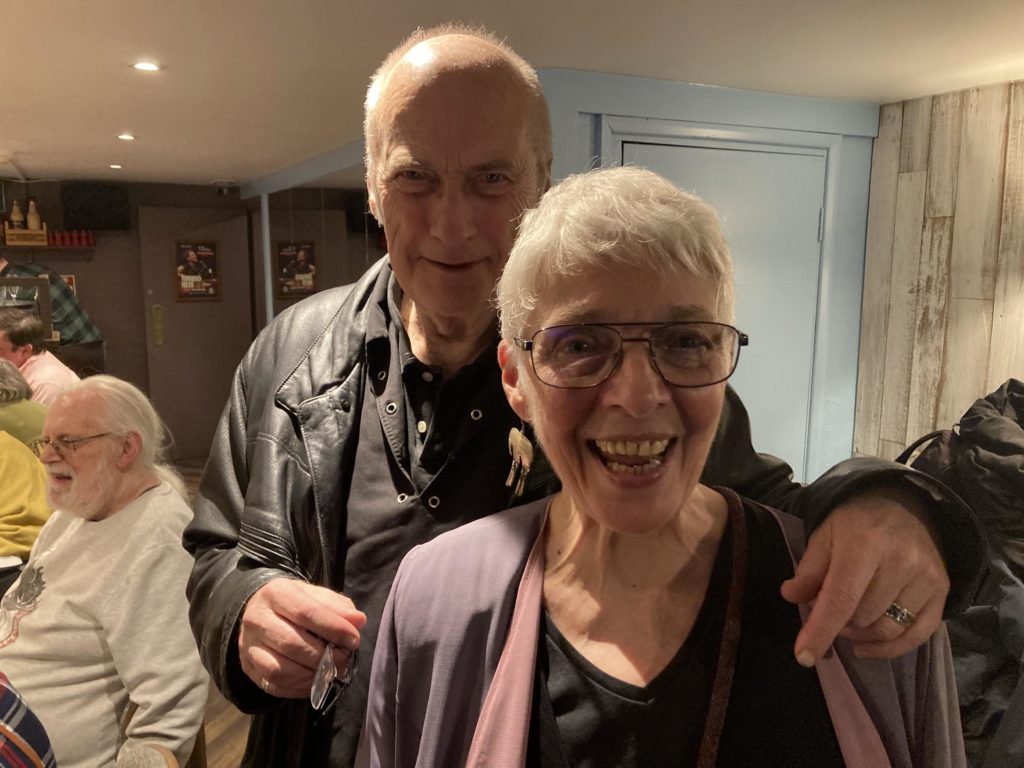
On the 6th of November Masques of the Disappeared was launched at “Made in Brasil”, Inverness Street. Books were sold and I was happy. Here I am with John. This photo was by Mikey Kirkpatrick, but most of the others are by Anne Wittman.
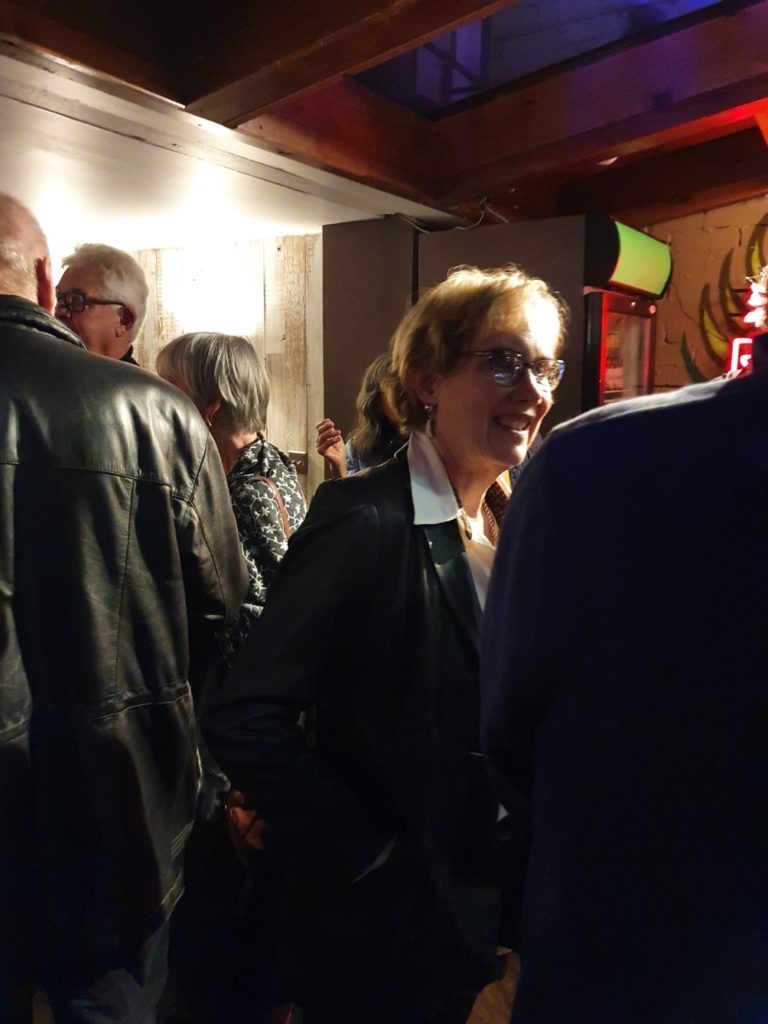
Back of John and he’s talking to Anna and Roger. Behind Liz is Libby.
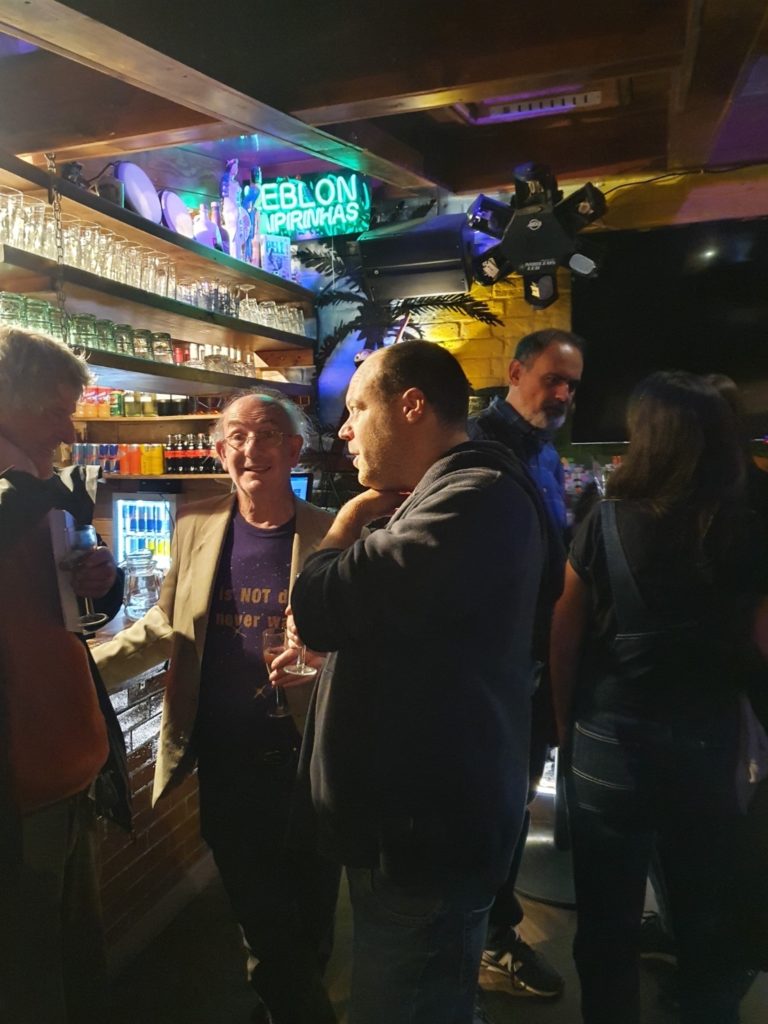
David Tobin, Brian Ameringen, Lavie Tidhar, Konrad Walewski
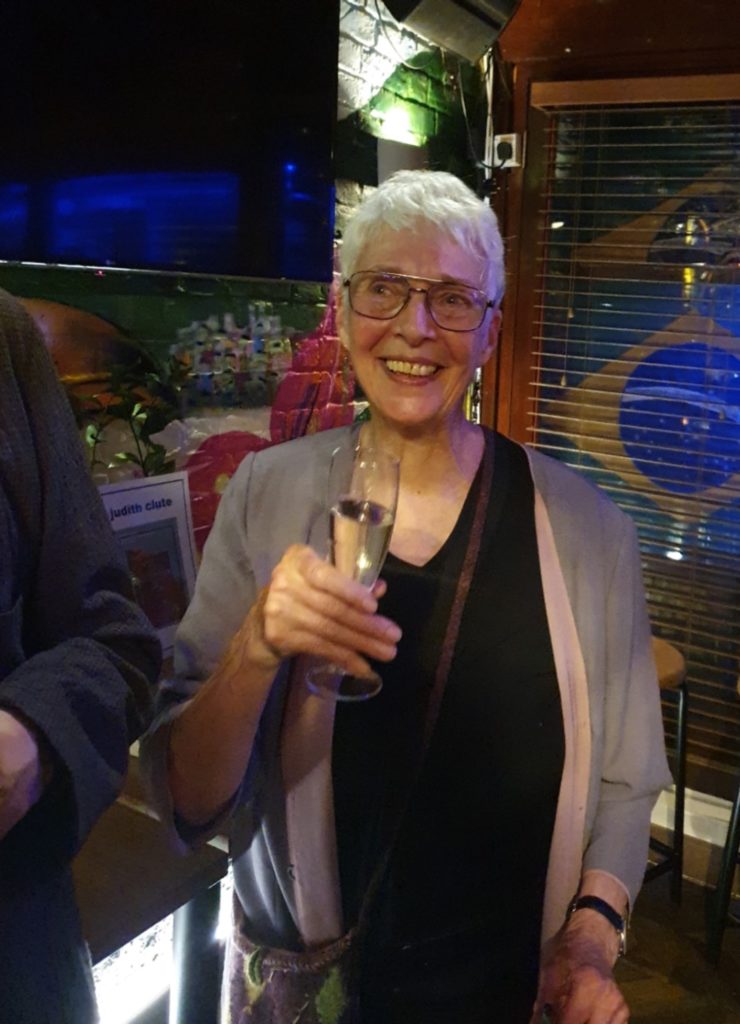
Judith with drink
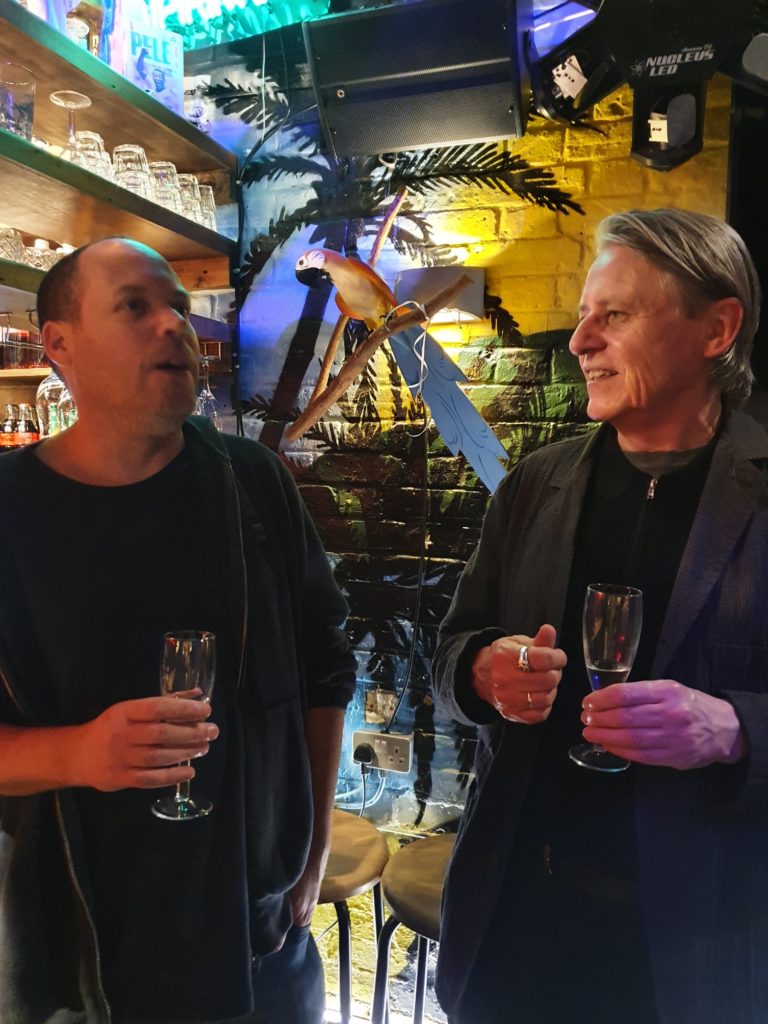
Lavie Tidhar and Paul McAuley
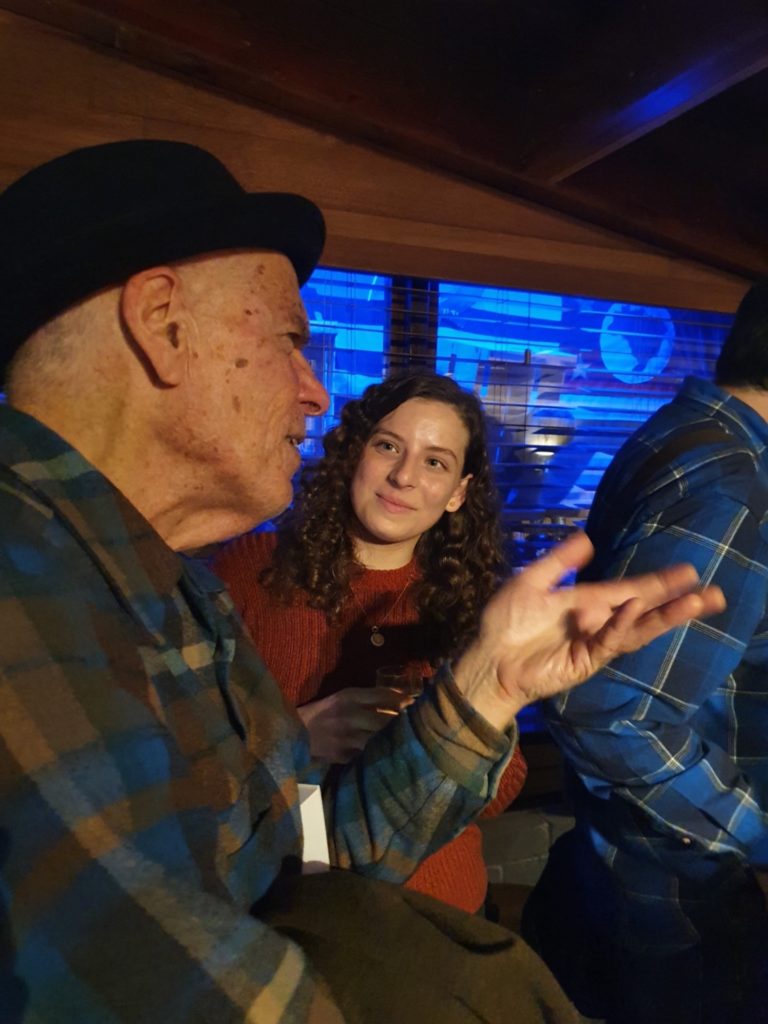
Woody Haut and Emjay Ameringen
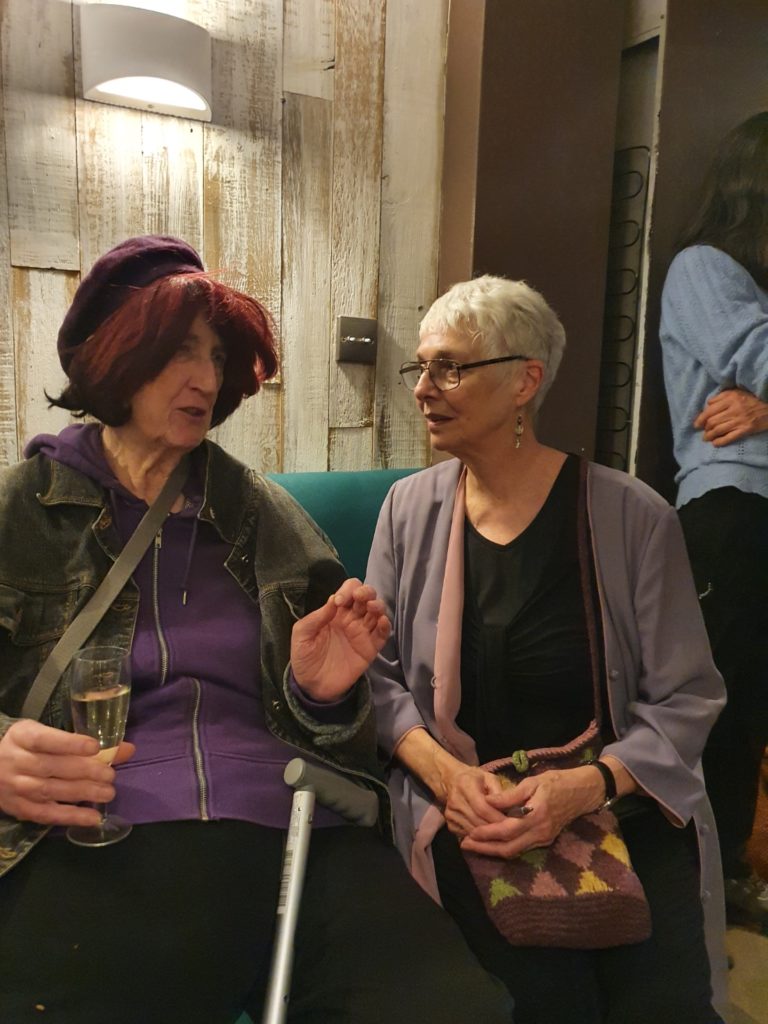
Roz Kaveney and Judith Clute
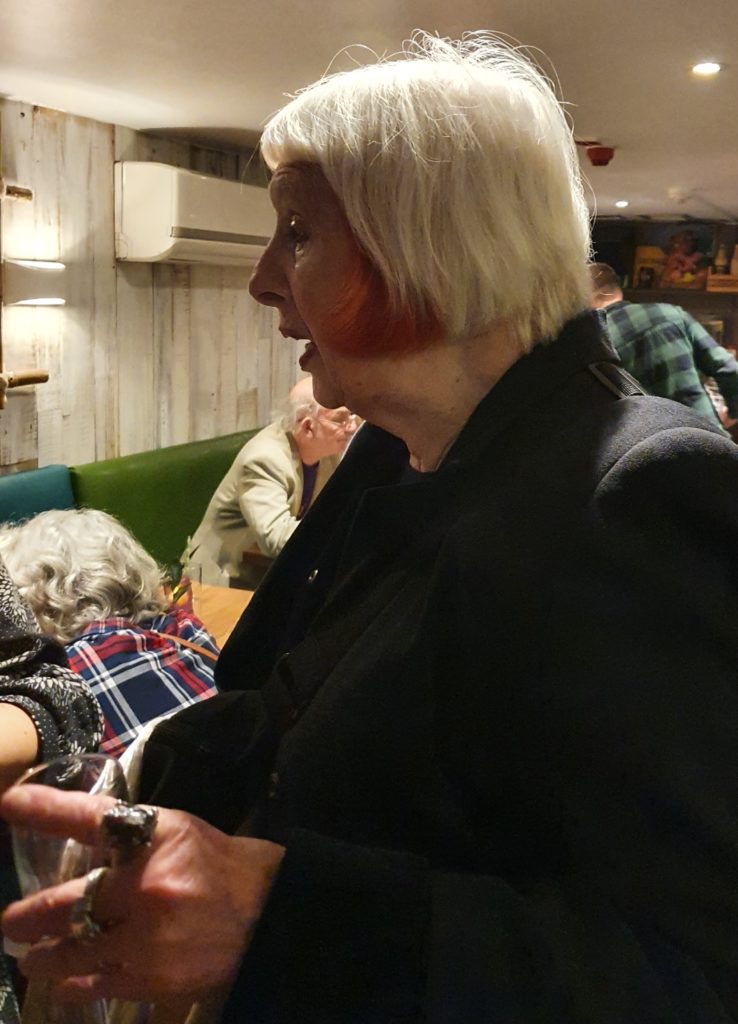
Marcelle Hanselaar

John Urling Clark and Adrian Munsey
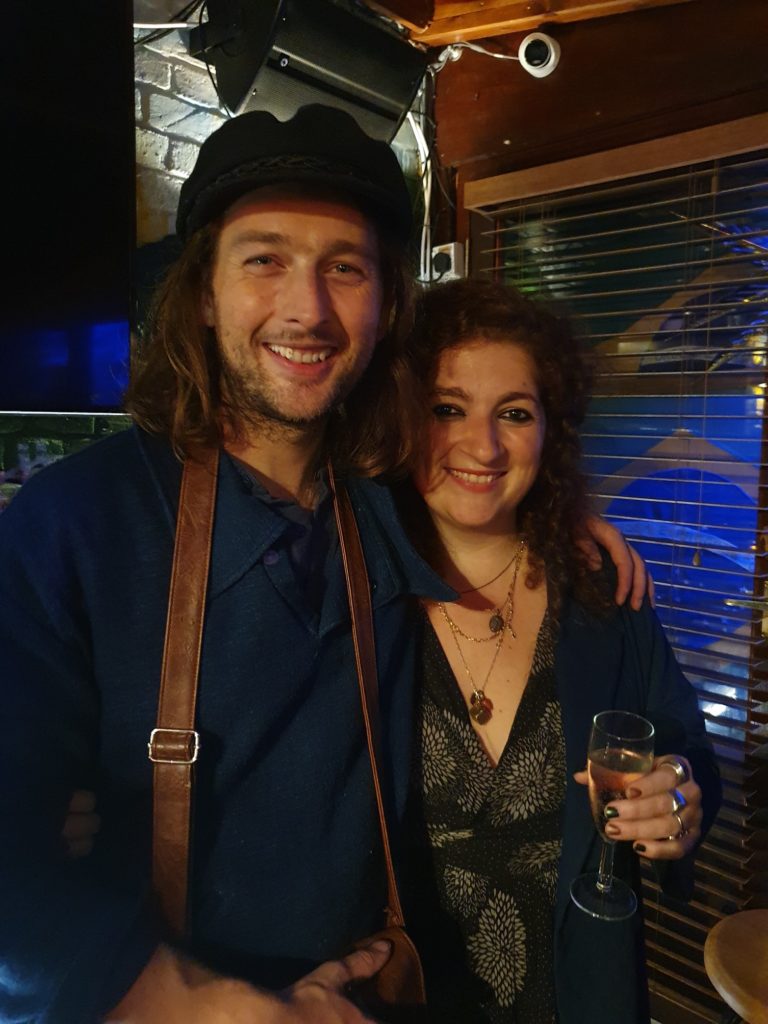
Mikey Kirkpatrick & Chiara Ambrosio
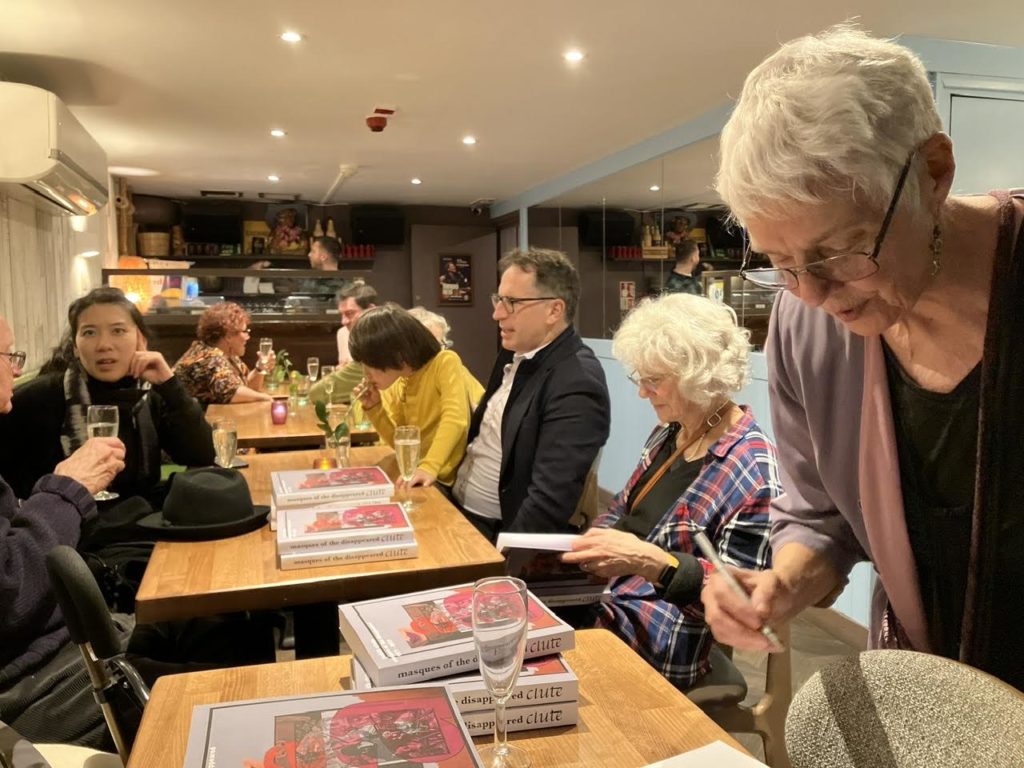
Judith in foreground inscribing a purchased copy, with James and Julia sitting opposite each other, and then Amber and Jason and their son, Asa, and in the distance, Tanya and Tony.
11 September 2023
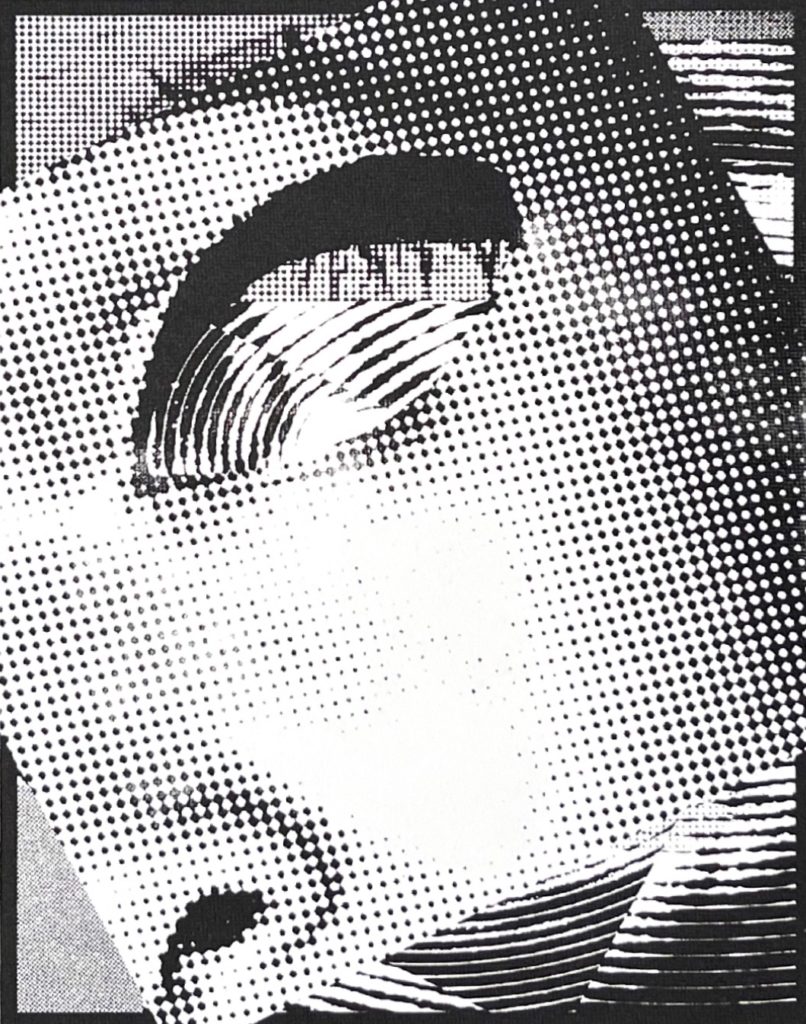
This image will be the back of the book that will soon be published about my paintings and prints, Masques of the Disappeared. The title of this silkscreen is Aesop Face.
28 August 2023

Sometimes my image doesn’t need to be rectangular. Usually it is, but here we see a silkscreen design with a sharp diagonal presiding on its Somerset paper. The title is The Harness.
17 July 2023
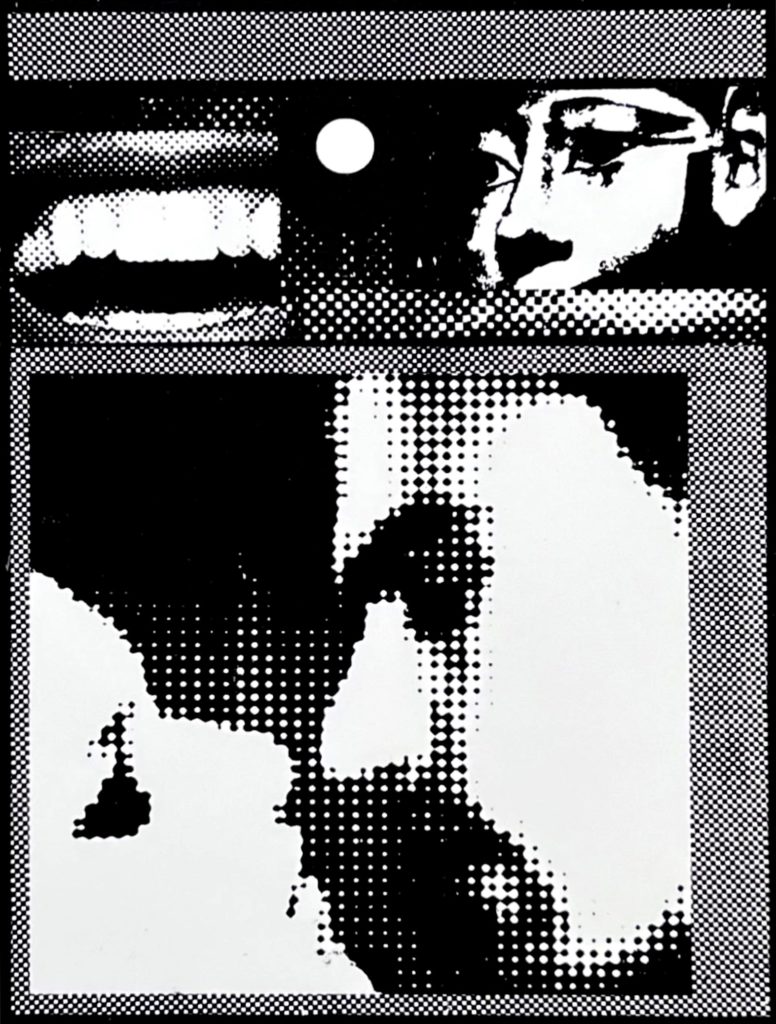
I’m still delighting in the way dots and textures can set themselves up in the making of a silkscreen print. This one is titled: Love Bite.
30 March 2023
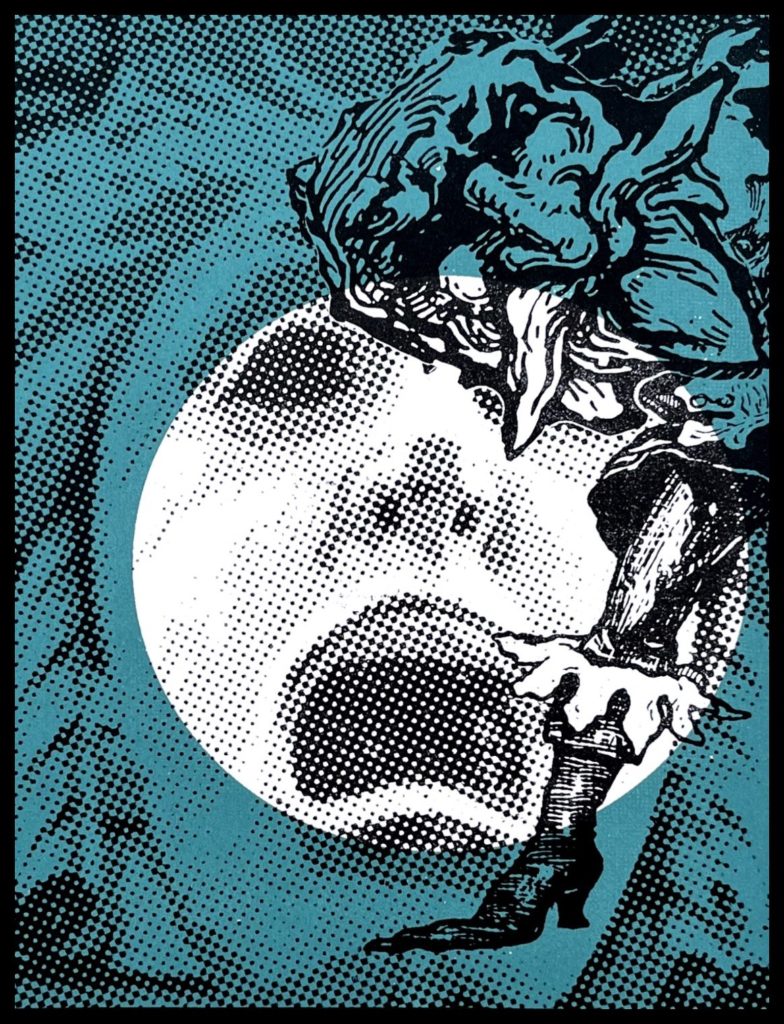
My silkscreen prints are getting scary. Here’s: Try this on for size.
24 March 2023
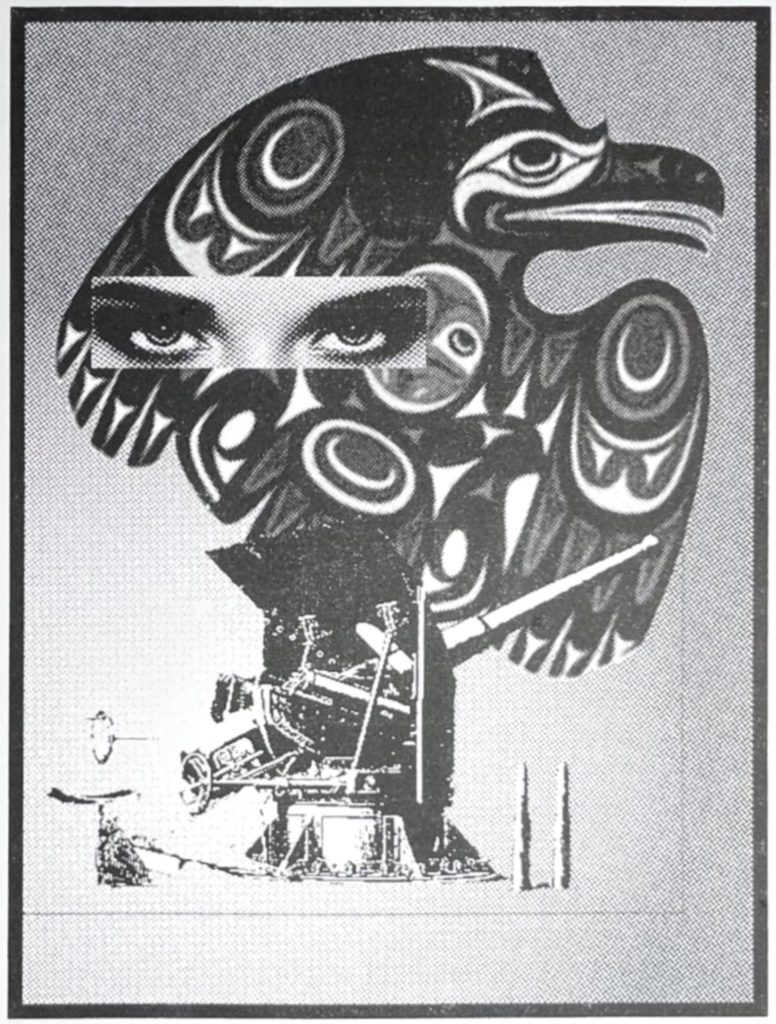
The latest silkscreen print has a good title: Disabused.
11 March 2023
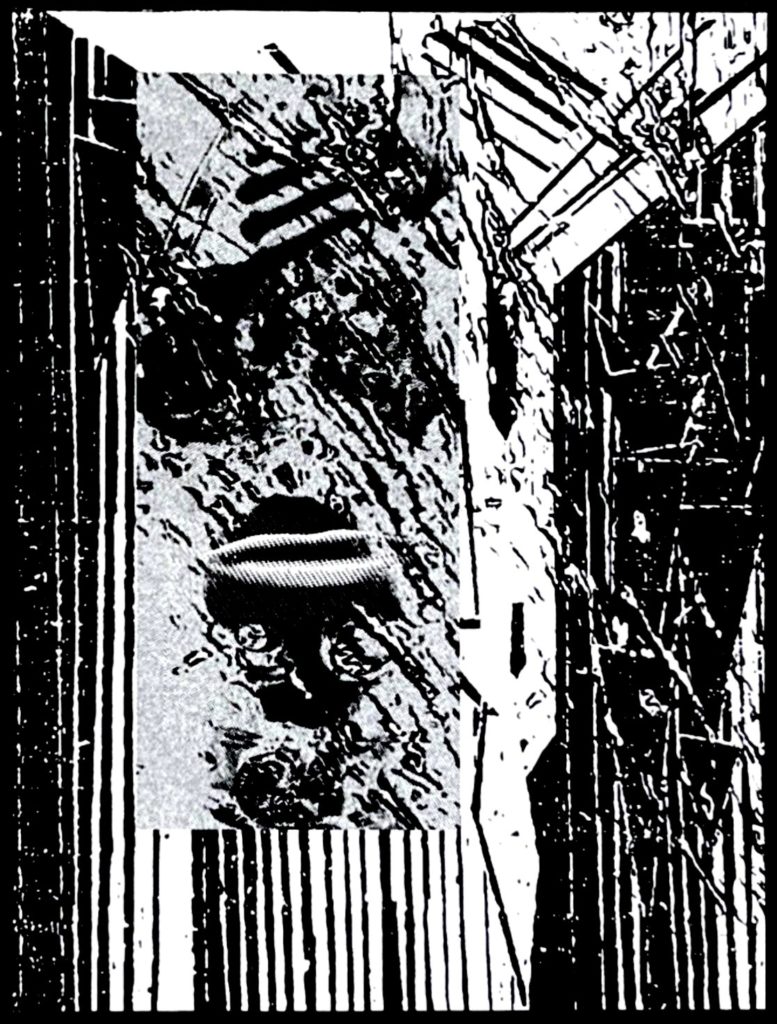
Pardon this Intrusion. The title of this silkscreen print makes reference to the first words of the Frankenstein “Monster” in Mary Shelley’s 1818 novel. John Clute titled his 2011 book: Pardon this Intrusion: Fantastika in the World Storm. (On page 11 John Clute says: “I like to think of this sentence as the literal beginning of Fantastika, because it sounds an alarum of change: it proclaims the power of a tabula rasa to inform us that the Emperor has no clothes..) The printing paper is Somerset Satin 300gm. It is the same weight as the others but because it has a smooth, satiny surface it seems slightly thinner.
20 February 2023
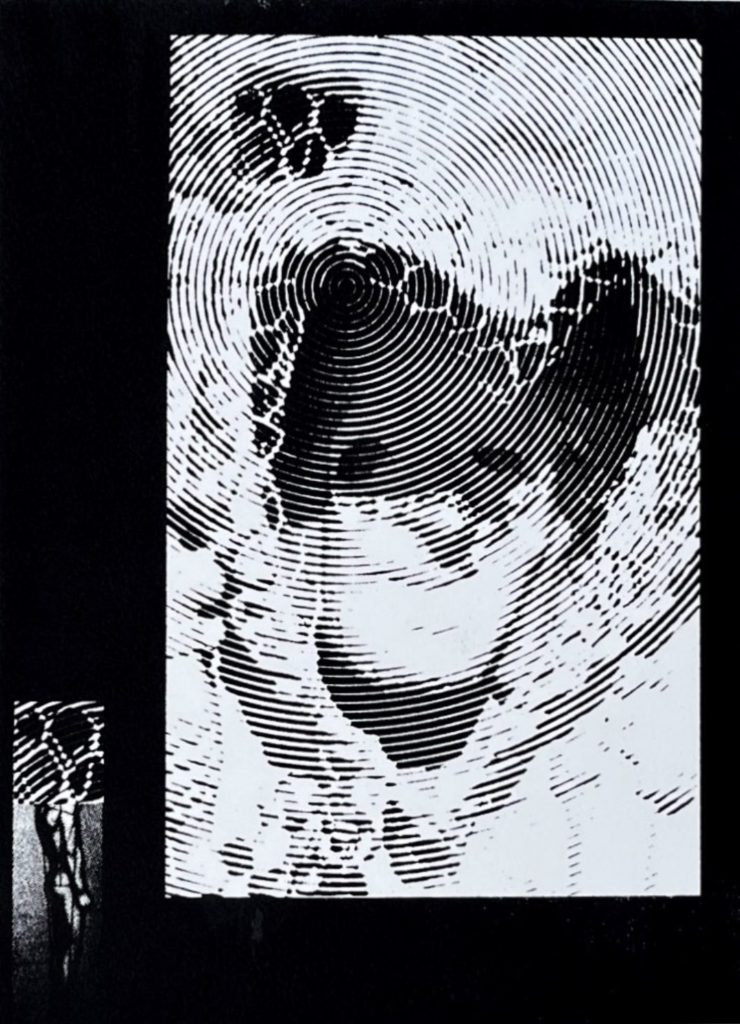
There have been several more recent additions to the print portfolio: Masques of the Disappeared, and this is the latest: Troupers. The portfolio now contains over 60 editioned silkscreen prints, all on Somerset paper 382 x 285 mm. Many are on an off white almost cream tone but this is on a standard Somerset textured white.
11 January 2023
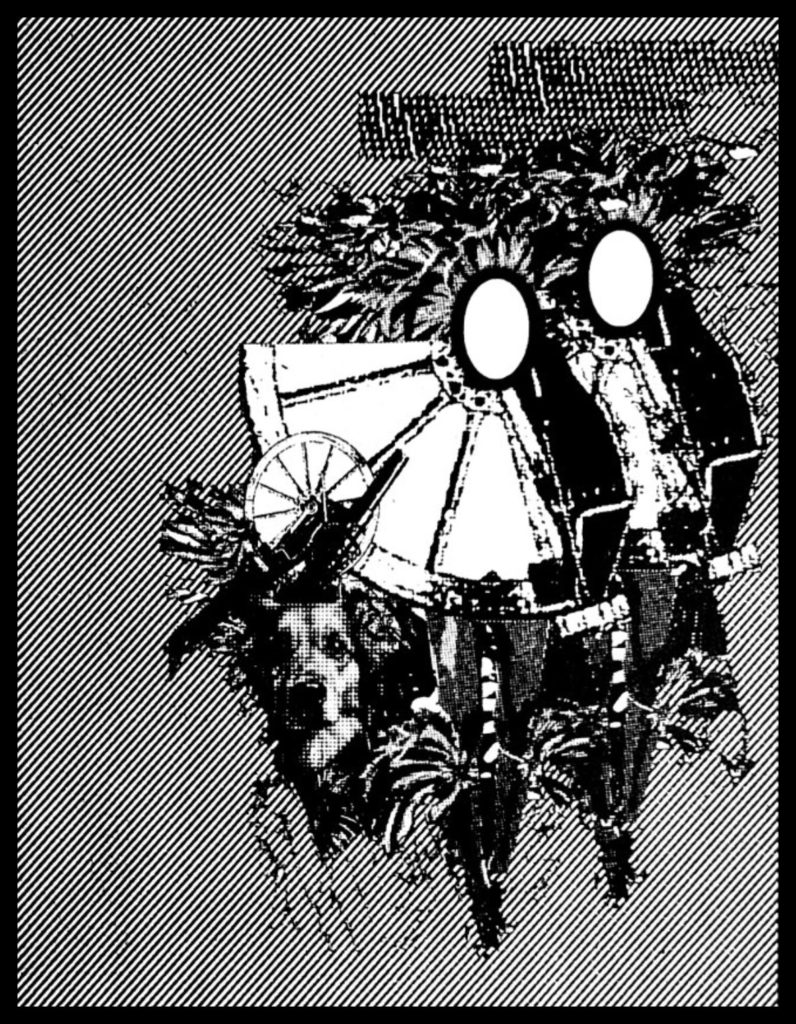
The above silkscreen print is titled A boy and his dog. It makes reference to the science fiction film in 1975 set in a scary future: 2024. It was titled: A Boy and His Dog. .. Also to mention that I have been making it now easier when people want to buy from me. The site is now laid out so, for instance, you can find in the menu: paintings for sale. And I have adjusted various things to work better on phones.
20 December 2022
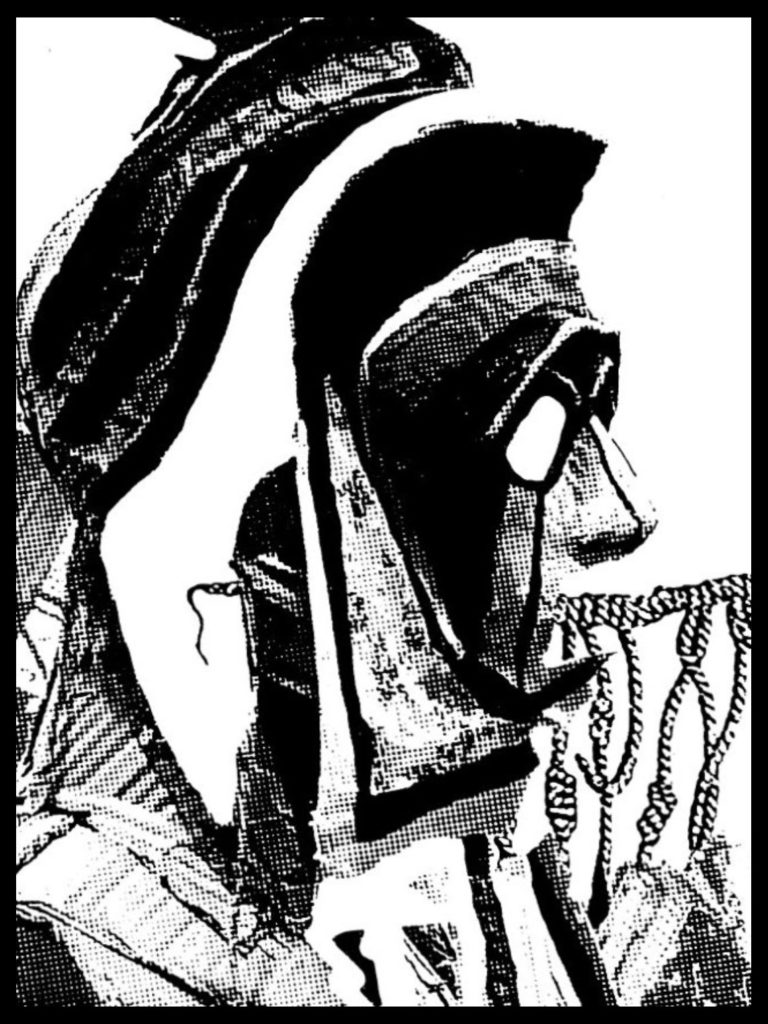
The above silkscreen print is titled Sticking to the end. There are elements in it that have been inspired by Hew Locke. Again. I hope there will be more and more of his work seeping into mine. Meanwhile John Clute looked at this print and, as he gave it its title, said that he would have liked this for the cover of his book, Sticking To The End Beccon Publications 2022. That wish is, of course, past subjunctive. In fact it already has a perfectly good Judith Clute cover which you can see in the book covers section of this site.
3 November 2022
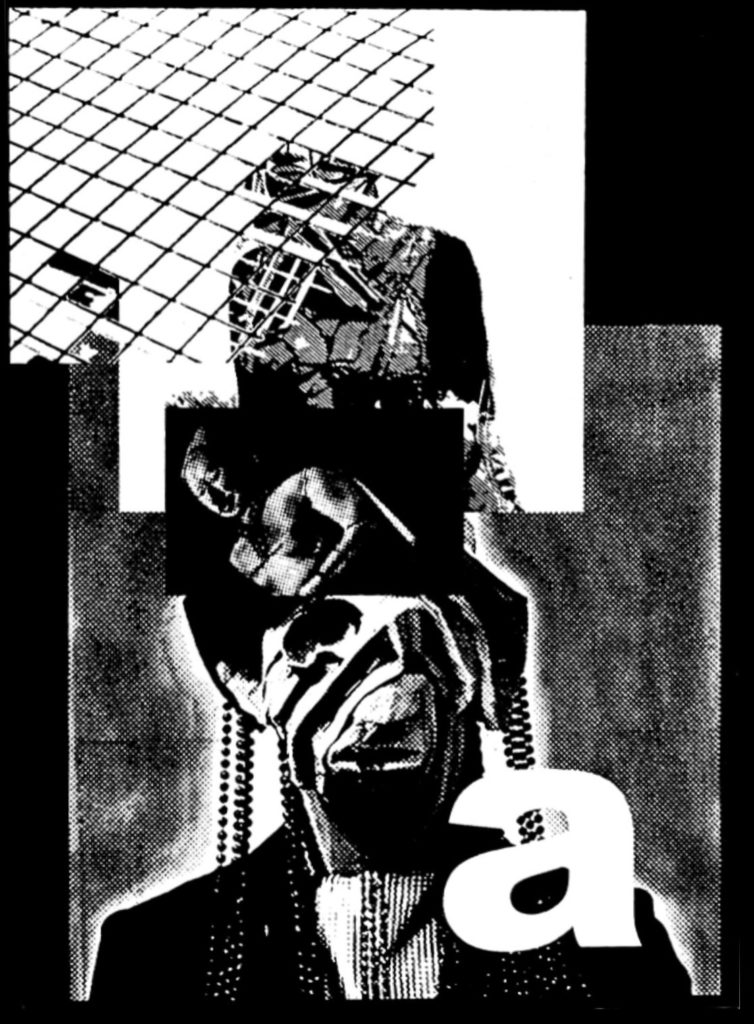
The above is my latest silkscreen print, The tonnage of a song. It’s one of several to make reference to Hew Locke’s Procession. Locke was made uncomfortable by the Tate’s rewriting of their past when they insisted that they had nothing to do with the legacy of the slave trade in sugar. He demonstrates his discomfort in many ways throughout the throng of his procession in the Duveen Gallery. Here in my silkscreen print I’ve isolated one of his characters. He is damaged but still standing, and I have placed, on his brow, a character from one of my paintings, Manger 1997.
28 January 2022
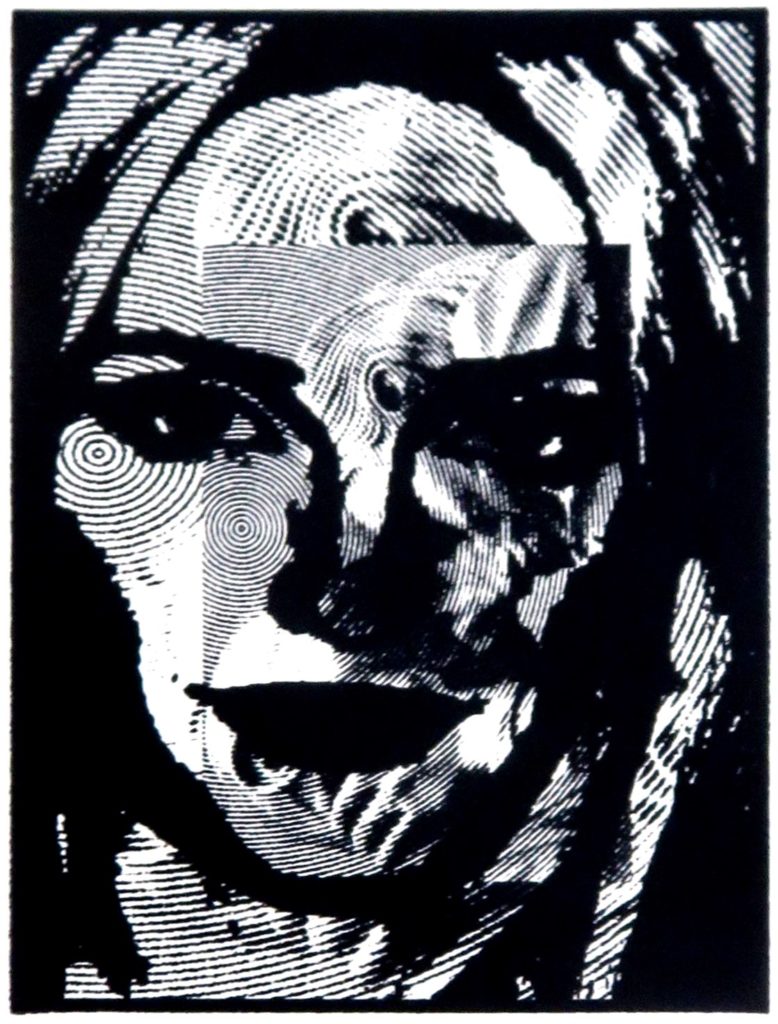
This silkscreen print (image size: 236 x 176 mm) is titled, Mach and so recalls Mach numbers and supersonic sound.
10 December 2021

In C.K. Williams’ poem To Listen, page 85 from A Dream of Mind 1992, the first line goes like this: “In the dream of death where I listen, the voices of the dream keep diminishing, fading away.” The above silkscreen print attempts to reflect some of the movement of this poem. To Listen.
1 December 2021
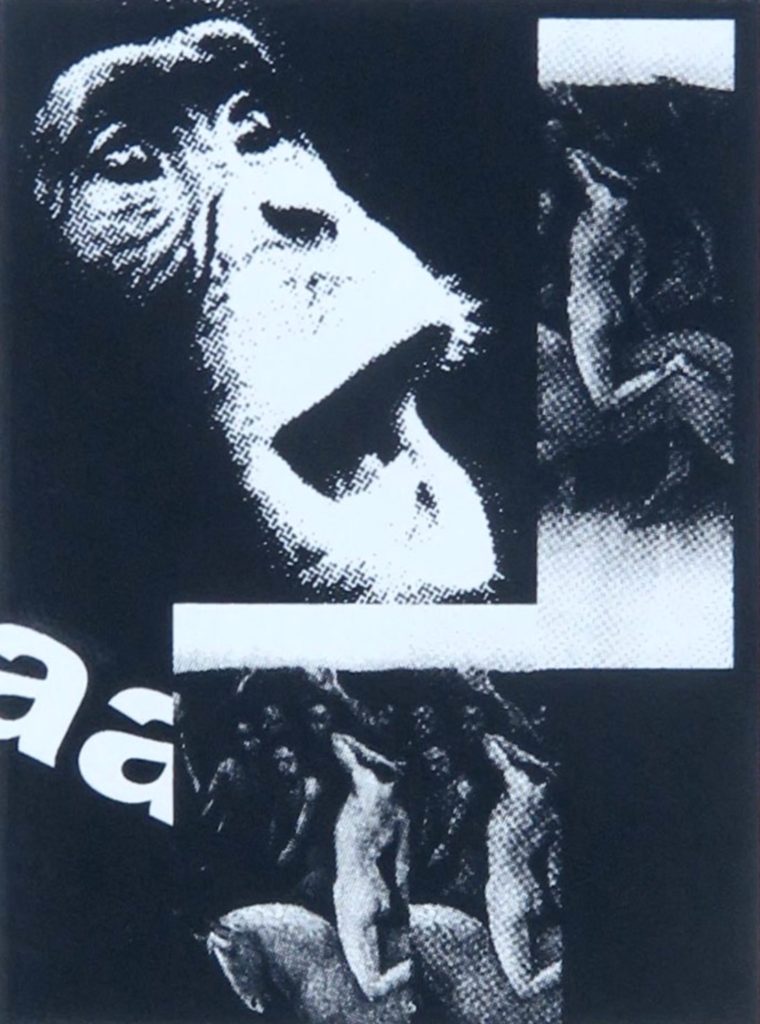
There have been several new silkscreen prints, but here is the latest: The Shock of the New. Same size as all the others in this Masques of the Disappeared portfolio.
7 October 2021
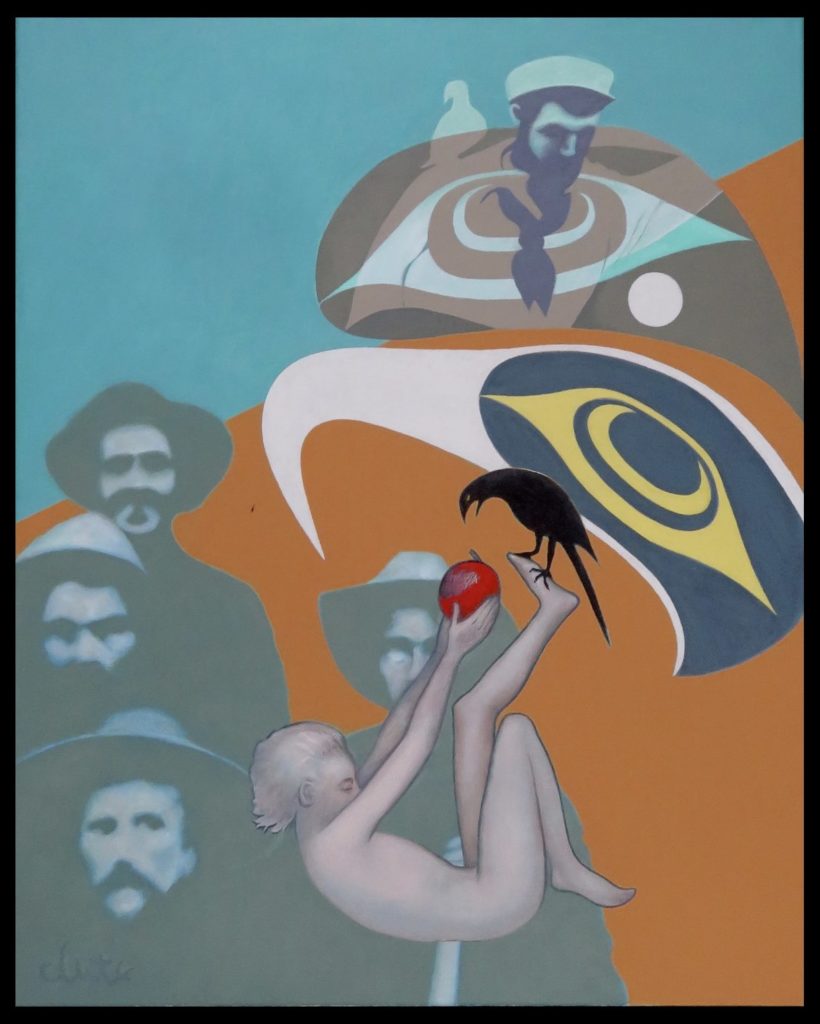
Here is the latest painting, entitled Thirteen Ways. Size: 780 x 625 mm.
19 September 2021
More news from the past. Looking for old images of me, Judith Clute, in an exhibition context. In the April 2003 issue of Interzone there’s an article, “Still turning motifs upside down: Judith Clute interviewed by Paul Brazier.” Illustrating the text are two photographs of me that Paul Brazier had taken at the exhibition and launch party for my first website in 2001. In one I’m with Mike Harrison and Cath Phillips. In the other I’m with John Clute. Also the lead-in image to the article is a small self portrait I had painted somewhat earlier. And note that Paul Brazier had posed me with Mike and Cath in front of the painting entitled “Miniscus”, the same painting he then used in his design for the cover of that April 2003 issue of Interzone.
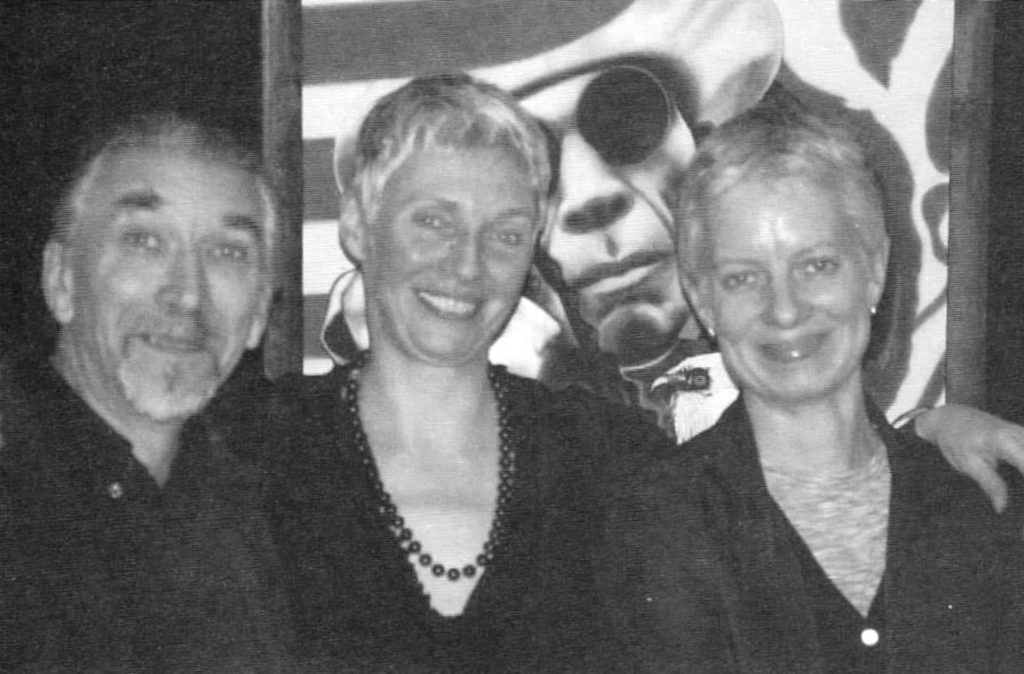
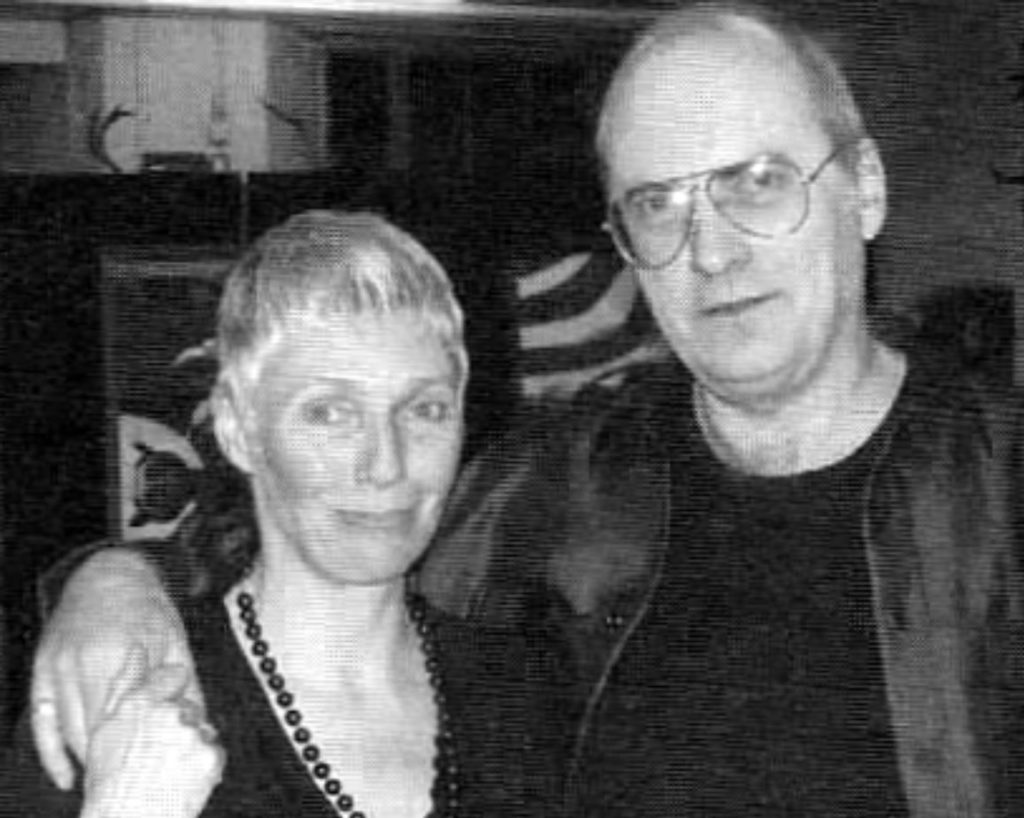
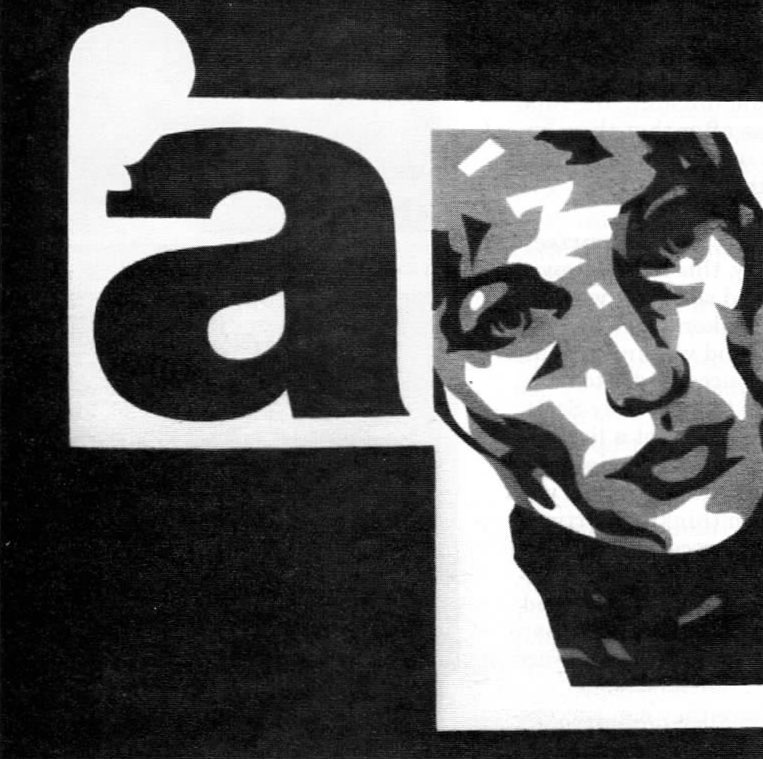
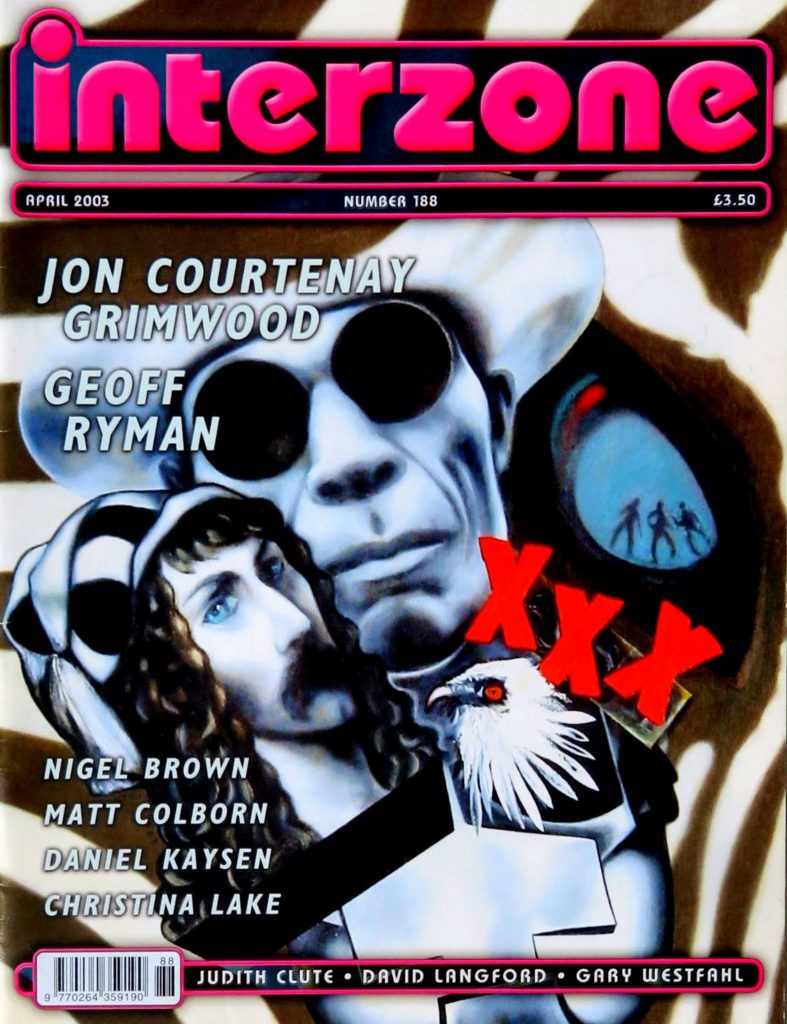
30 August 2021
David Curtis has brought out an amazing book that captures a transient moment from the past: London Arts Labs and the 60’s Avant–Garde 2020. He worked on it after our arts lab continuum exhibition in 2018.
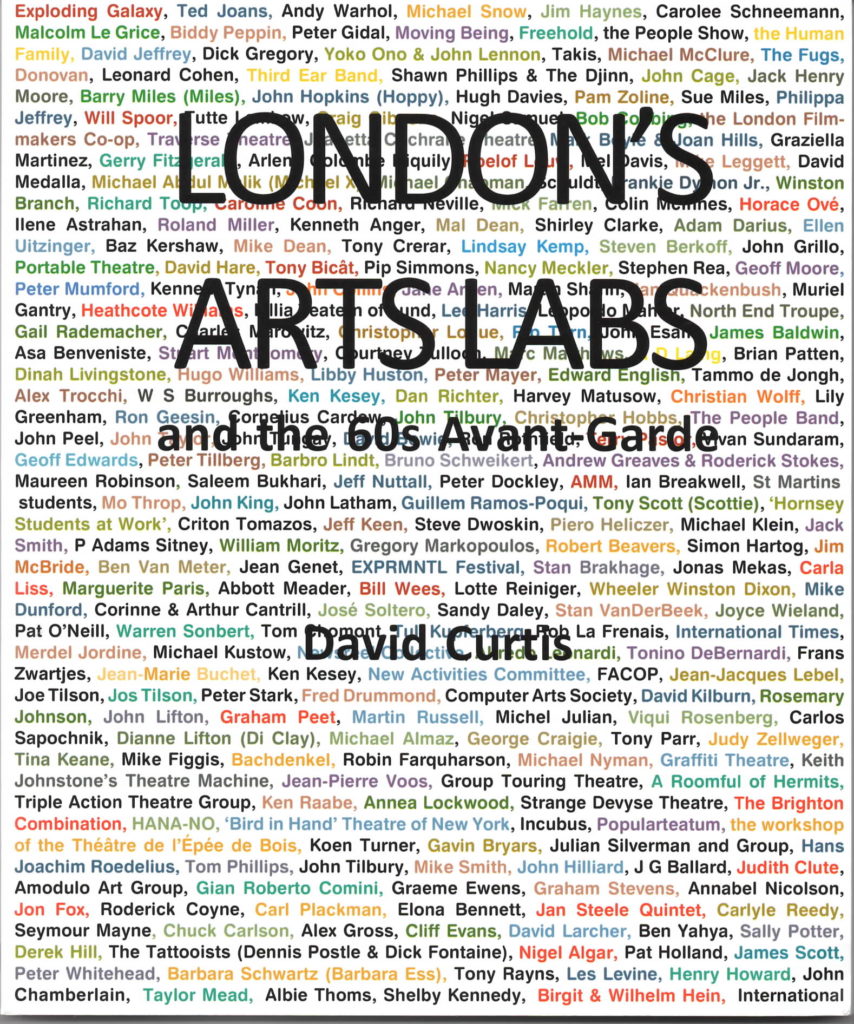
Below are words from pages, 117, 118, where David Curtis displayed an original press release for the joint exhibition Pamela and I had in June 1970. John Clute has written it and here’s the bit that relates to my part of the show. Note that it follows Pamela Zoline where she had said that “I want to make an art which takes on the whole world, like Time Magazine.. Grandiose, an impossible task, but even if it’s a failure, it’ll be as big as Texas”
Judith Clute: “I want to make an art that reflects Time Magazine and parts of the world with the deadpan eye of a child, but not the style”. Compared to conceptual statements, her precisely drawn diagrams of the intersections of data and things are introspective and self-contained. “I was a quiet child,” brown haired Clute, married to an unemployed forklift driver, concedes. But her paintings have a hard colourful edge, mount campaigns against easy reading, include references to Easter Island scripts, Austin A40’s, rabbits, geometries, spray-guns, clothespins, swans, forklift trucks. She reminisces about her apprenticeship with Pamela Zoline in the famed Vancouver based Stegeman/André studio in 1961, where she was first stimulated by the then unknown Canadian masseur Marshall McLuhan. “Making it has always been a challenge,” she claimed, “as the world is full of likenesses and is very big. It’s about as big as Texas,’ she finalized.
So the participants in this 1970 exhibition at the New Arts Lab were having fun with their stories. Note that the unemployed forklift truck driver was John Clute who at the time was busy in his connection with Michael Moorcock and New Worlds.
From this 2021 vantage point I’d say that to describe Judith Clute’s paintings as mounting “campaigns against easy reading” chimes perfectly with my current intentions. Right on, young John Clute!
15 August 2021
Here’s the image of my latest silkscreen print. It is titled: The Globe fool.I had found a picture of the very skull, the very prop, used by the Globe theatre for the Hamlet scene: “..Alas, poor Yorick!”. And I played around technically to make it work for me. To find, and adjust and then voila: present! That is making art.
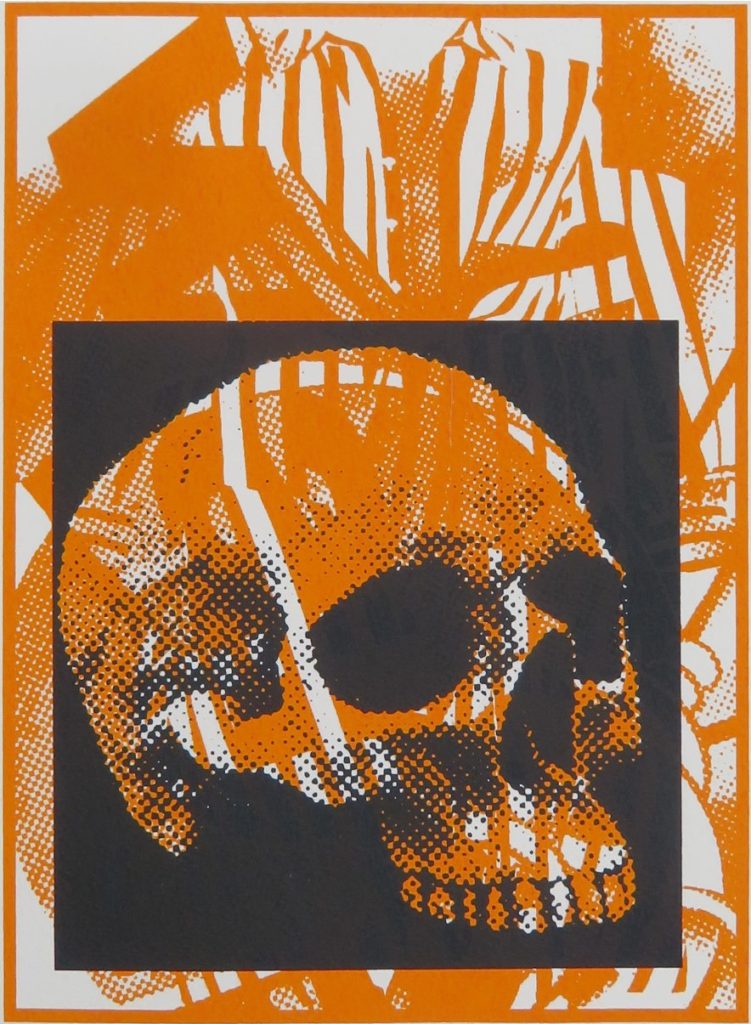
29 July 2021
Latest silkscreen. Beauty here walked, words pulled out of Nancy Cunard’s poem, Parallax, her complex response to T.S..Eliot’s The Waste Land. (She is depicted at the base of the composition).
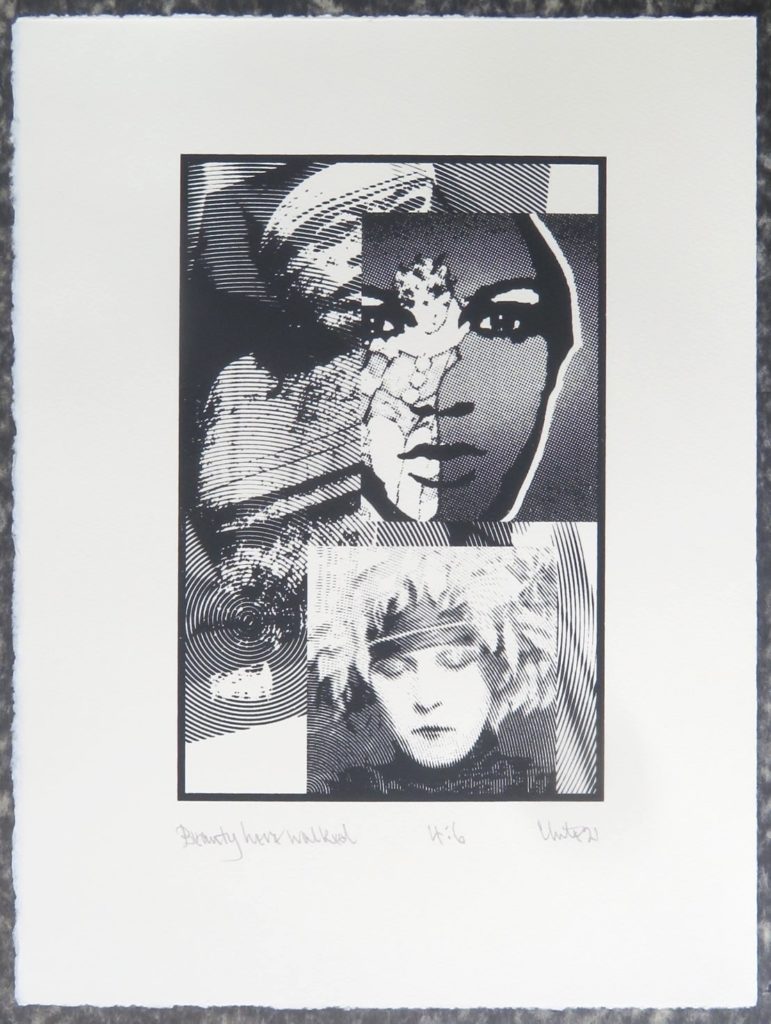
15 July 2021
Recent new silkscreen prints are found in prints on Somerset Paper. They are being made with speed – four since the last one mentioned below – but my slowness in making an oil painting is marked by the fact that I’ve taken just about a full year to finally finish this painting: In the Bardo. It is not the actual painting time. I’m actually quite swift in laying down the paint. It’s the decision making! I kept changing things. This painting is 780 x 530 mm.
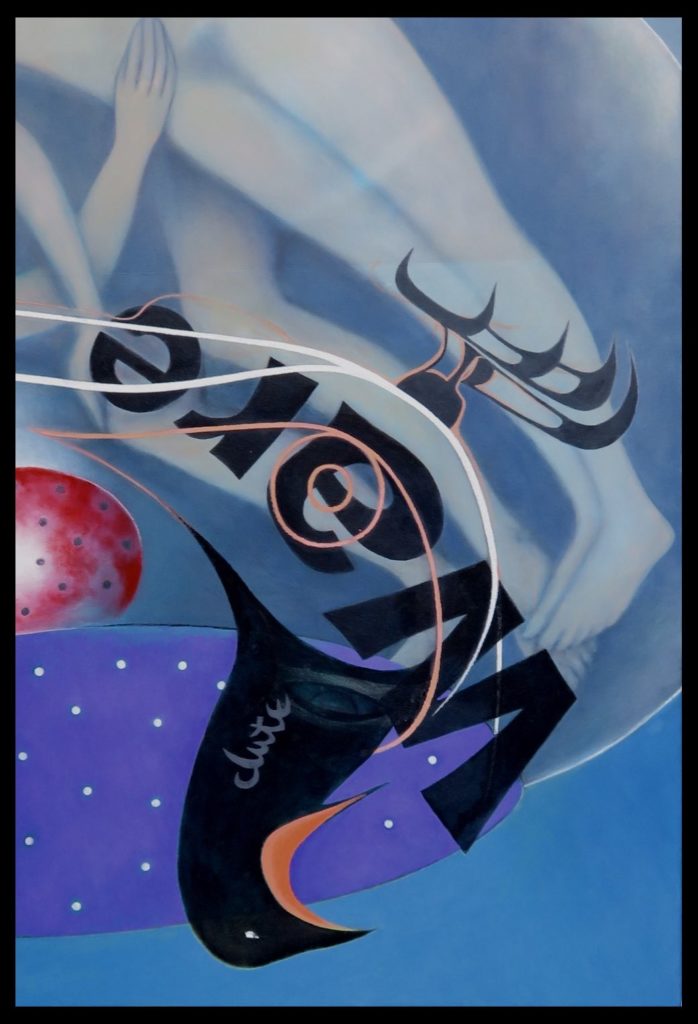
12 June 2021
Several new prints (four actually), the latest being East. For buying details look at the sections, prints on Somerset paper or shopping.

3 May 2021
The latest silkscreen print, Veni, Vidi. For buying details look at the sections, Prints on Somerset paper or shopping.
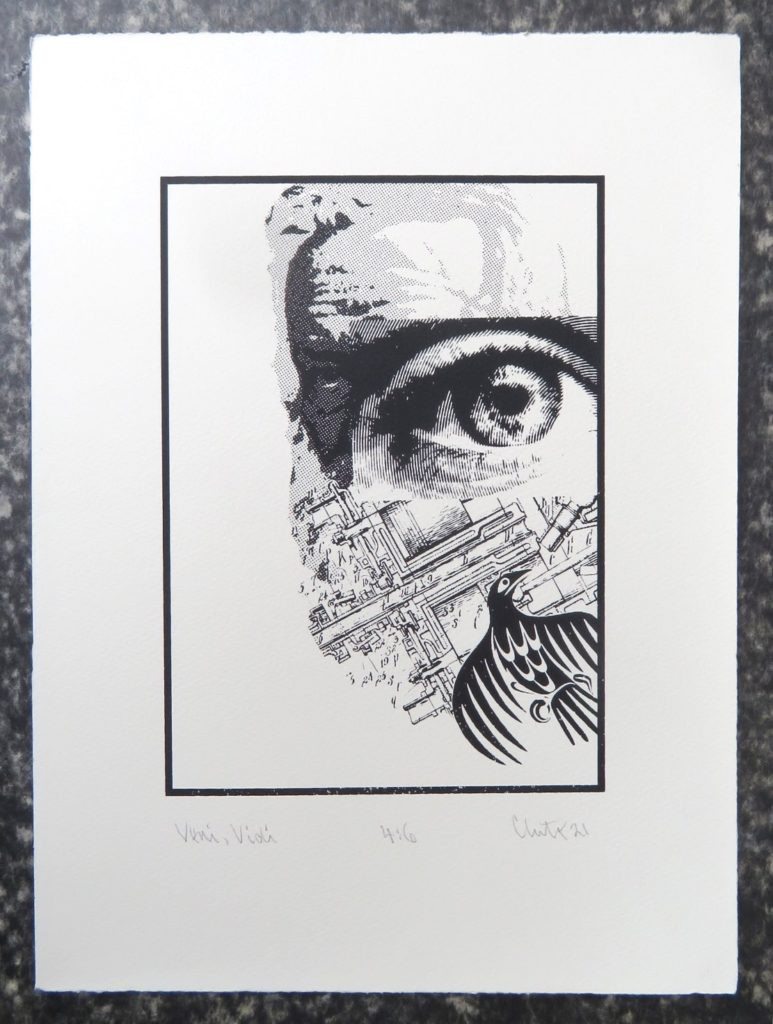
9 April 2021.
Masques of the Disappeared Print Portfolio, a growing list of titles: Penned. Self Told Story. Recovered Memory. Streaming. Salto Mortale. The Shootist. Rest Stop. Dress Rehearsal.. The Gate. Binned. Treading the Boards. The Imbroglio. Opossum. Canary. Thickening. Agitprop. Roman-à-clef four, Roman-à-clef one. For more details look at Prints on Somerset Paper.
4 April 2021
Here’s a notice for my silkscreen prints. They are all on Somerset printmaking paper 300gm which comes from St Cuthberts Mill, Wells Somerset. If you want to buy a print each costs £50 pounds. Just contact me. Note p&p is included. If you live in Europe the cost will be Euro 63. Elsewhere it is in dollars: USD 85. If you want several prints I’ll give a better shipping price. I wrap and post the prints myself. (framed is more complicated but contact me for options.)
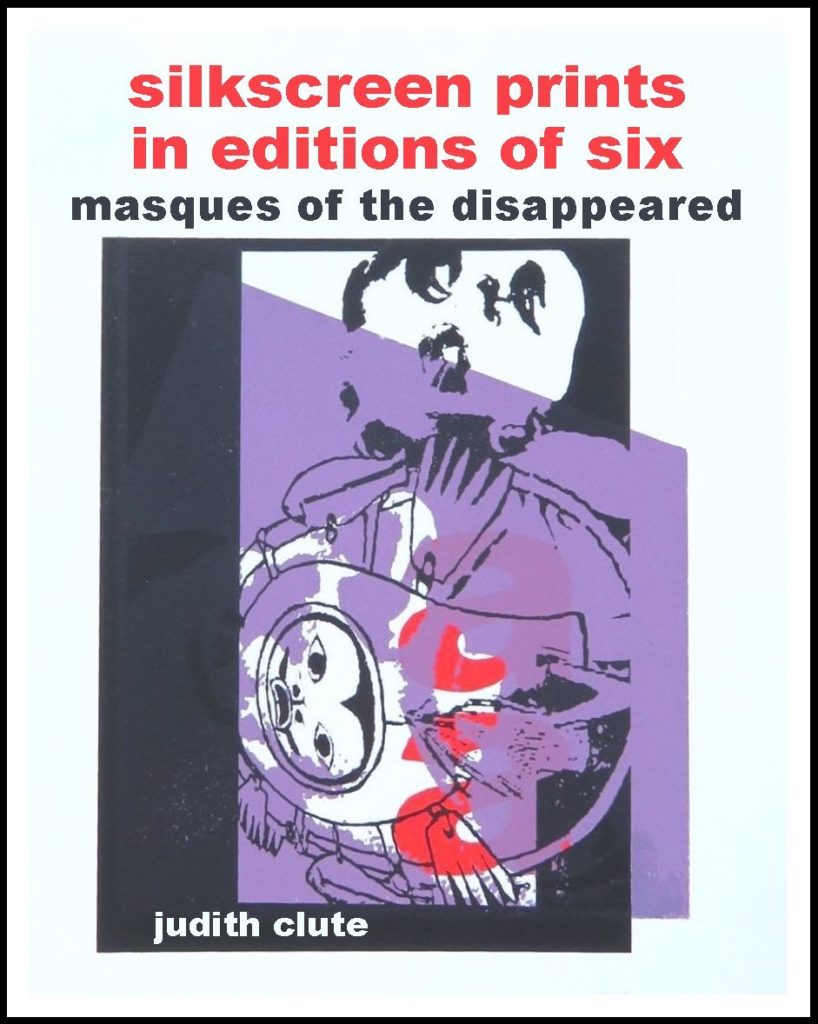
24 March 2021
Easing across town with care, I’ve been to Woolwich to get on with printing again and here’s the first limited edition print done this year for the masques of the disappeared series. It is titled self-told story.
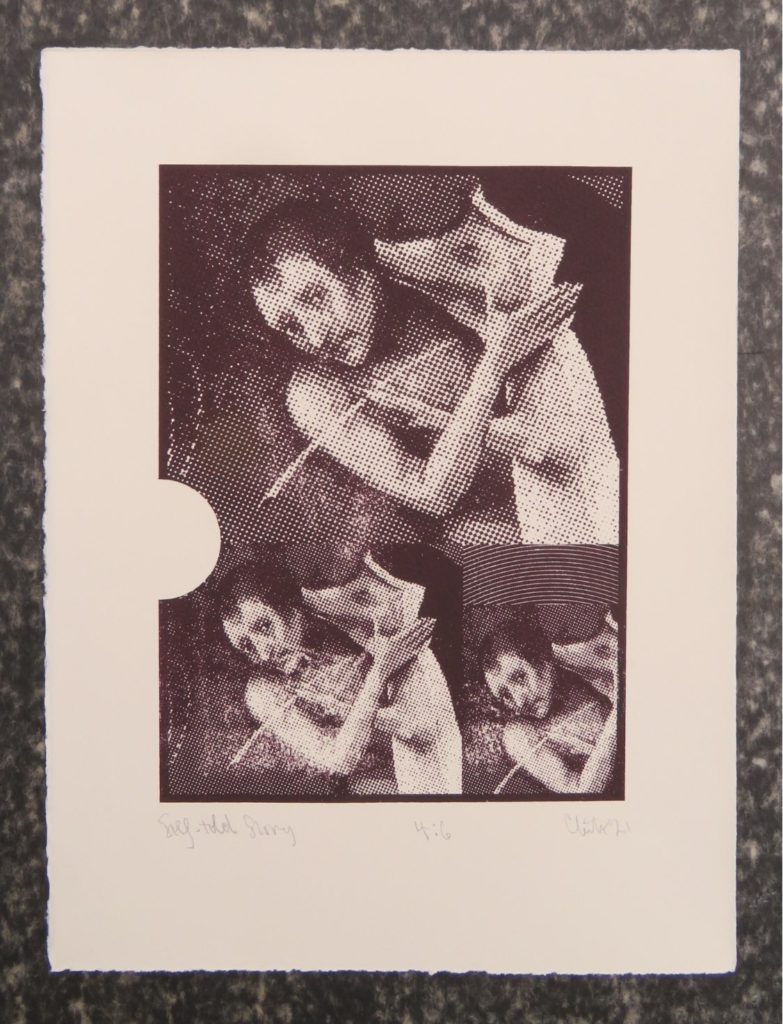
7 January 2021
Here’s an etching from time past (2018) but in this third serious lockdown, it seems right for our moment: Walk Lightly v2. Plate size, 205 x 108 mm. Somerset paper as with all the others but slightly smaller at 325 x 260 mm.
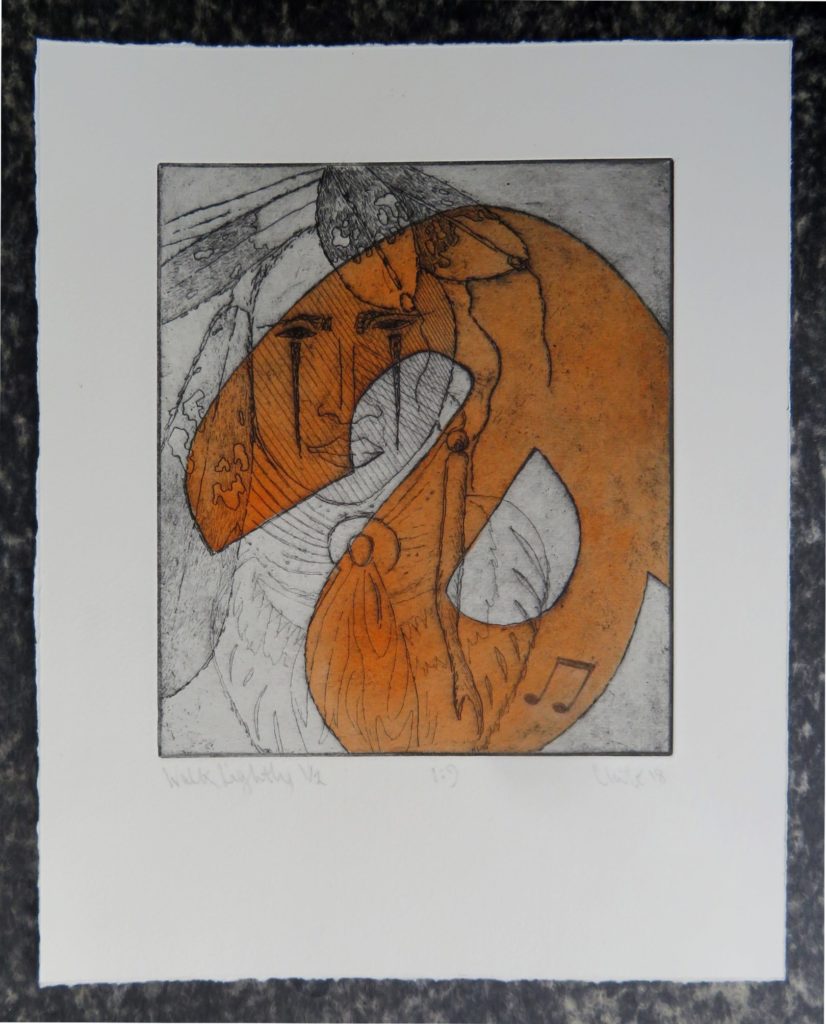
22 November 2020
With great care and abiding by the rules of the print workshop I’ve made another edition: Recovered Memory.

12 November 2020
“Letters from my friends” is a Chiara Ambrosio radio programme originally made in our first lockdown for Resonance 104.4 fm. I am one of the friends speaking. This two-part programme has been chosen for replay by Radiophrenia Glasgow and will be broadcast Friday 13, 9 am. (https://radiophrenia.scot)
7 November 2020
This is possibly the last silkscreen print I’ll be able to do for a while because of the current lockdown. I’m hoping, because the Thames-side Print Studio is fastidious is its cleanliness and face covering rules, that I’ll still work there in this month of November, but we’ll see. Meanwhile here is Streaming.
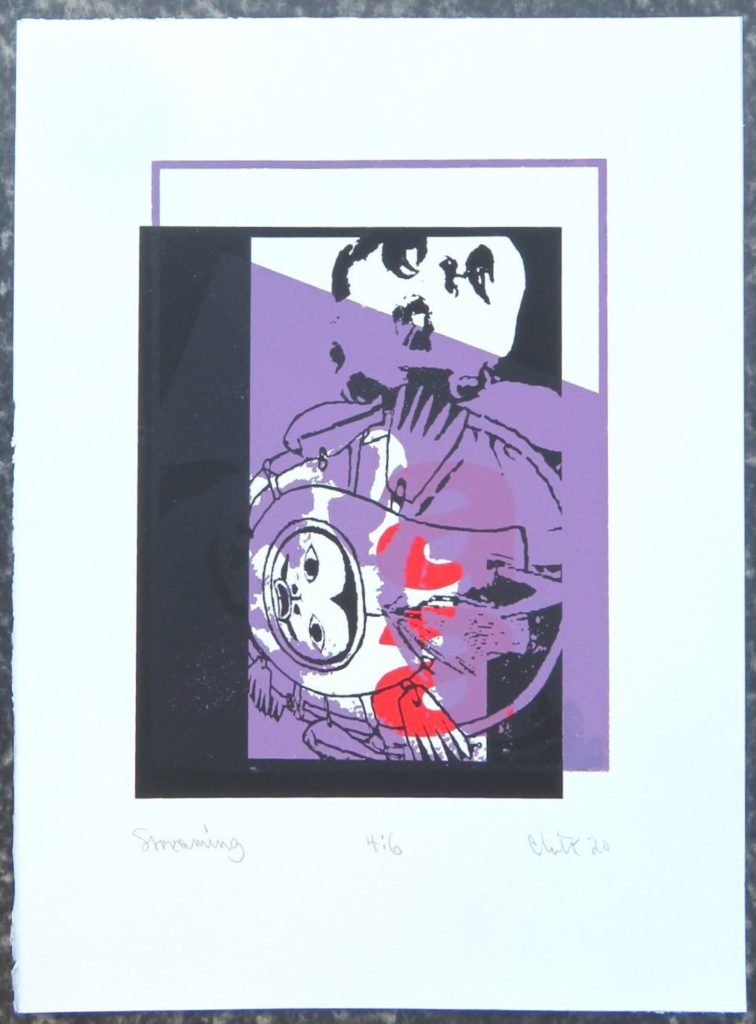
29 October 2020
Back in early March this year, just before lockdown, I made my first silkscreen print. It was titled a Modest Proposal and was printed on cartridge paper, a surface rather slick, a surface which seems to give nothing back to the image. (Subsequently I always use Somerset.) Here is that first image printed on heavy Somerset, totally reworked and now titled: Salto Mortale.
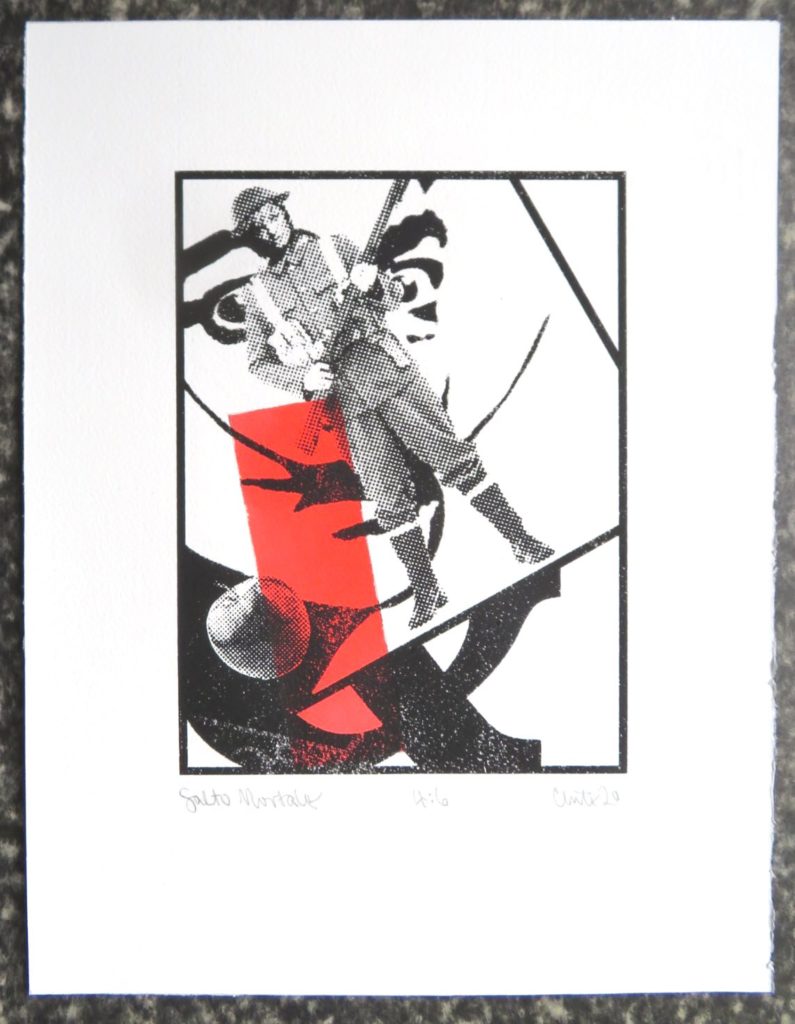
22 October 2020
My recent work, over a dozen silkscreen prints so far, is building to be episodes in an ongoing Masques of the Disappeared suite. Here is Opossum.
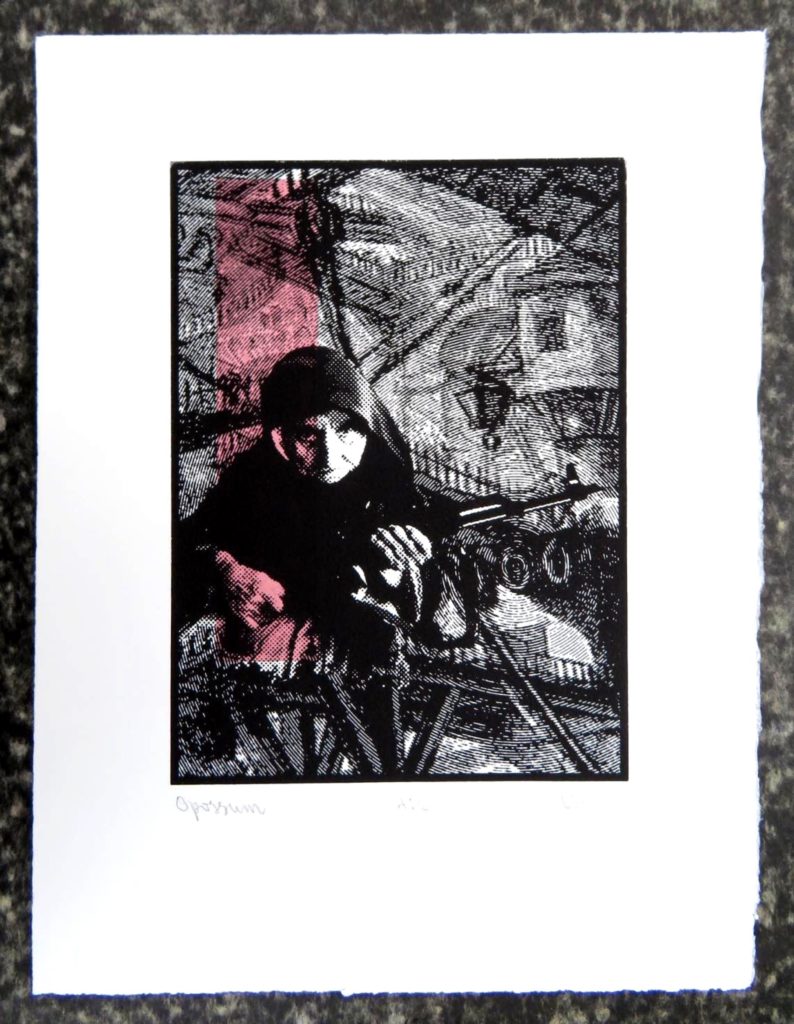
16 October 2020
Another silkscreen print made in Woolwich: Rest Stop.
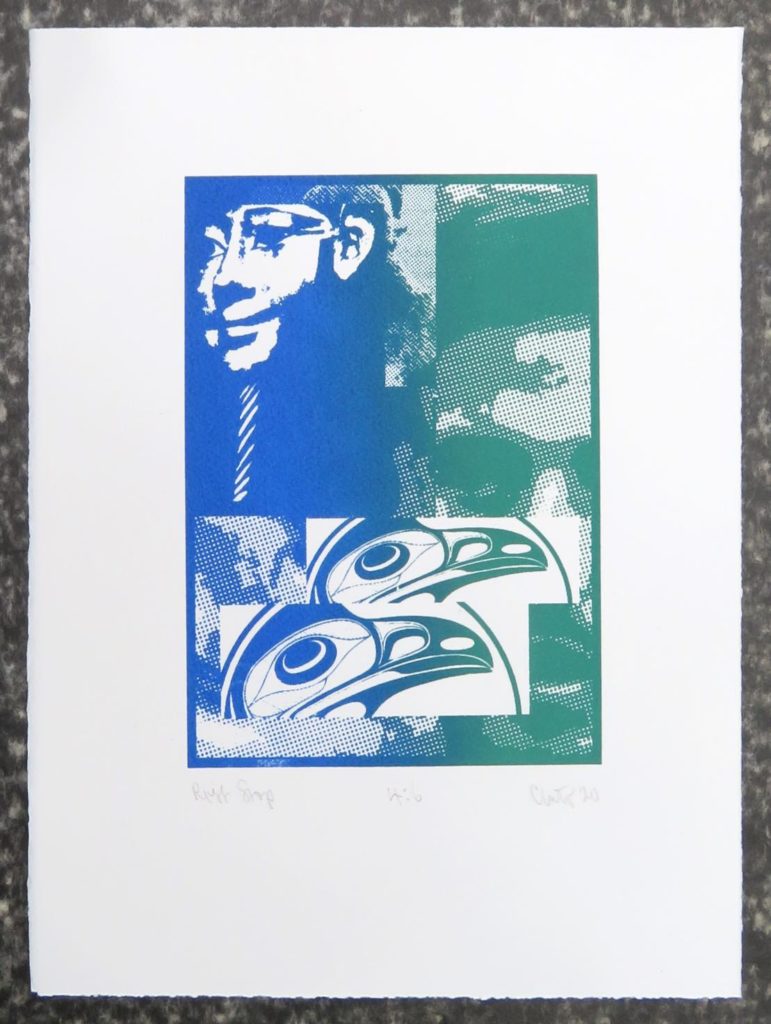
11 October 2020
If you look in “Prints on Somerset Paper” you will see that several more prints have appeared since Canary. Here is Dress Rehearsal. Like the others it is in an edition of 6 and sells for £50 unframed. It is 380 x 280 mm.
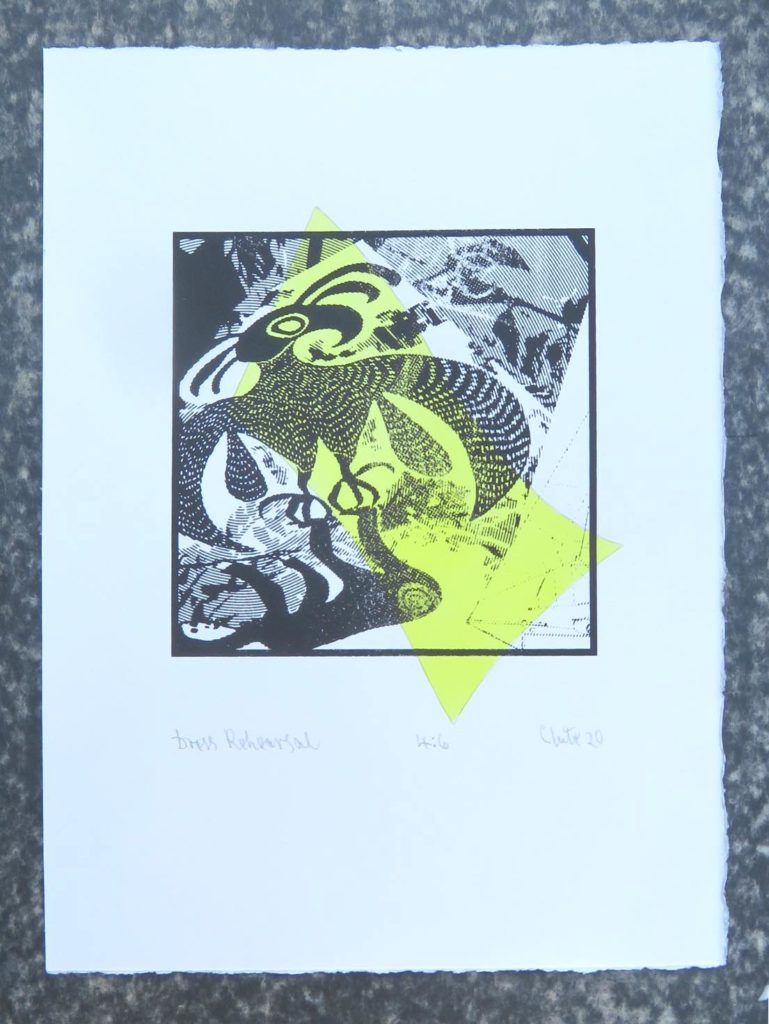
27 August 2020
We ease out of August and I set in here another silkscreen print. It is entitled Canary and I think of the warning Bill McKibbon has set out: “The testing of our species has only just begun”.
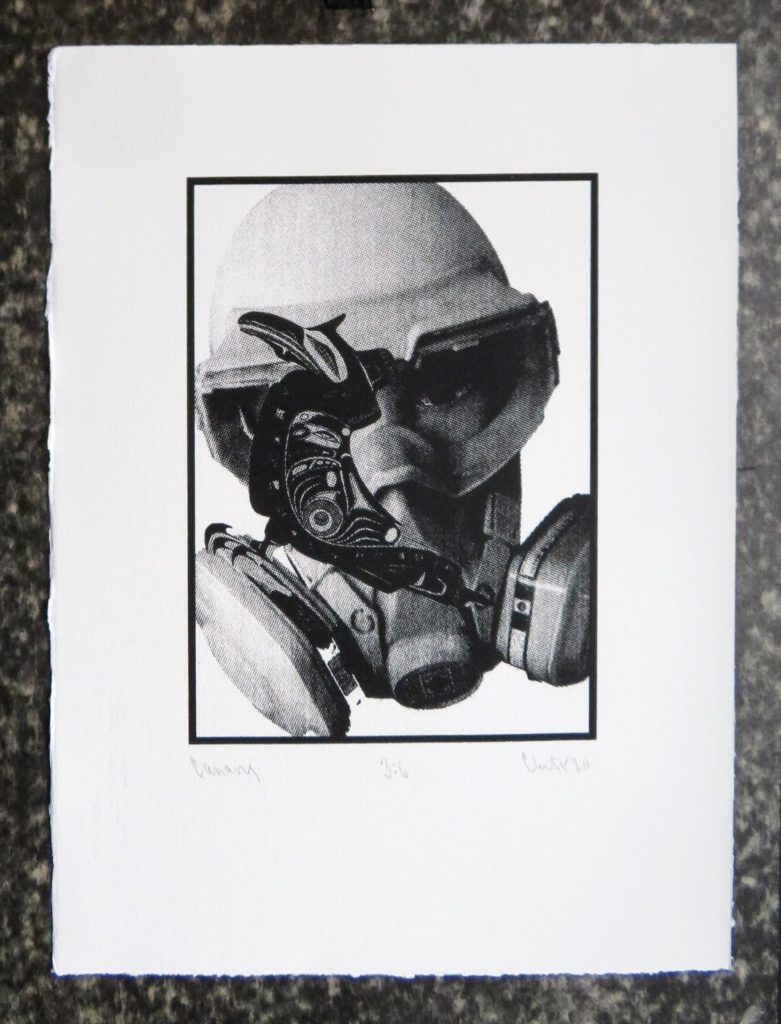
13 August 2020
Yesterday at the screen printing studio I made another print on the usual Somerset paper in an edition of six: Agitprop. Paper size, 380 x 280 mm.
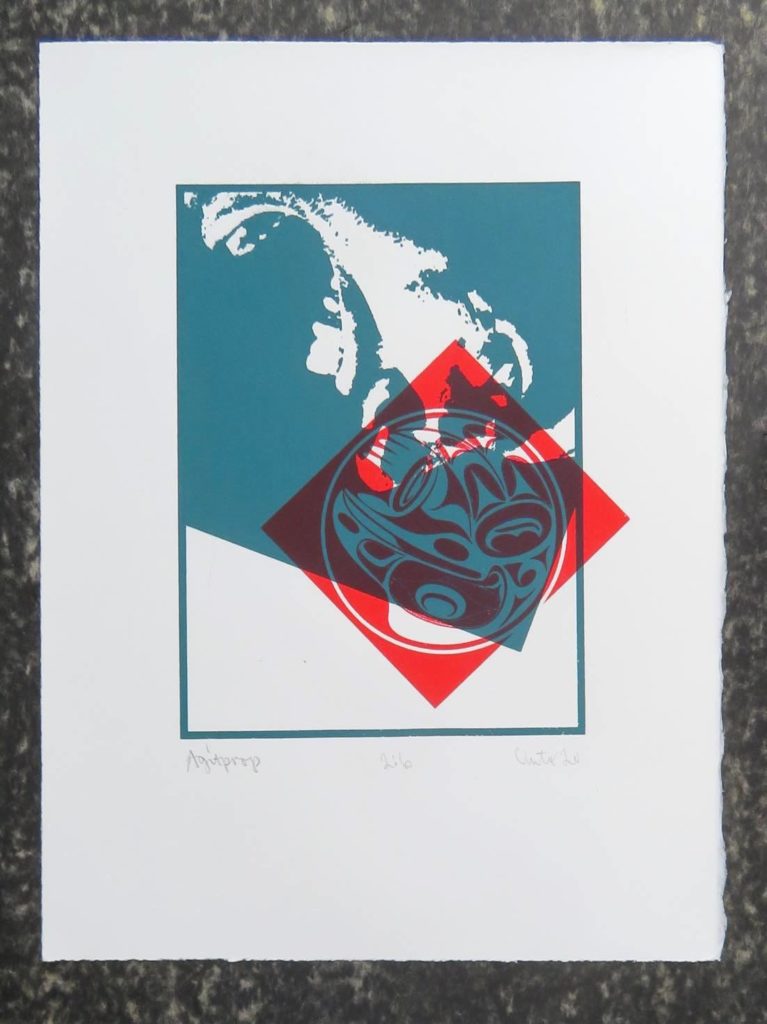
10 August 2020
Another silkscreen print in an edition of six. It is titled The Gate and its paper size is 370 x 265 mm.
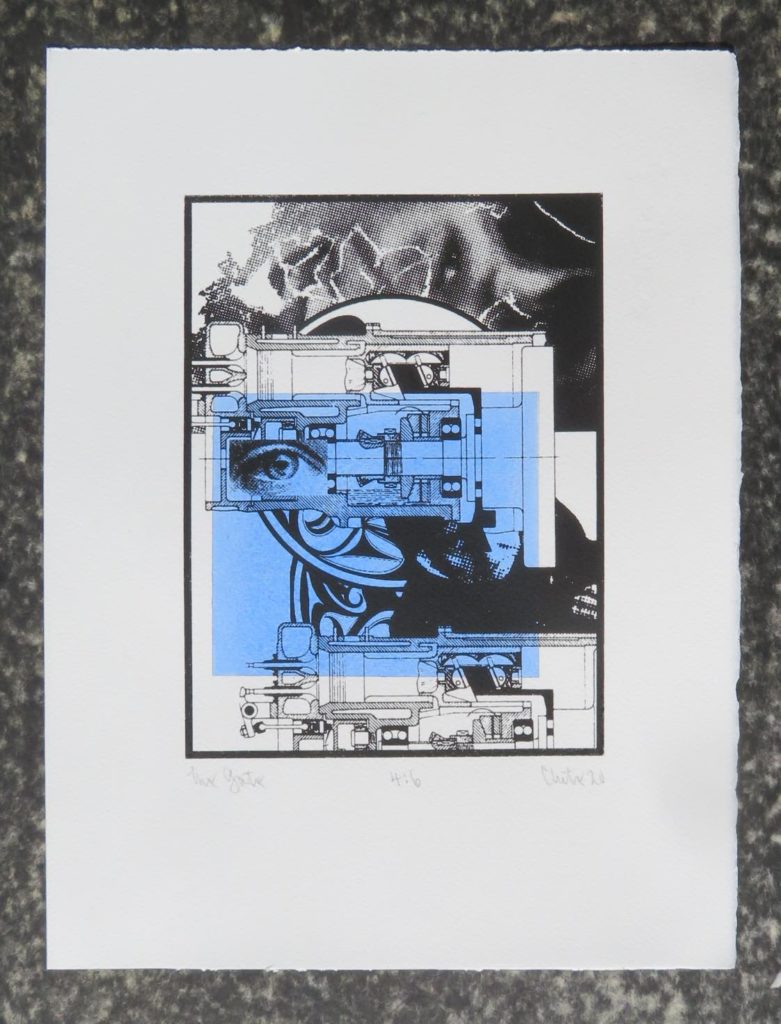
30 July 2020
Here is the latest silkscreen. As with the others it is on Somerset printing paper, 300 wt, but the paper size is a little smaller at 355 x 280 mm. It is Roman-à-clef four. It is in a limited edition of 6.

20 July 2020
We are easing out of the heaviness of lockdown and here are two paintings marking that time. But the virus is still out there and we all are being careful.
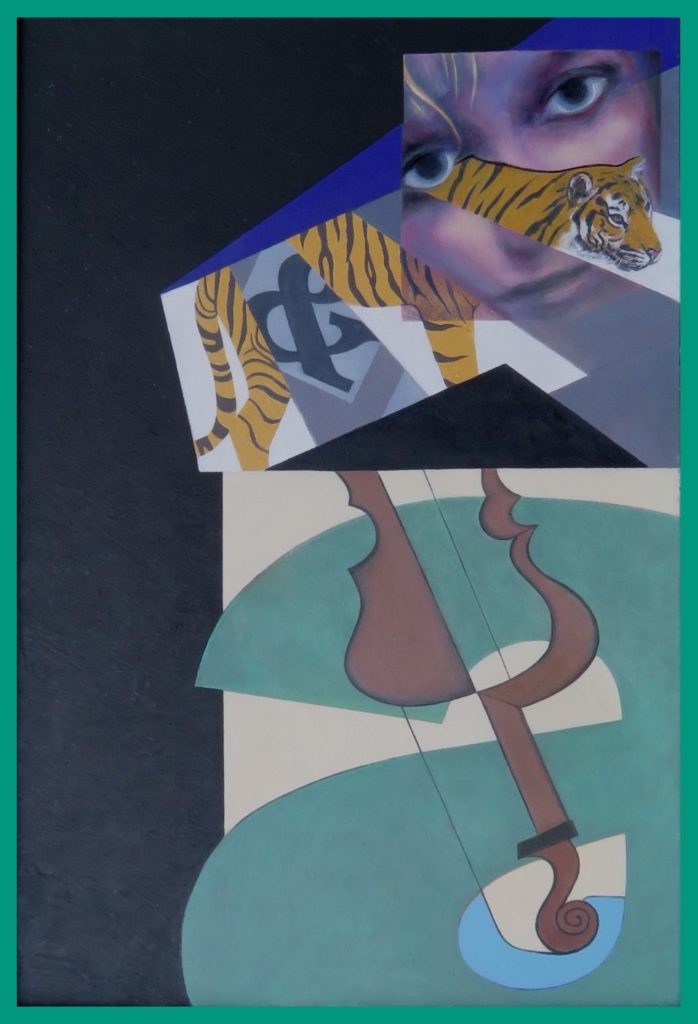
Raising the Blind 2020
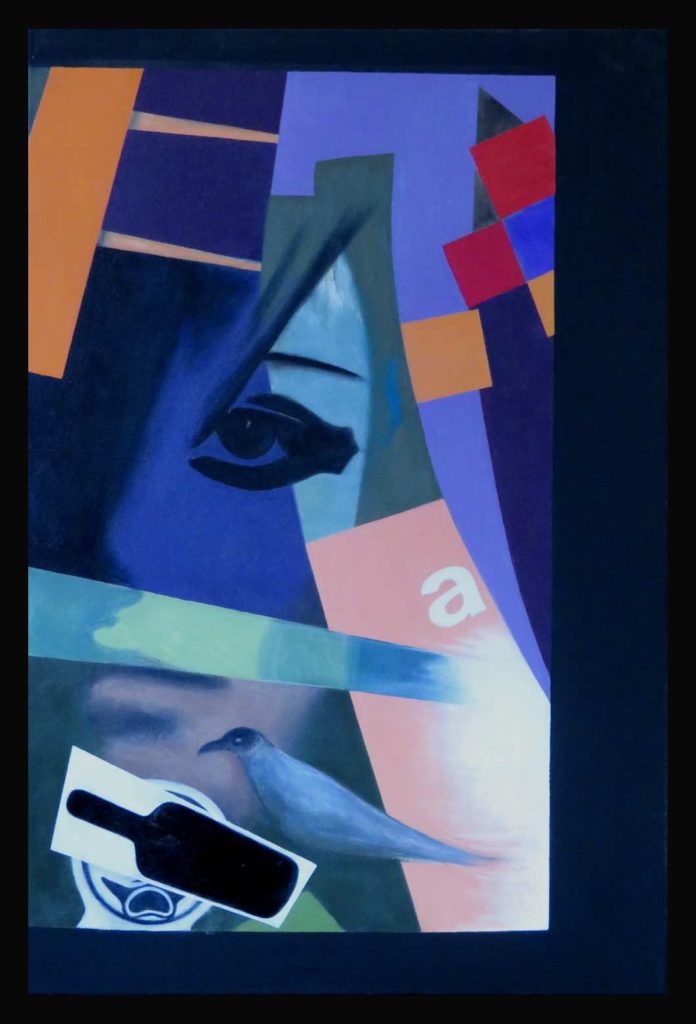
Lockdown Window 2020
17 July 2020
I have now made three prints in a new series with the title: Roman-à-clef and I have set up a new section on the menu here: prints on Somerset paper. Two of them are screen prints. Here is Roman-à-clef one:

28 June 2020
Last week, with great care, and wearing a face mask on all stages of the transportation, I was finally able to work a session at Thames-side print studio. I finished an etching started just before lockdown. Here below. And this is what Pamela Zoline has to say about it. “Does the world look better through the treble clef? Is it like rose coloured glasses or something darker? Can it work like a Claude glass? Or a google something? Is there a bass clef available? Do blondes have more fun?”
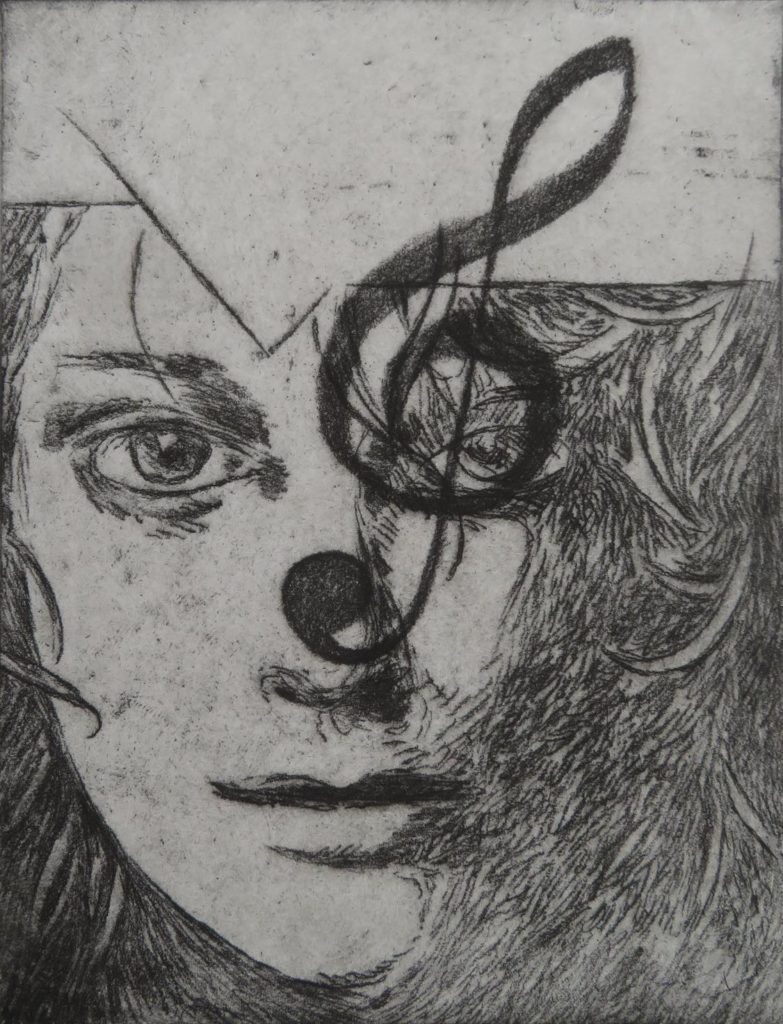
14 April 2020
Thinking from this moment of lockdown back to exactly 50 years ago, I can recall the rush of excitement both Pamela Zoline and I were experiencing as we prepared for our joint show at the London New Arts Lab in Robert Street. It was up from June 5th to June 25th, 1970. Here’s the Studio International mention in their June issue.
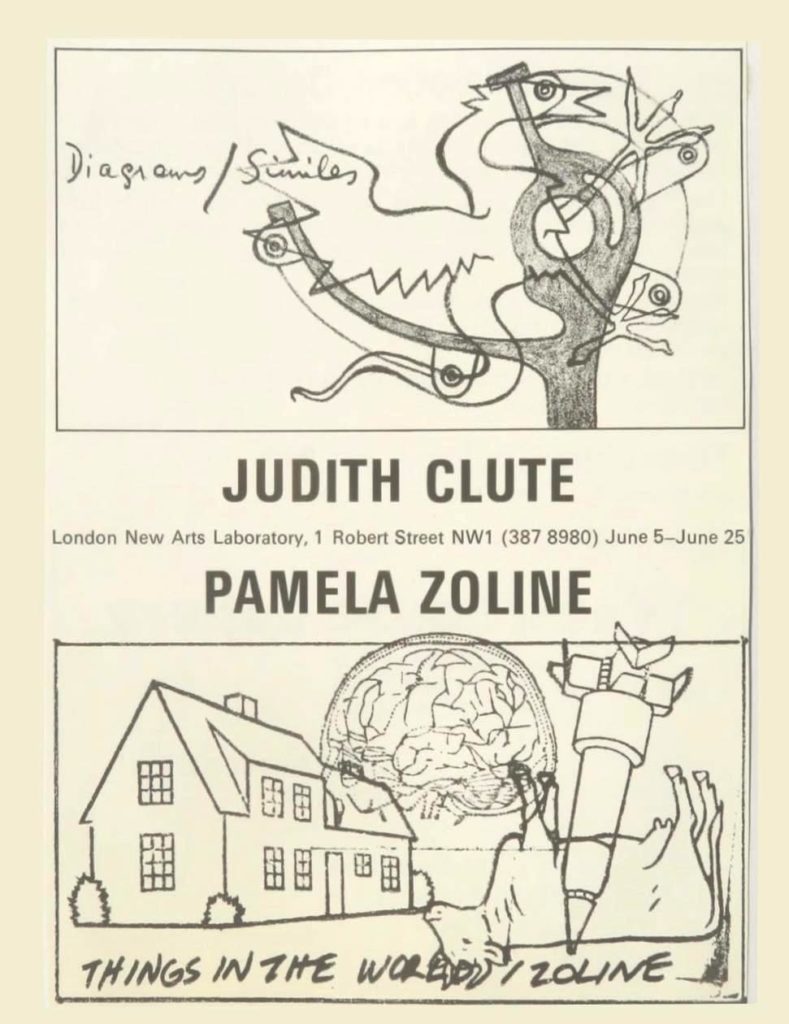
26 March 2020
On the 10th of March I finished an excellent screen printing course taught by Adam Hogarth at Thames-side Print Studios. I was all set to start new works, but of course I can’t make the journey back to Woolwich because of the Coronavirus outbreak rampaging throughout the world. From my place of self-isolation in Camden Town I can nevertheless work on designs for later, thinking especially about the game of how patterns of dots can make for interesting tonal gradation in screen printing. Here’s one sketch, titled – the wait.
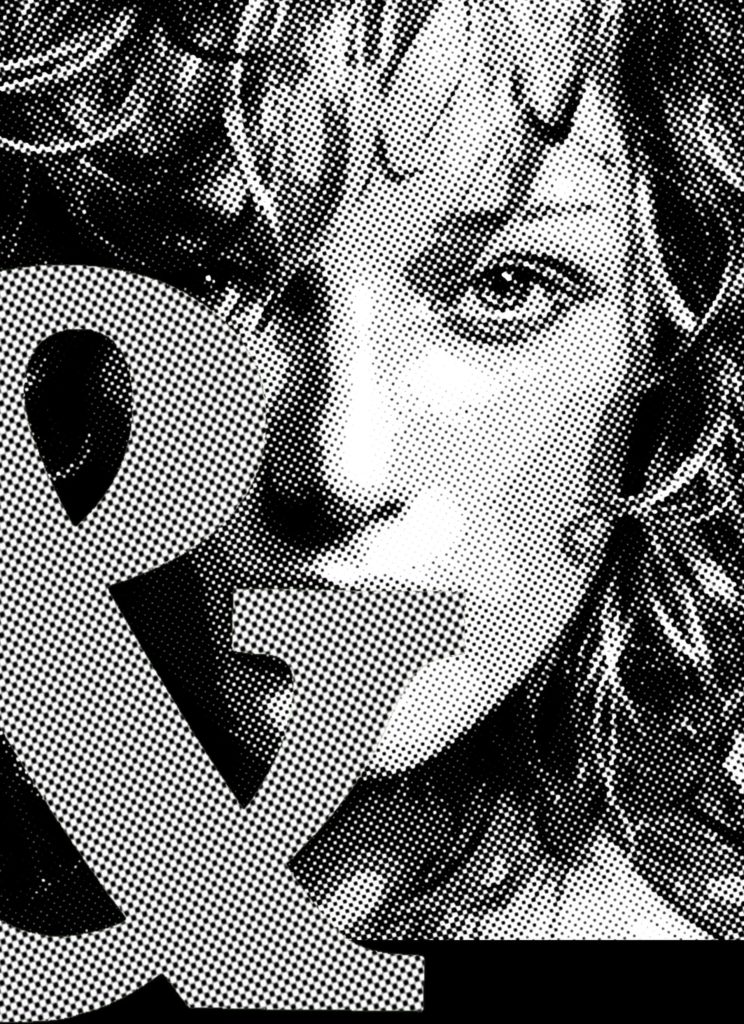
And here is the one limited edition screen print I have so far been able to print. It’s titled – a modest proposal. It is 175 mm square.
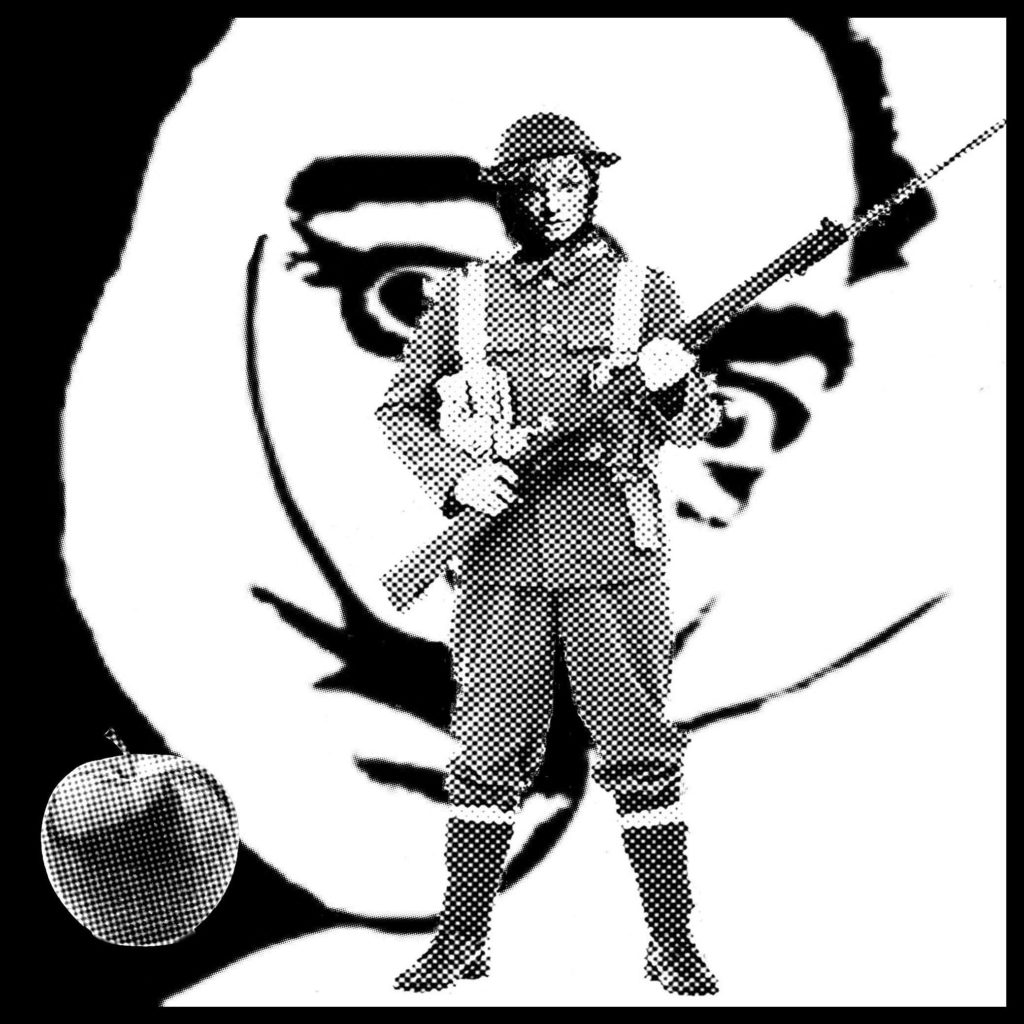
Swift Hope is an enigmatic title Rene Magritte gave to one of his paintings. I borrow this title for another screen print I may sometime try to make.
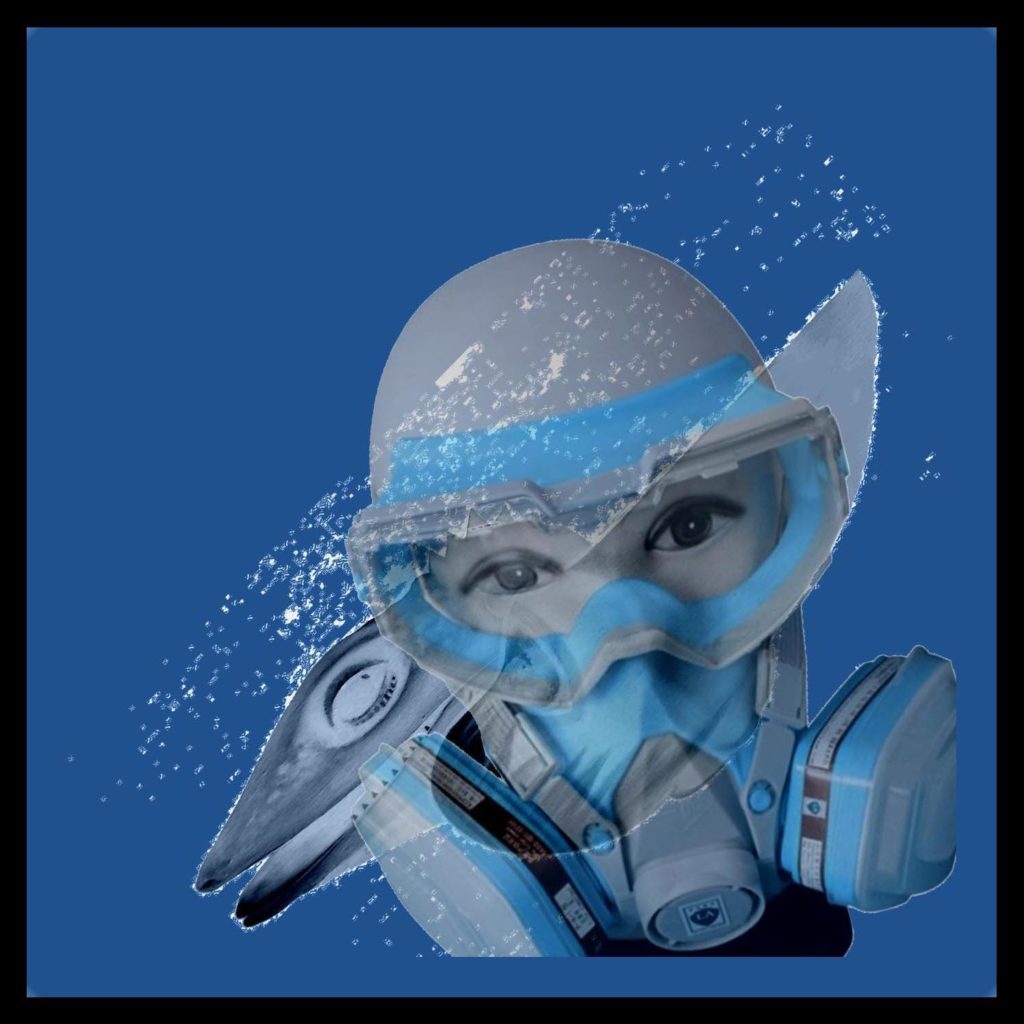
And another possible candidate for a screen print. The original was “Safe!” from 1975.

20 February 2020
A painting that had been “finished” last October, has had the whole surface repainted. It’s warmer now, and stranger. It is still titled, Tempus Dance.
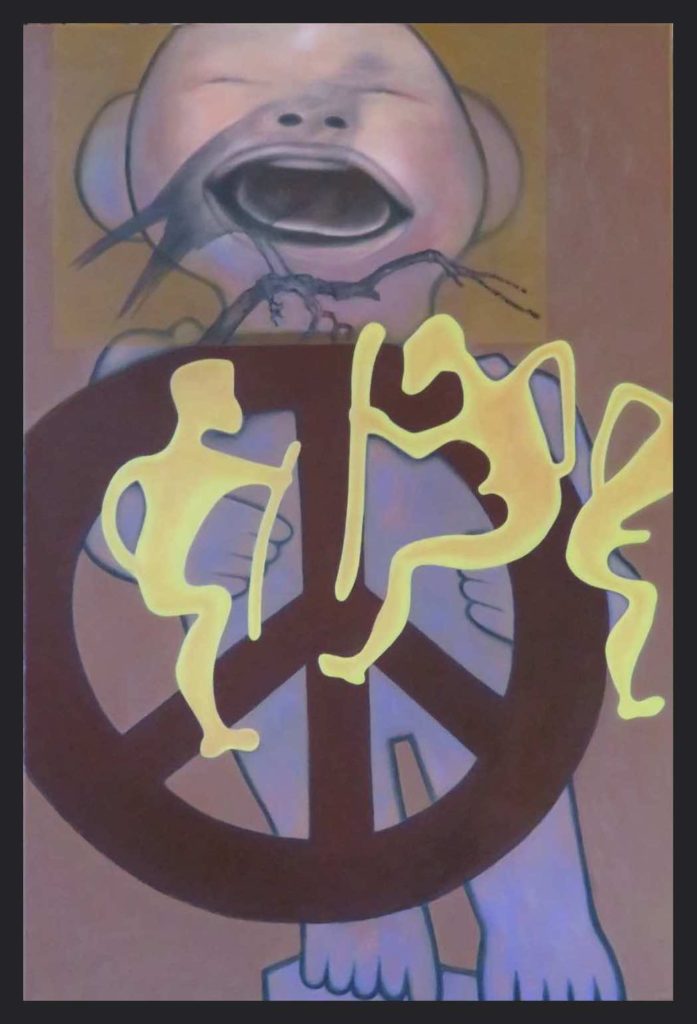
5 February 2020
I’ve just placed the earliest of my prints into the Etchings section. It is in fact an untitled screen print from 1973. Paper size, 380 x 220 mm. I note that even back then I was grouping things together and had taken on board the Inuit way of putting in something upside down. Because why not?
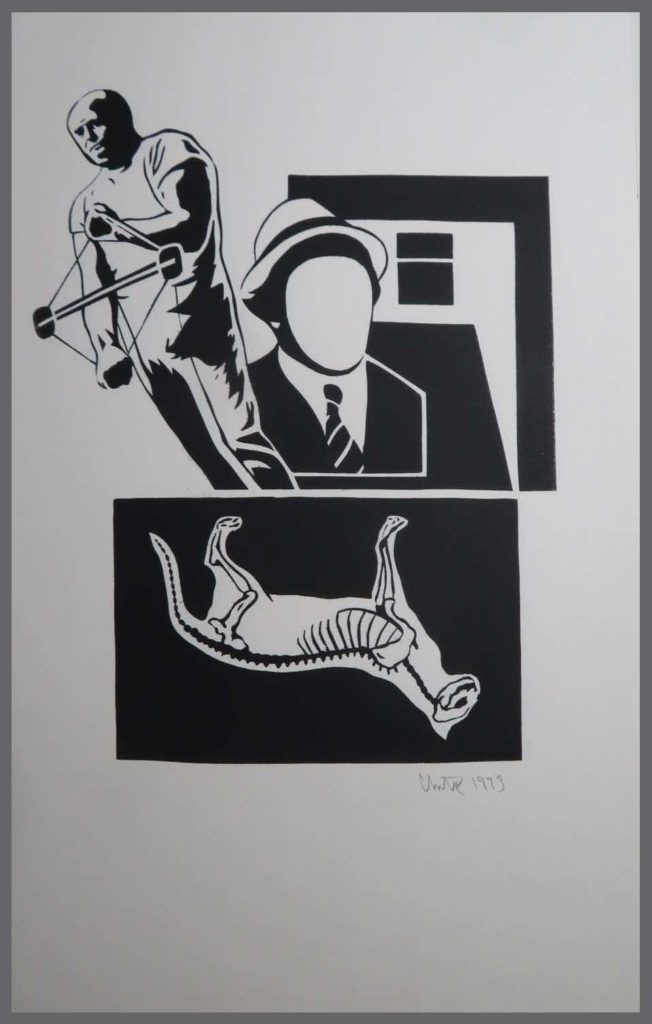
21 January 2020
Just how how long it takes me to finish a painting is here perfectly demonstrated. This one had been a card I’d published in 2017, and only now, January 2020, have I slotted in the missing piece, lower right, to make sense of everything else in the painting. Fit for Purpose. (framed, 798 x 540mm).

20 November 2019
I exhibited Blood Simple (framed: 520 x 403 mm) in this year’s Woolwich Contemporary Print Fair. The exhibition was from 07 to 10 November 2019, at no 1 Street, Royal Arsenal, Woolwich.
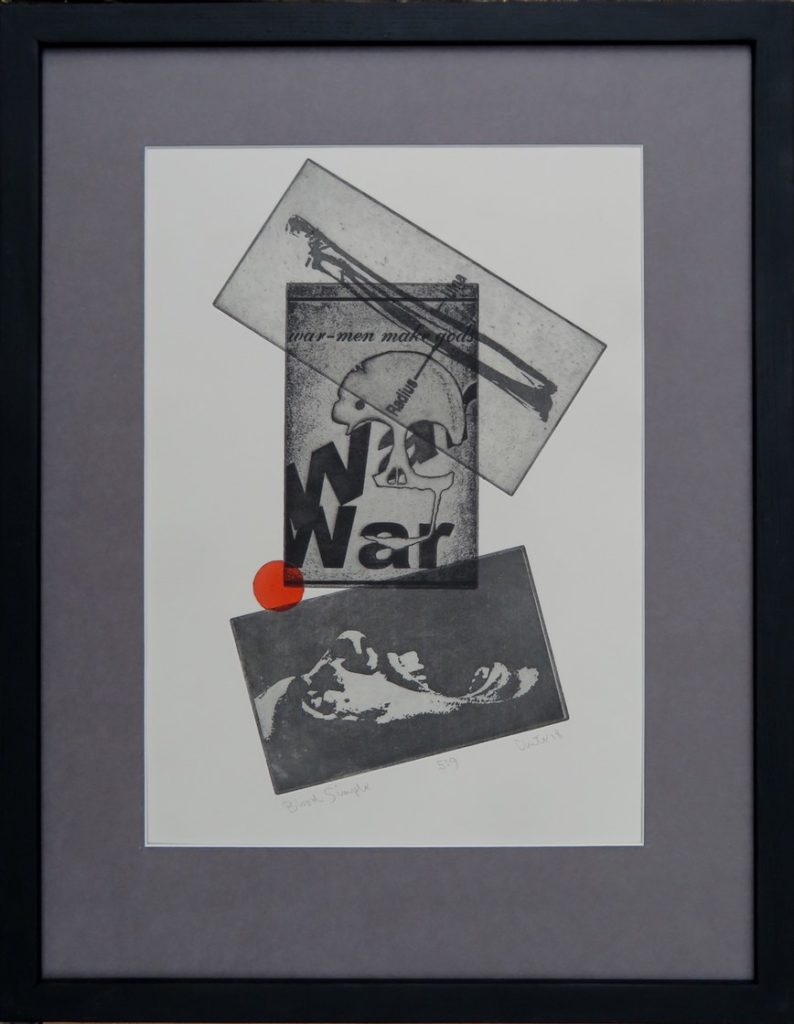
8 October 2019
Here is my latest painting. It is Tempus Dance and is, in dimensions, 800 x 550 mm. Mathew Downward says of it, “your latest shows the usual facility for communicating humanity’s refusal to face up to the cultural implications of its past”.
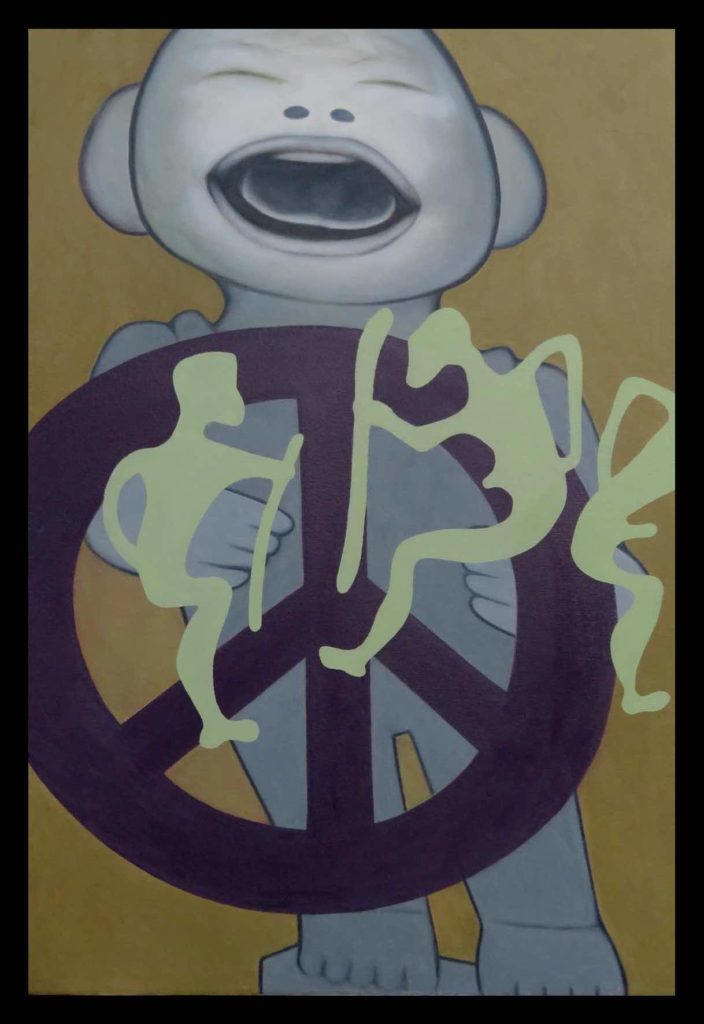
25 August 2019
This morning I did a tweet, hashtag “darkeningdreams”: If the climate crisis escalates unabated only stone images of humans will remain.
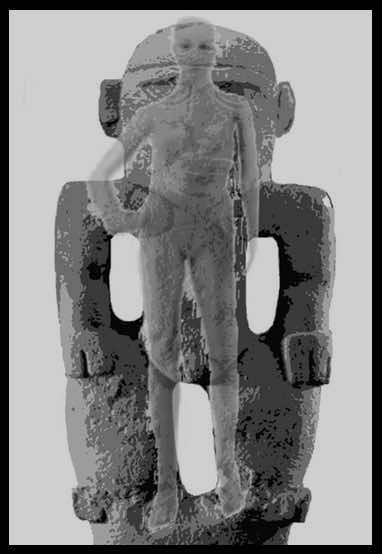
5 July 2019
The New York Review of Books, July 18 2019, that is the latest, has my Joanna Russ cover to illustrate an article, “A Universe of One’s Own”. The review is by Nicole Rudick: The Future is Female!: 25 Classic Science Fiction Stories by Women, From Pulp Pioneers to Ursula K. Le Guin. Library of America.
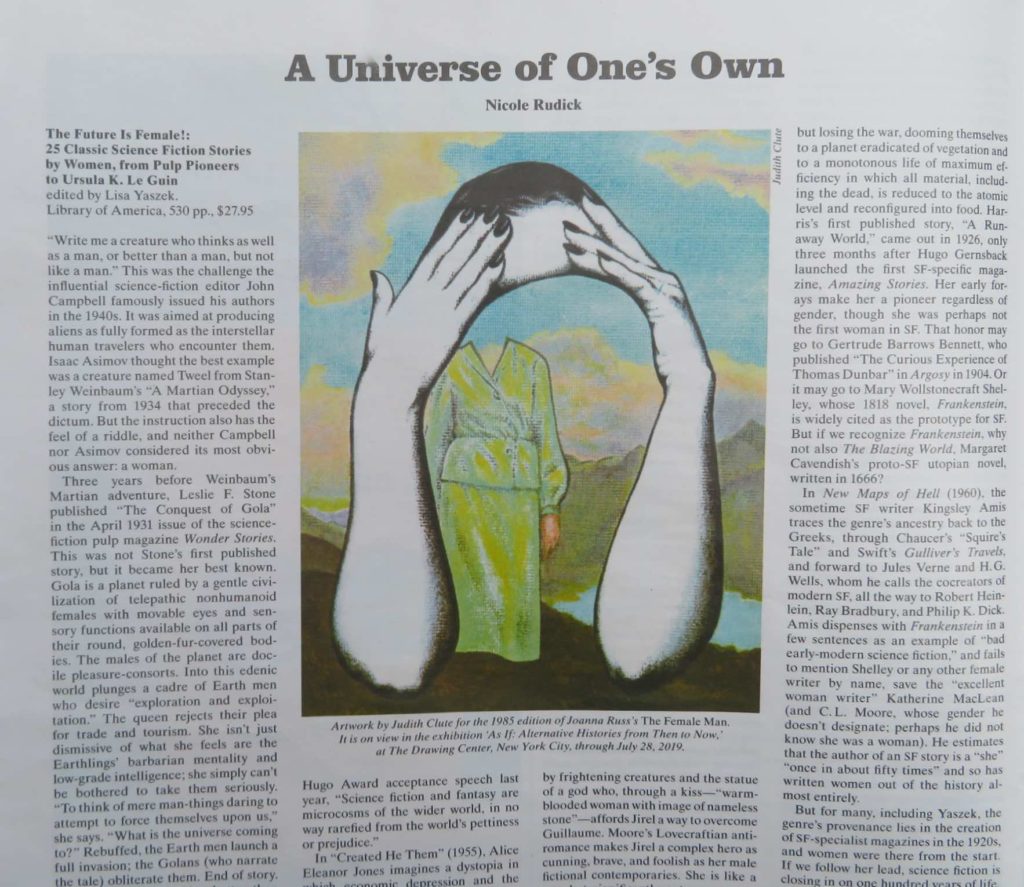
The image is a detail from my artwork for the cover of Joanna Russ’s Female Man, published by The Women’s Press, 1985. And that cover is in the show, As If; Alternative Histories from Then to Now at the Lab, 35 Wooster Street, New York, NY 10013. April 12 2019 – July 28, 2019.
26 May 2019
A few images from the party on the 16th. Gabrielle Motola who is usually behind the camera, and who doesn’t really like to be taken, nevertheless is here in front of my camera, and she is the clever person who wrote the riff on Punctuated Equilibrium. Behind her are Anne Wittman and Gracie Samadjopoulos.
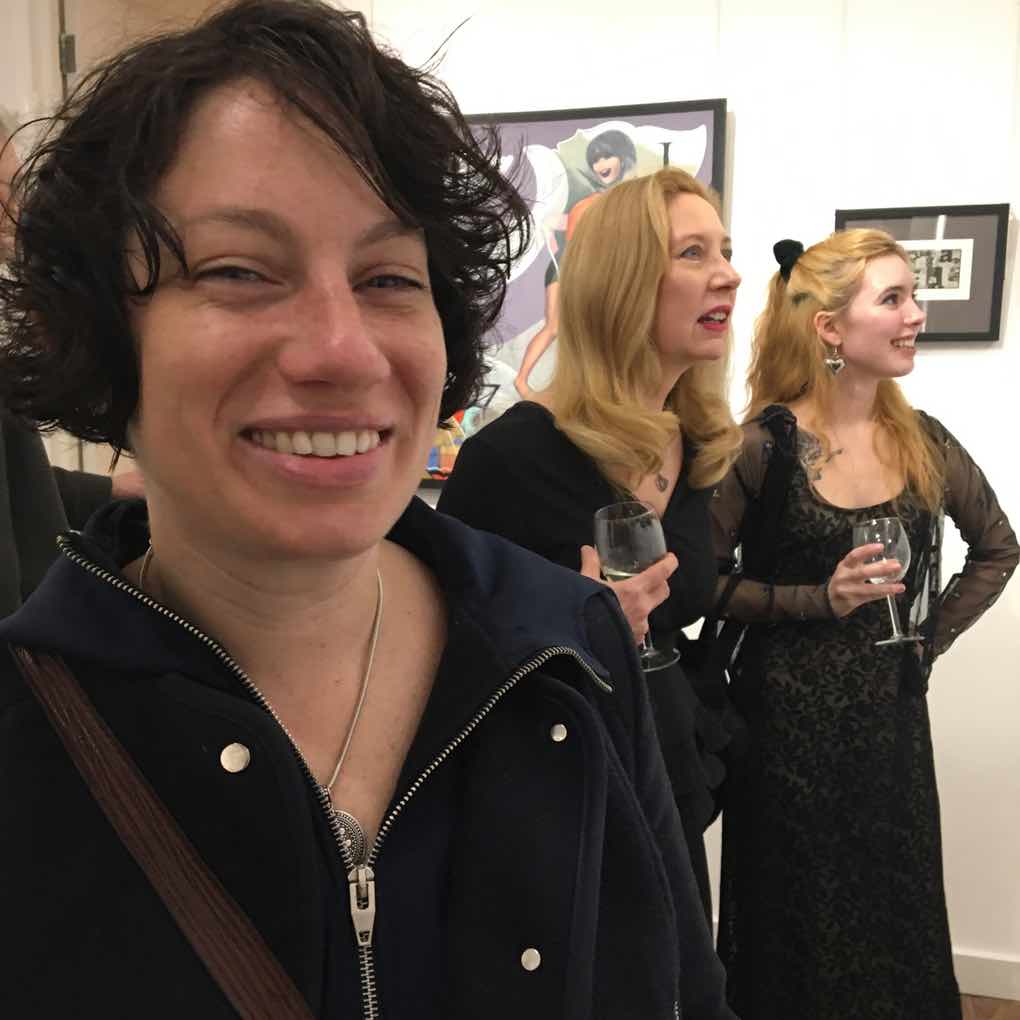
Here is a profile of Morgan Doyle who is taking a photograph of the etching he bought. Morgan wrote the brilliant little piece called The Shape of “a”.
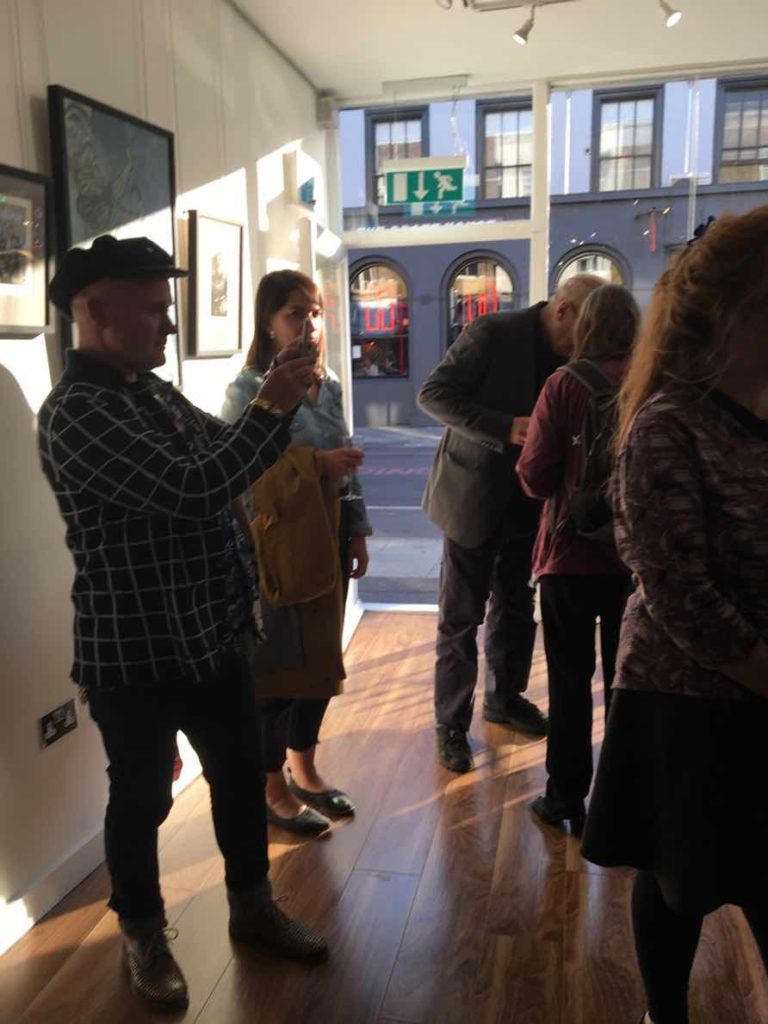
At the front door John is greeting someone and behind him, facing the other way, are Konrad Walewski, Keith Jacka and Robert Irwin.
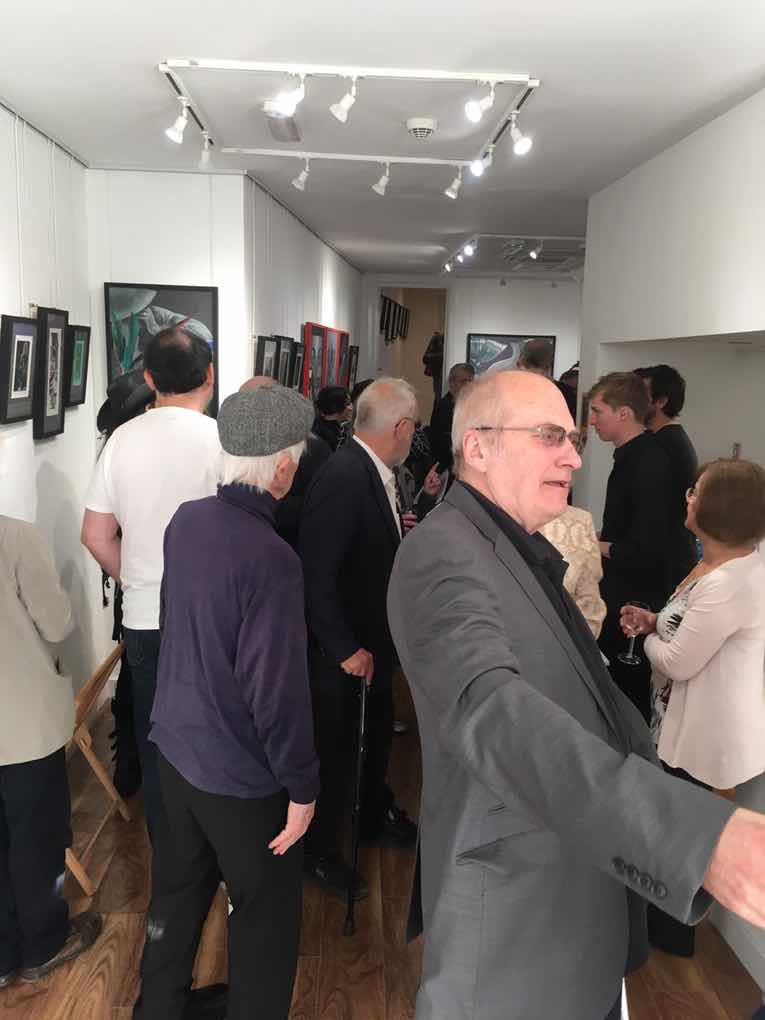
Mac from the Inverness Street music venues has come to have a look.
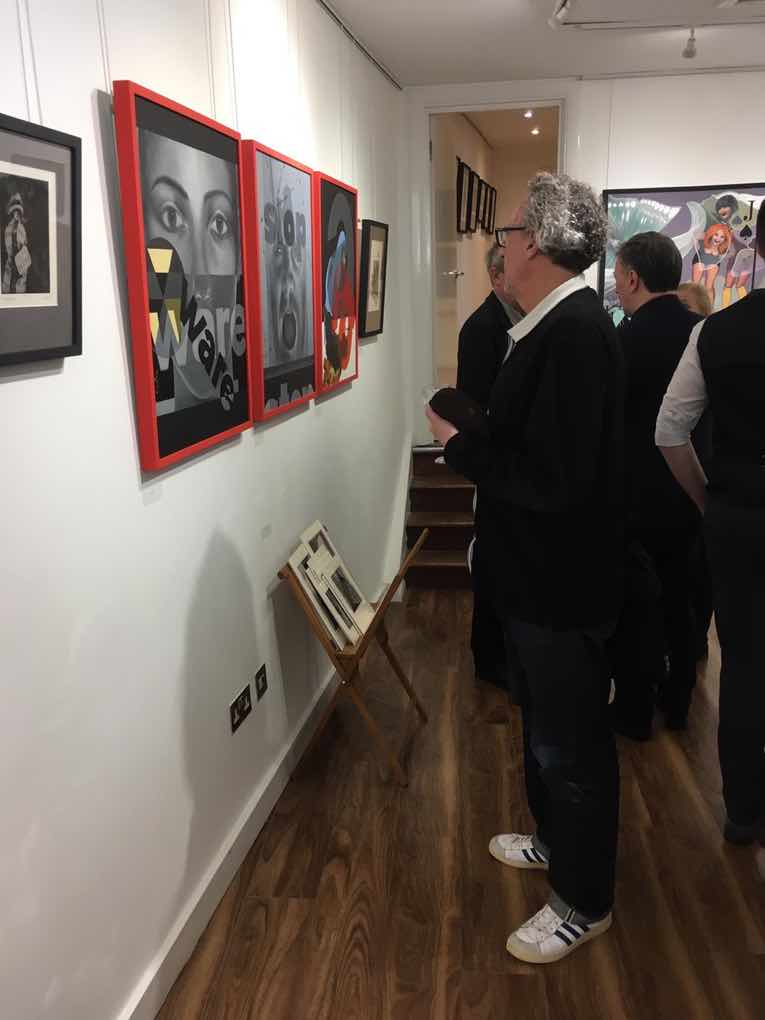
Jasmin from the gallery and Dick Jude flank John Clute while he greets Alison West.
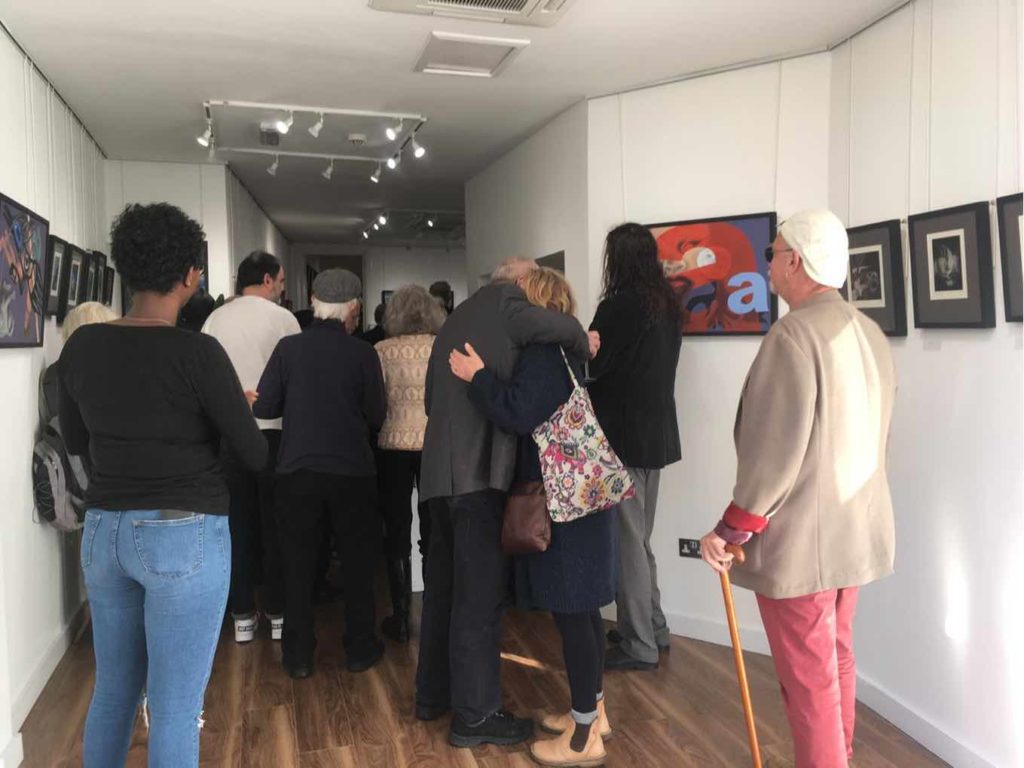
Paul McAuley and Barry Forshaw talk. And others including Elena by the doorway.
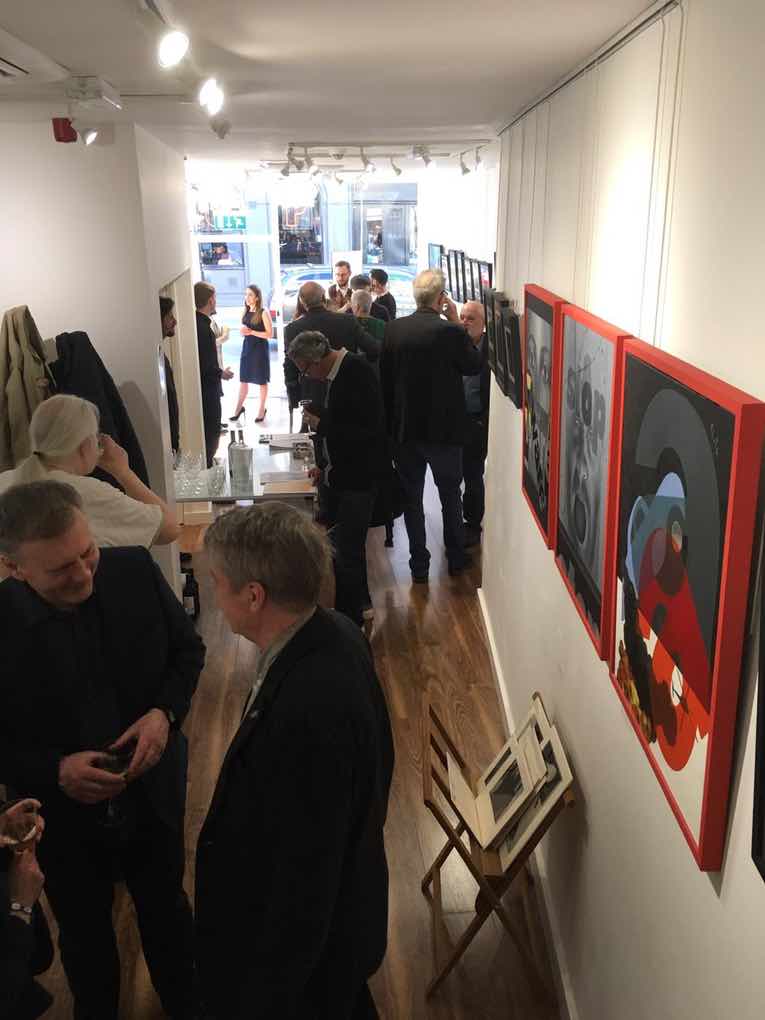
19 May 2019
No time yet to do more than mention that the opening party at Camden Image Gallery last Thursday was brilliant. I’m very happy. Here’s one pic for now. Mikey Kirpatrick, Alma Luz and Chiara Ambrosio.

12 May 2019
In just a few days my show as mentioned below opens. When you come on Thursday evening you will be able to pick up, for free at this stage, a little book published by Beccon. It is written by Geoff Ryman. He has been quite playful, designing it as CD liner notes: Judith Clute’s Tantalizing 37th Album. Here is the front and the back.
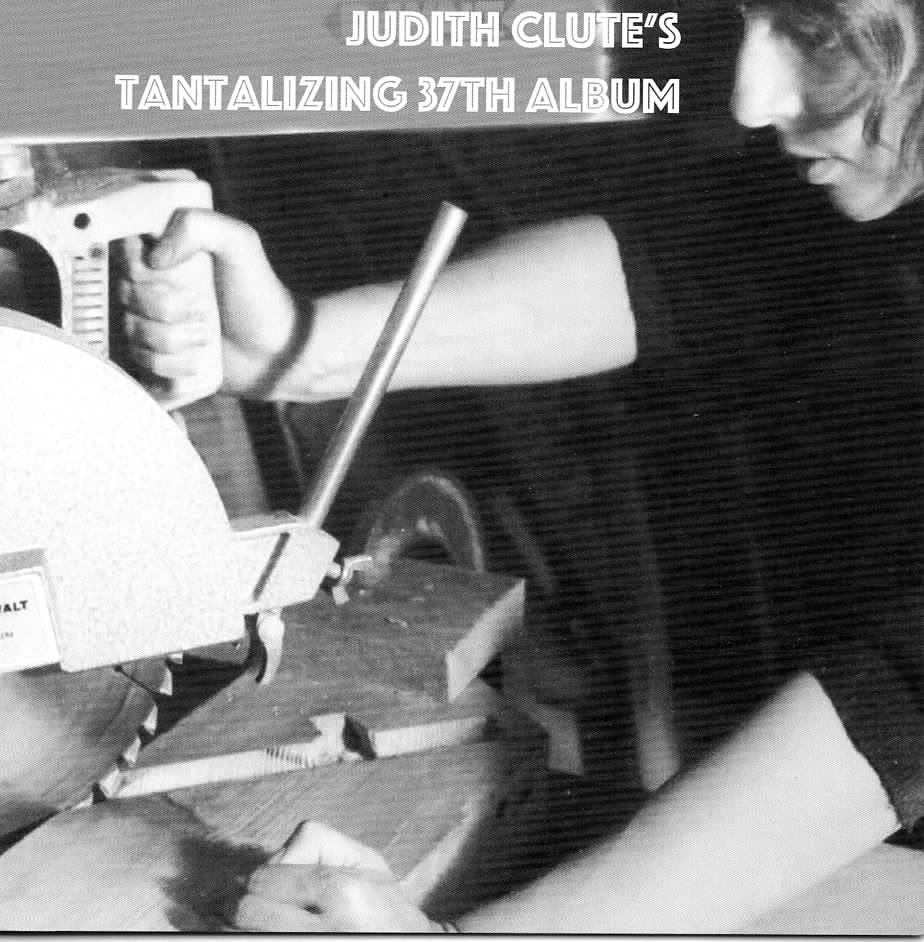
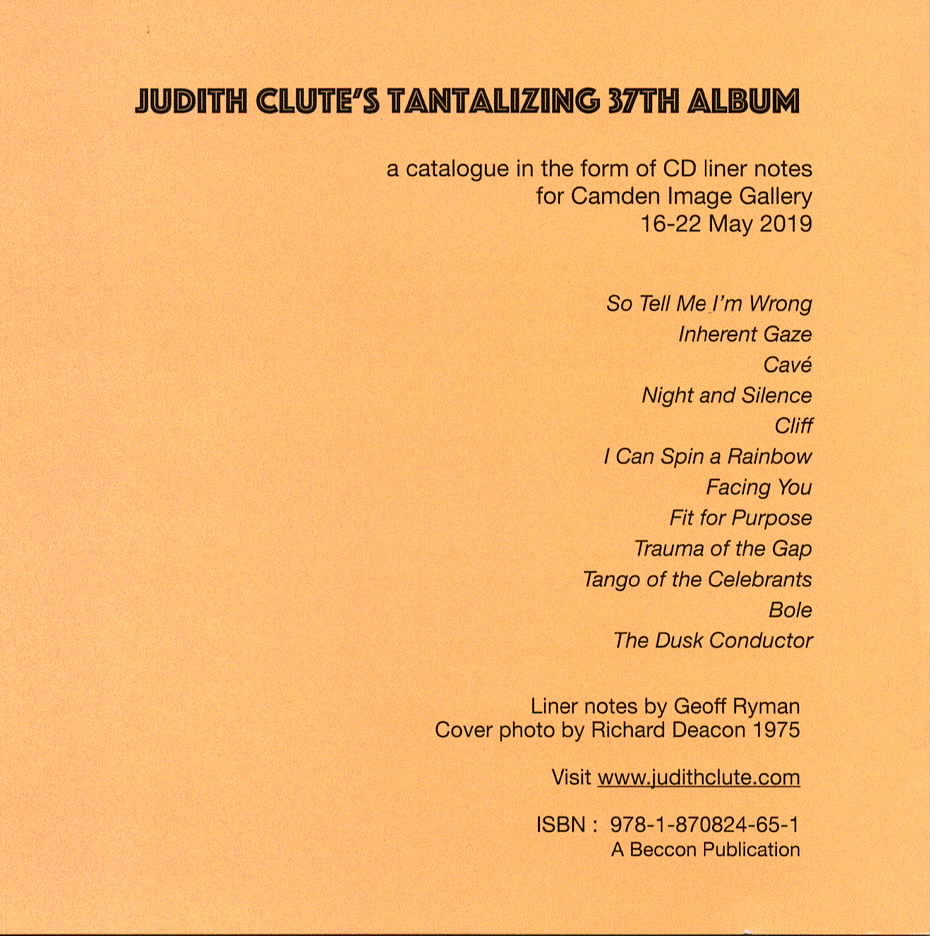
28 March 2019
In exactly 7 weeks my show at the Camden Image Gallery opens: 174 Royal College Street, London, NW1 0SP. It is just steps from Camden Road Overground, and only a little farther from Camden Town Underground. From 6 to 8 pm. (The painting is So Tell Me I’m Wrong)
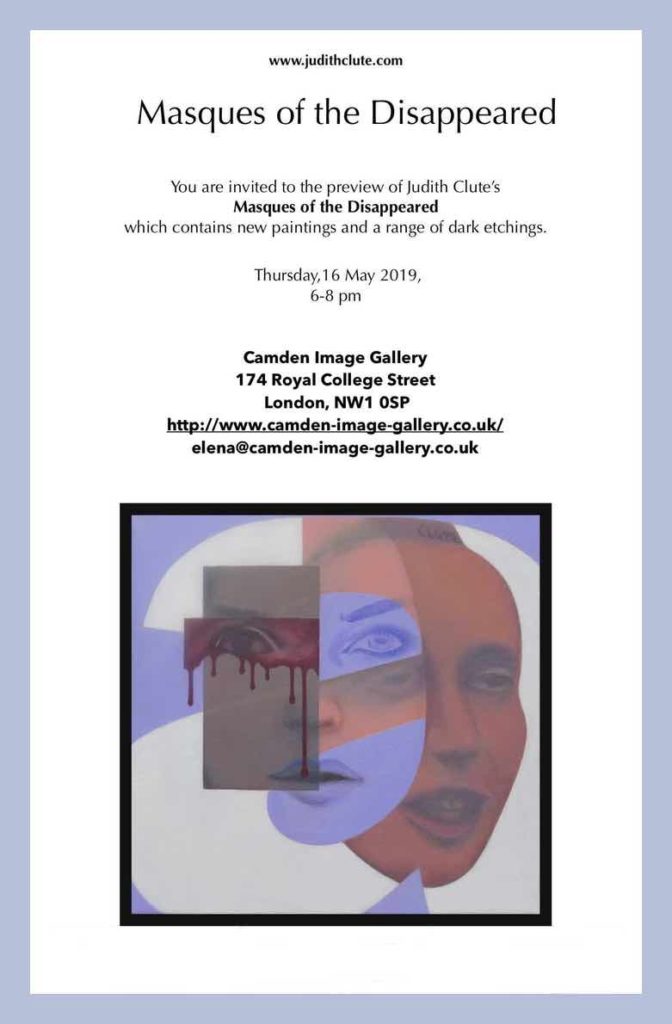
12 March 2019
Gabrielle Motola and I were walking through Tate Modern last week and I asked her if she might write some words about my work. I suggested a game like this – if she could find a painting that would set up an emotional response, then she might run with it. She chose Punctuated Equilibrium. And below are her words.
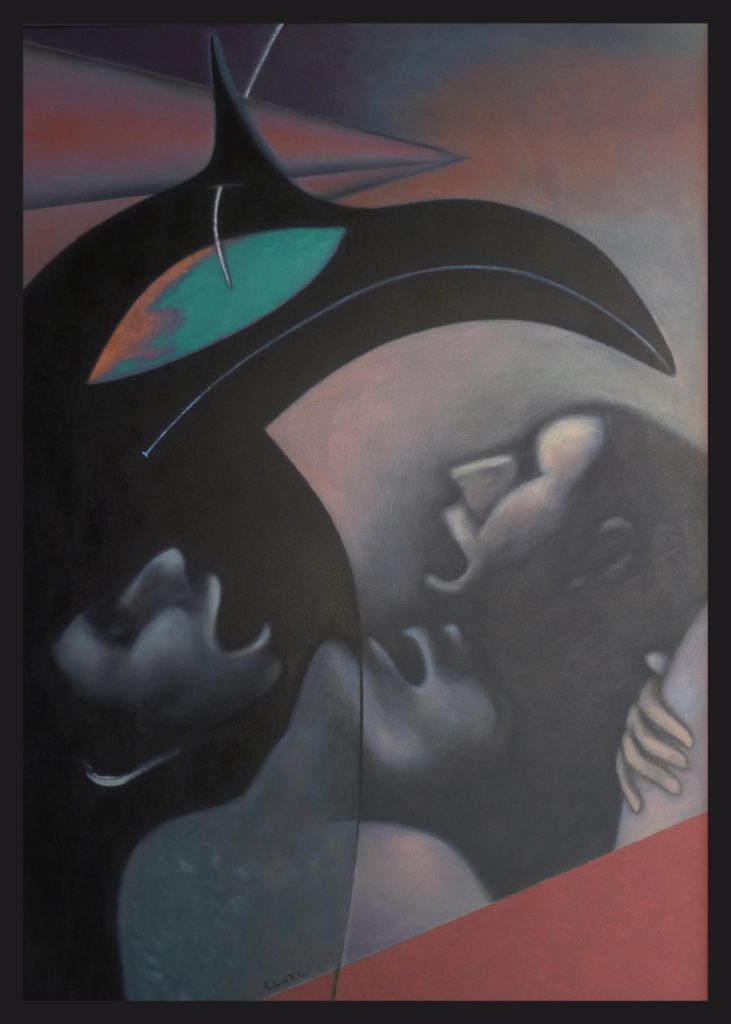
“Life is a layered cake of chance, of choice, of joy and kleśa. More or less. In those layers like Alice, we pass through them as we fall through the looking glass, the optics of our eyes and minds. As we move we change and that change changes how we see everything and how we are seen. To be seen through a kaleidoscopic lens rather than a sniper’s sight is how I see and how I want to be seen. How is your eyesight? 20/20 hindsight? foresight?Blindsight? Most of us have a desire for a singular vision of knowing, scoped, lone sighted, decontaminated, and free from doubt. With our singular persistent insistence, we drag the rest of the world with us into a black hole collapsing in our certainty and the process begins again. We crave a direction which is directed, but even so. I’m uncertain and only certain of that. Or am I? Layers leave me in the spaces in between spaces, in the place between places and closer to the truth of things which is not singular, poignant or even important for me to comprehend. I can not grasp that which I can not grasp that which I can not grasp. You are no different. If you are you have an obligation. Share your perspective with the world for it is different and needed. If you do not it is lost with you when you pass into the next stage, backstage, or no stage at all. Leave it in print, on screen, in a person. We see to replicate ourselves always which is not always flesh and blood. The most creative choices are often those we make alone.”
….Gabrielle Motola, 2019 …. https://www.gabriellemotola.com/
7 March 2019
A recent etching, End Revels, incorporates a borrowed image from Canada in the 1960’s. The Inuit artist, Pudlo Pudlat, had drawn a beautiful eagle seizing a fisherman. A woman’s eyes are watching. Maybe she is god.
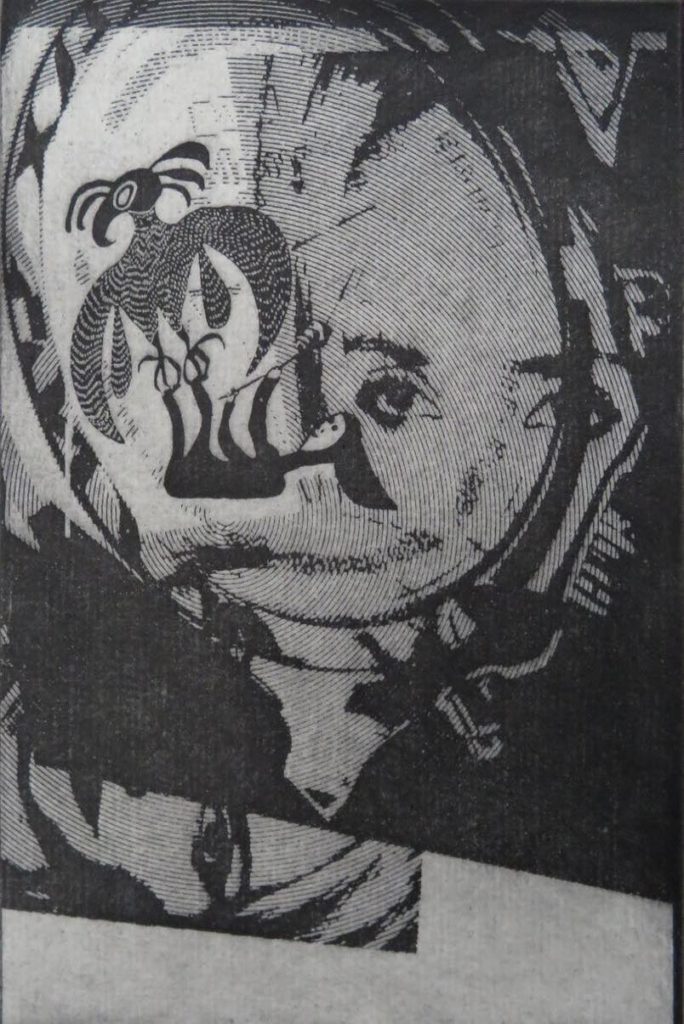
End Revels 2019 plate size …. 238 x 160 mm
2 March 2019
One of my ArtsLab colleagues, Biddy Peppin, has said that she likes my use of overlaps and underlaps because as we get older our feelings seem to work more in that fashion and she indicates that I seem to be one of the few to capture this in paint. I’m grateful for her words because it’s all about capturing feelings, dream feelings. Maybe I’ll select a hashtag -darkeningdreams and start putting things up on Instagram with a twitter echo. I don’t know. But if I were to embark on this, here’s a closeup of what I might start with. (It’s from Future Study 2017). And then I would follow with more closeups from the one etching. And so on, to stretch into subsequent days.
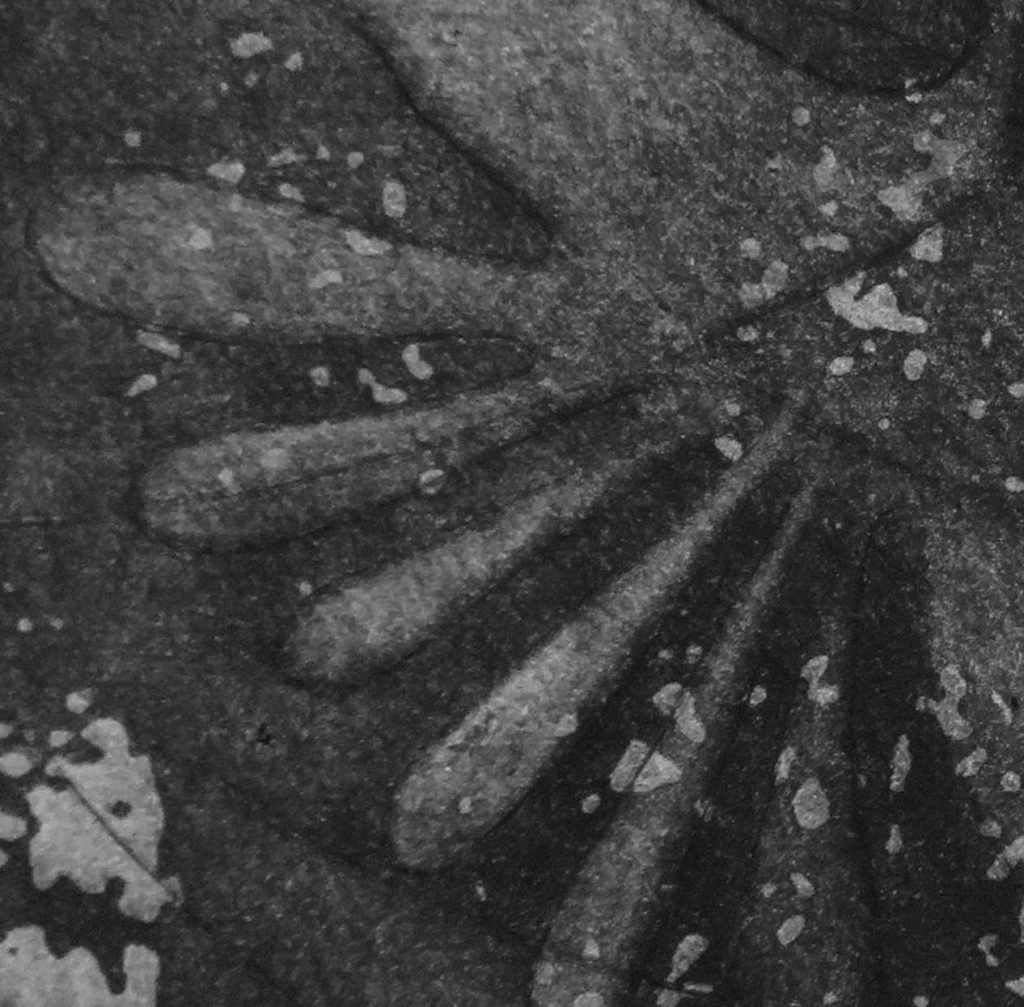
24 February 2019
I feel a direct connection to this exhibition at the Arts Lab in 1970, as I’ve explained earlier, because it’s where my art took on its present direction. The photo below was taken by David Kilburn who bought the painting partially visible behind our heads. (John often smoked a pipe in those days). The painting was simply titled Boardpainting 6. It’s one of the ones that resulted from the imaginary fellowship that I mentioned in “Conversations”, 20 January 2019.
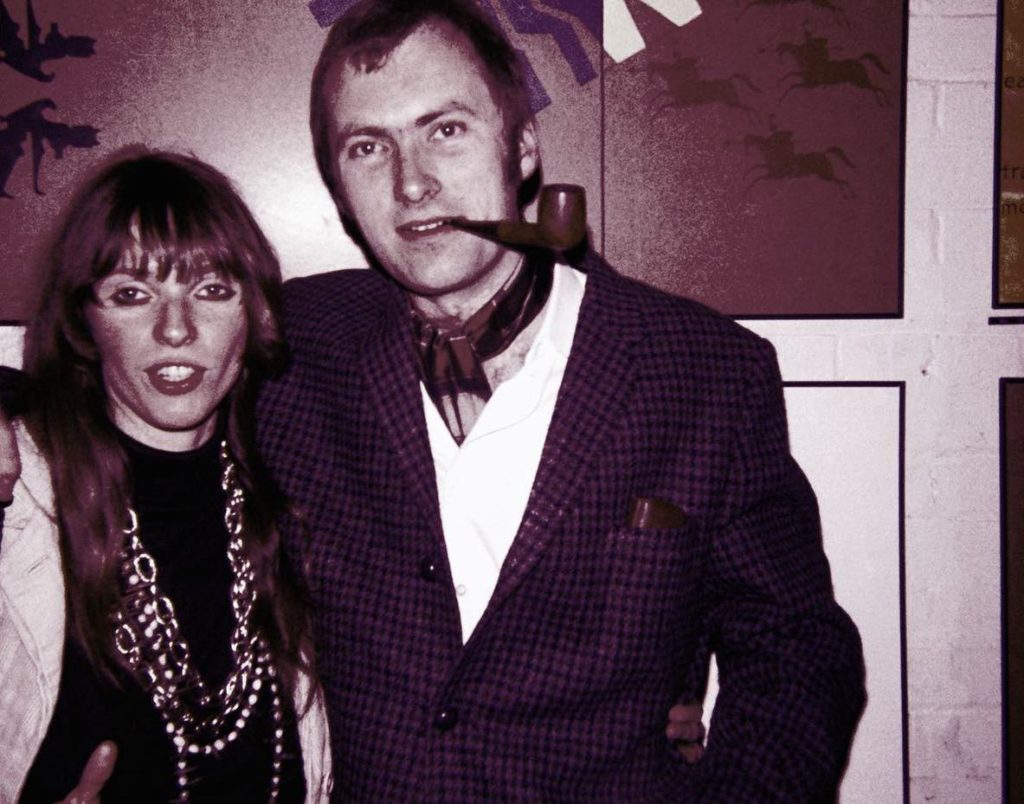
Judith and John at the Arts Lab, Robert Street, 1970.
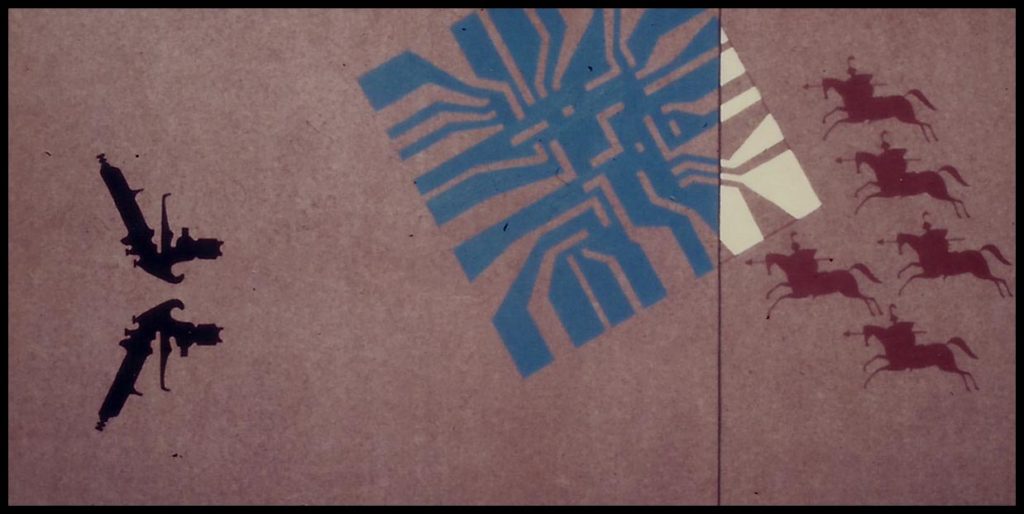
Boardpainting 6 1970 acrylic on board …. 610 x 1220 mm
8 February 2019
Ideas for etchings. I search everywhere for a little slice of an image of terror, that it may stand in for the big stuff in this broken world. Especially in Prufrock: “I should have been a pair of ragged claws, Scuttling across the floors of silent seas.” Or in John Clute’s Darkening Garden: A Short Lexicon of Horror. Utterands, his word, frightened and frightening characters, burnt into strange shapes by the story of our planet, “They march to the tune of history turning out of Eden.” But beware! I remind myself, of icons too pinned down, too already defined by other people. I should look up and sideways; the uncanny can be found everywhere. Also there’s hidden away in my mind a magic box of shifting images from Hieronymus Bosch, Alexander McQueen, and Inuit artists in Cape Dorset. These, my emblems of a world gone wrong, needing to surprise, me, alone, pressed into dampened Somerset paper, one hundred percent cotton, acid free. And Alexander McQueen laughs pallidly.

Sixteen Tons 2007 plate size …. 215 x 138 mm
28 January 2019
Shape of Content. “If I descend too far, then I can’t do the actual work.” This, from the end of my note on Masques of the Disappeared. I’m therefore needing to say something about the canvas itself, or the image, printed out as an etching. How does the artist do the job? Sorry if the following sounds like playing with magic, but the shape of content is consistently listening to hints of rules that come from the work itself. You set out to do one thing and it keeps moving in different directions. This colour, that colour, morphing. This line, that line, changing. Shall I tell you the most important element for me in the making of a work? It is to spot a wrongness along the way. If, as I’m weeks or even months into a painting, I ever get the feeling there is an element of “illustrating”, or a dubious association, then I paint out that “wrong” part. The magic in some way comes from having studied, over the years, paintings in museums etc. But when you make a work of art yourself, you clear your mind and forget everything. You just work. And there are many times when you smile and punch the air. As I’ve said before, it feels a privilege to have been doing this all my life.
According to studies of eye movements, it has been said that an artist and a non-artist tend to look at paintings differently. I suggest we could all play the game of looking as the former would. Let your eye be led by the shapes on the canvas – whatever catches your eye first, and then move around on the surface as the shapes set up relationships. Relax and trust what you see. As you do this, the shape of content makes sense. The picture – its meaning and the making of it – become one.
22 January 2019
Masques of the Disappeared is a series-title designed to emphasise the overall thrust and timbre of many of my individual works: an undertow throughout of the sadness of a world gone wrong. If I tell stories (sometimes I do) they are meant to show that sorely stressed world. If I don’t tell an individual paraphrasable story (mostly I don’t) of the world, maybe you should think of a masque whose actors leave marks that may not immediately declare themselves. I’d like to think all the same that you can see, in the clarity or murky shapes of content, an angle from which to judge what is going on, a pulling down or building, characters sometimes re-drawn into strange shapes by their relationships, their environment.
The Masques I make are to spite the disasters I have witnessed (we all have witnessed) as well as the ordinary small, terrible cruelties people inflict on others they perceive as different or simply of less importance than themselves. For instance, I can’t get out of my mind an image from an online film I saw recently where a man finds a sheep in the middle of a country lane. He picks up this “thing”, this “obstacle”, and throws it over a fence. The animal lands askew and limps in pain, having broken one of its legs. The man might just as well, straight away, have killed the animal. Rather than torturing it to death.
Or to the bigger picture. This planet is plagued so manifestly everywhere by wars and boundary maintenance. “Blood Simple” is voiced several times by the protagonist in Dashiell Hammett’s 1929 novel, Red Autumn. The title of the Coen Brothers film, Blood Simple is taken from Hammett’s book. The phrase might be hyphenated. It’s not that blood is simple (though in a terrible way it is). It’s that we become blood-simple when we get drowned in the terror and cannot stop drowning. I can’t help thinking that “Blood Simple” perfectly describes our predicament; I can’t help thinking that we are, all of us, contaminated by our communal blood inherited from our ancestors, those fighting chimps. That’s the bottom line. I hope our culture of humanity and kindness will sustain us.
And so we tell each other our stories. We make our art. On some level we know that we are powerless to help, to ease, the continuing pain of others. Hence the sadness that sits in the centre of many of my paintings and etchings. But as an artist I can never be completely despairing. If I descend too far, then I can’t do the actual work. To tell you the truth, all artists are like this: at some point we close down all input from the outside world and get on with the job at hand. And there is incredible joy in that job of making. I feel privileged to have been doing this all my life.
20 January 2019
Getting background text material ready for the Camden Image Gallery.
Conversations
There is a world of artists out there. Many of them are of course dead now, but they are with me, in my head, all the time. We talk together. I started to play this serious, deeply meant game of conversation in the 1960’s when I was in Vancouver living in the studio of Françoise André and Charles Stegeman, apprenticed there with two other young artists, Pamela Zoline and Peter Wilson. The three of us talked and talked, and worked and worked, but I would also disappear for long sessions, burrowing into the André/Stegeman art book collection. There I discovered Wifredo Lam, for instance, and was fascinated by his way of coping with the strong characters around him when, as it transpired, he was in Spain during the Civil War. Be friends with Picasso, learn stuff from him, but keep your own mojo? I would ask him, how did you do that Wifredo? How did you learn to talk with Picasso, and enter his world without it burning you?
Share by learning, learn by sharing.
Later in 1969, when I was in London, I was looking at a pamphlet about artists who had apprenticed in their ancient culture but who were experimenting with different materials. They were Australian Aboriginal artists working in the remote Kimberley area and an outsider named Roland Robinson had come to them and suggested that, as well as painting on rock, they might put some imagery on pieces of bark. All that was real in time and place, but for me it sparked an imaginary exchange. I took into my world, Jack Karedada, and his friends. In my mind we were a fellowship sitting around a kitchen table breaking bread and drinking wine. They would tell me to work on simple board and they advised the colours I should use. I respected them immensely. They suggested tricks, they told me to make up stories. I am grateful for those “kitchen table sessions”. You can see the first of the set of “boardpaintings”made at the time.
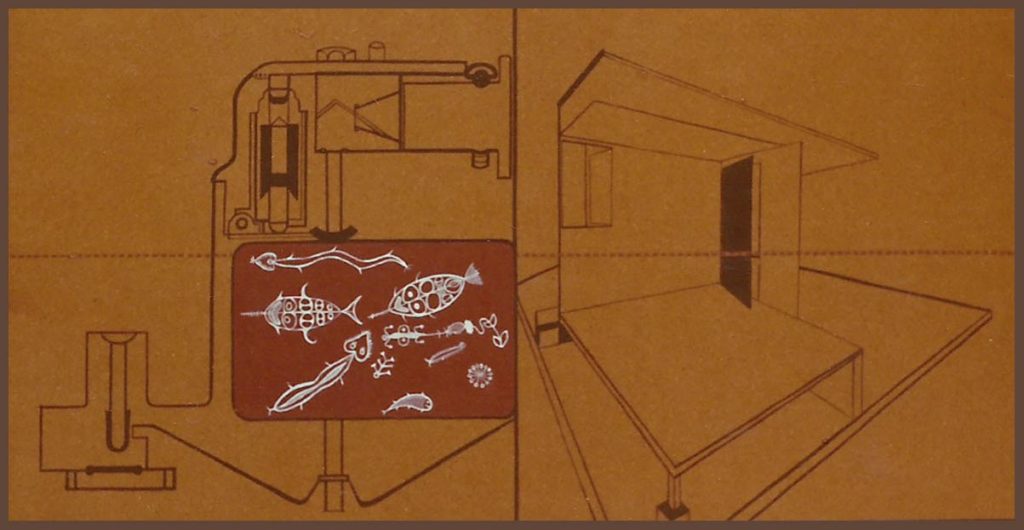
Moving on a few years, I’m still painting on board and still using simple acrylic paints, and still thoroughly inspired by these workers, but the colours have shifted. In Measuring 1972, you can see the continuing diagrammatic references to buildings.
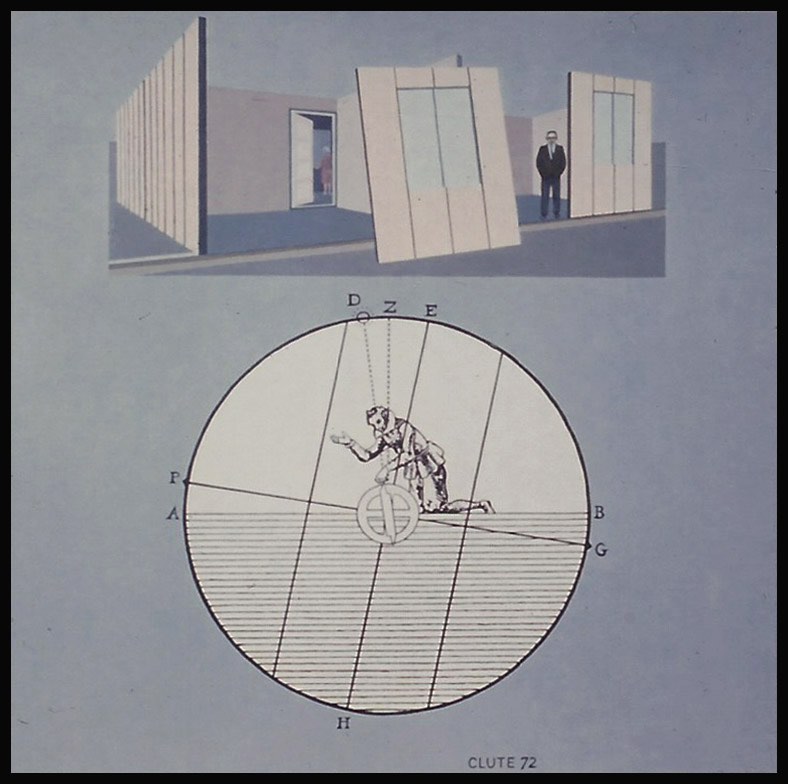
Then a little later the conversations are opening out and getting more complicated. I’d been looking at some Picasso drawings from 1922 in his “classical” mode. Picasso had suggested this, “you really must study the line drawings of Jean-August-Dominique Ingres”. In Ingrates 1975, you can see I’ve painted in acrylic (the same paint type as from 1969) the very delicate Ingres lines. It’s a copy from one of his little portrait drawings and I’ve hedged in that image with a couple of 20th century women and a Bird-of-Paradise.
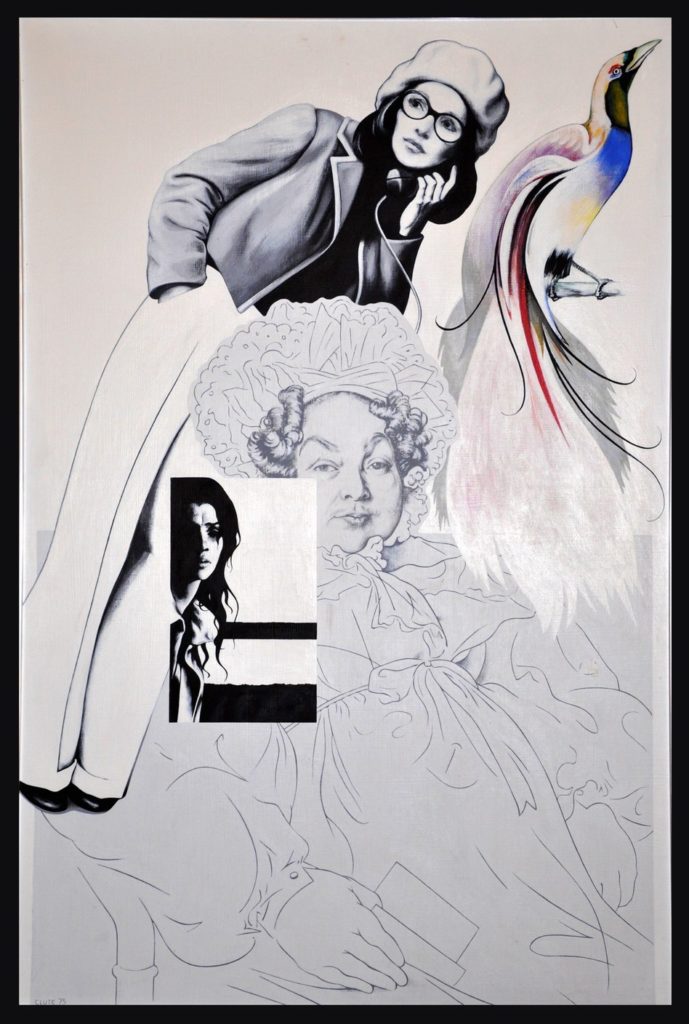
The “conversations” and the feeling of being in a fellowship continues. One of my most ambitious paintings is the Great Chain of Being Show where the mix includes a reference to a medieval Apocalypse painting. I imagined when I was making this – it was 1976 – that I was amusing those 14th century artists by warning them that I would have them rubbing shoulders with 20th century comic strip art. This painting is, in serious fact, all about aggression and sadness and loss. Its size is 1485 x 1245 mm.
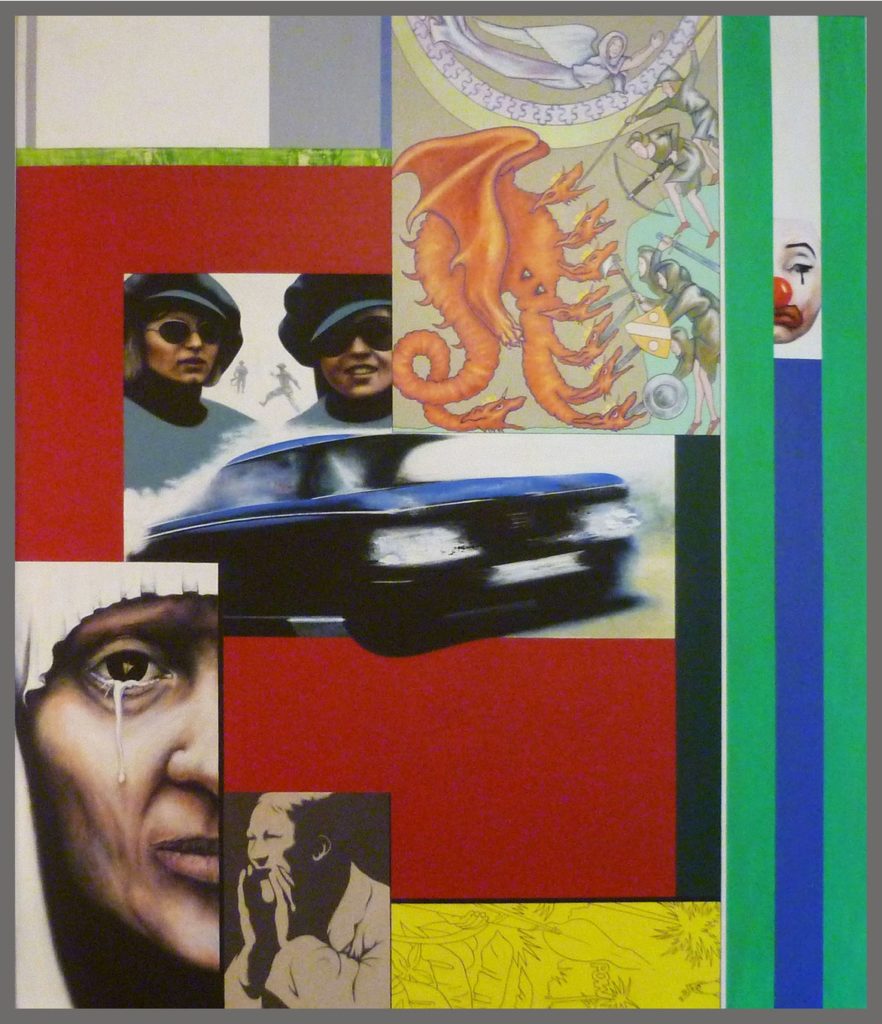
So introducing artists, one to another, happens all the time in my paintings. For instance, in 1988, I made a painting that has the beautiful 15th century painter, Jan Van Eyck, coping with the brash American Modernist artist, Stuart Davis. See the Radiance of the Genes,
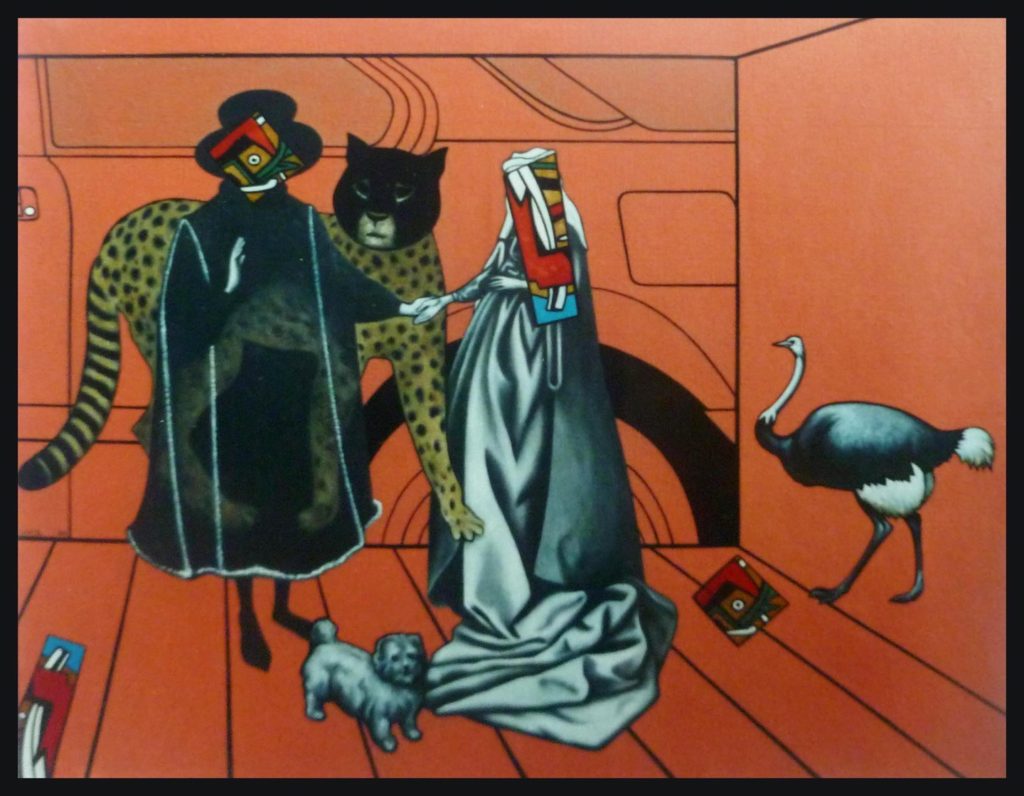
If that encounter is a little edgy, then here’s a more gentle one. Claude Monet gets to see young girls visiting Camden Town. See Bonjour M. Monet,
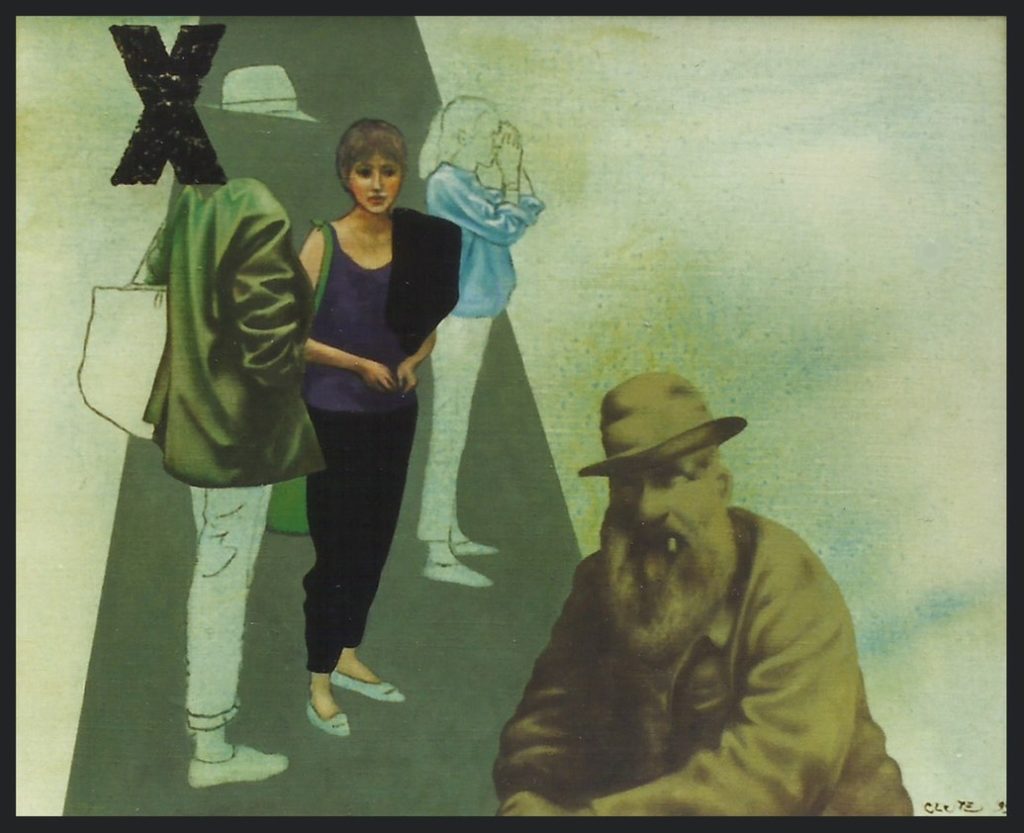
Imagining how painters thought about their work is the continuing game. In 2013, I wanted to introduce Hieronymus Bosch (Catholic and European) to the very British pagan figure of the Green Man. See Parley,
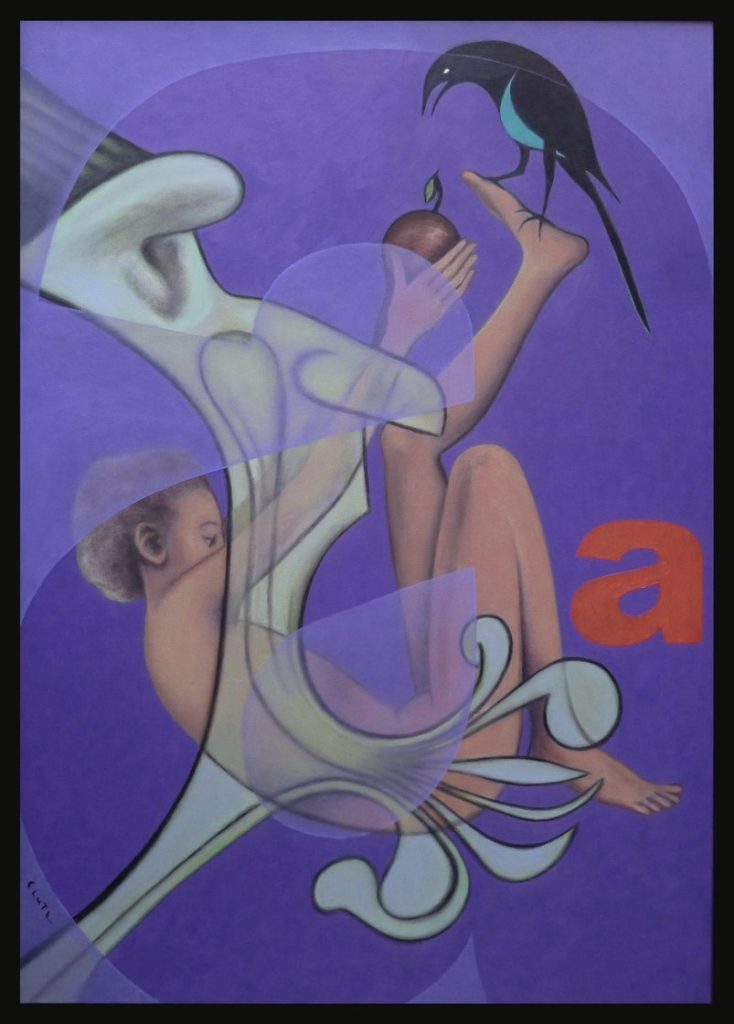
This game is all alien and impossible, and then it is not. It is both. Hieronymus Bosch died in 1516 and that puts him too far in the past. We must only guess at what we share. Perhaps that respected pre-Protestant Christian Fraternity he was a member of, the “Brotherhood of our Blessed Lady”, even allowed for “let us suppose” games. Perhaps, then, there might be a key to unravelling Bosch’s Garden of Earthly Delights. And it might be at the very bottom corner of the third panel. Perhaps the Abbess Pig is whispering into the ear of a character who is Bosch himself. She is whispering the whole story that he then unfolds before our eyes.
Abbess Pig talk to me.
11 January 2019
Today I shortened the “Overview” introduction, thinking those words would be better placed here. It had started with the statement from my 2016 exhibition at the Camden Image Gallery, ” To present painterly arguments about what it feels like to be a human animal living deep within our history on this planet”. I had said that since I’ve been on this planet since 1942, I’ve had some time delving, and that I’m still experimenting with new/old imagery. My painterly arguments go back and forth to, for instance, the wise sages that lived on the North American Continent before the white man inhabited the land. Those sages suggested we should walk lightly upon the earth and live in balance and harmony.
The above mention of my exhibition at the Camden Image Gallery in May 2016, brings me to the fact that I have another exhibition there coming up soon. The one was called Darkening Garden, while this will be titled Masques of the Disappeared. The name of this site. The date is from the 16th to the 22nd of May, 2019. And here’s the gallery link: http://www.camden-image-gallery.co.uk/
5 January 2019
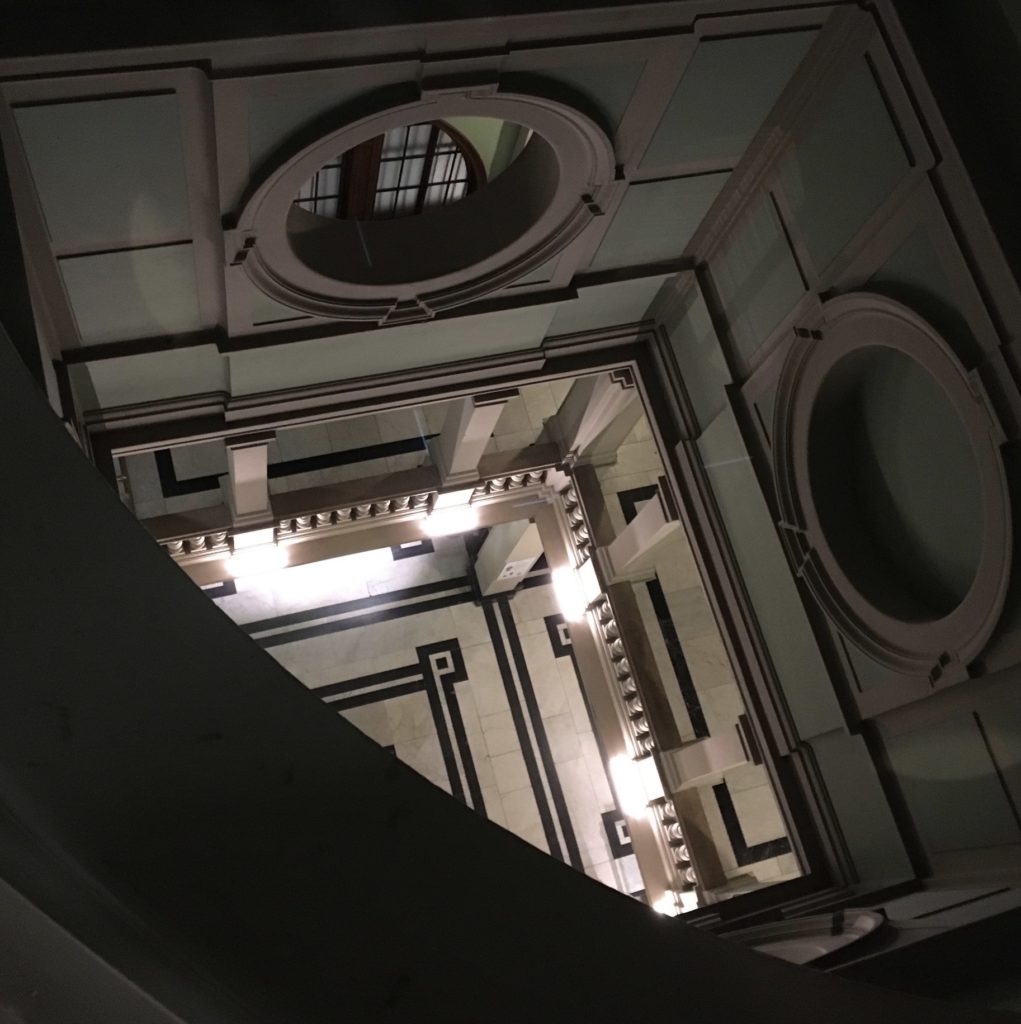
Stairwell beneath the main cupola at the V&A
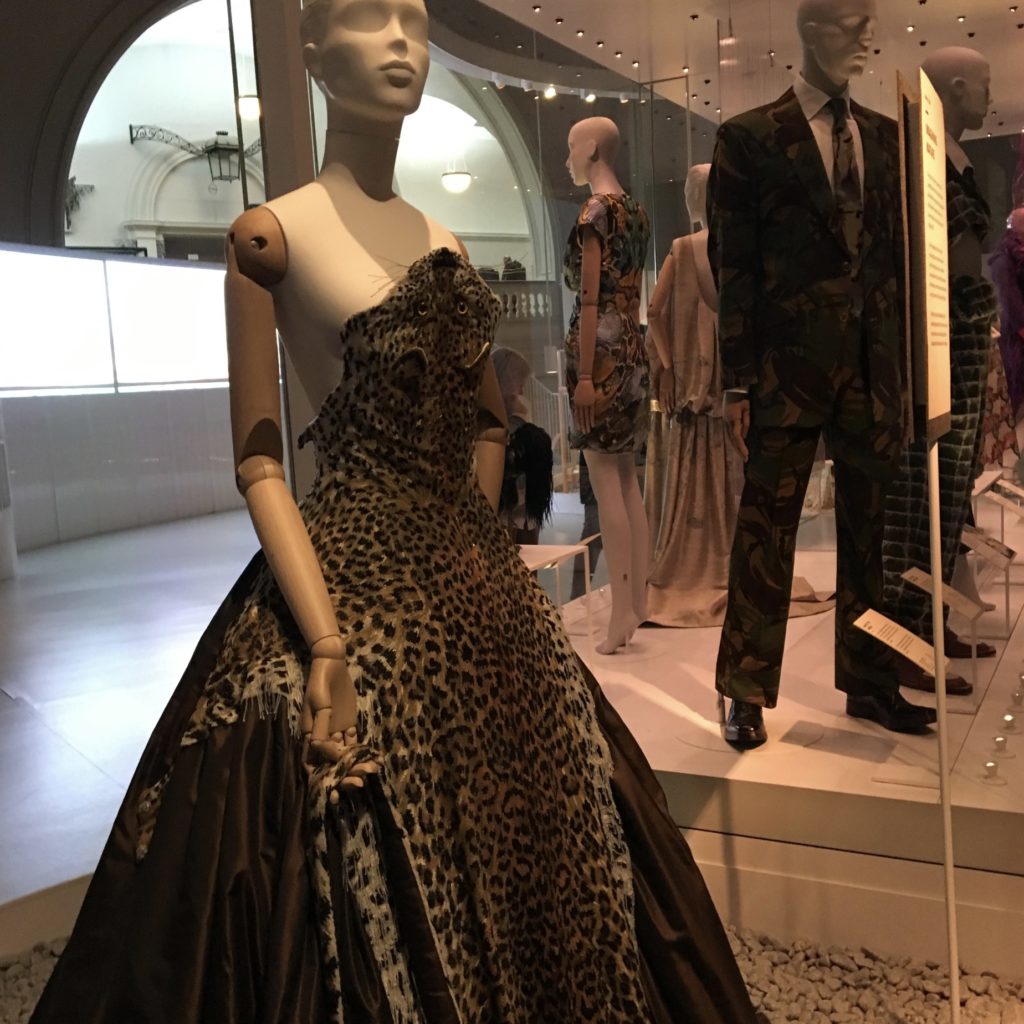
One decadent Item in the Fashioned from Nature exhibition. The “leopard skin” dress is made of tiny beads. Thousand and thousands of hours of work.
2 December 2018

Manhattan Wanting 2018 plate size …. 85 x 180 mm
This is one of my recent etchings. I feel it is strong enough to support a playful intrusion on top of several proof prints. I’ve put images cut from newspaper to make a little triptych:
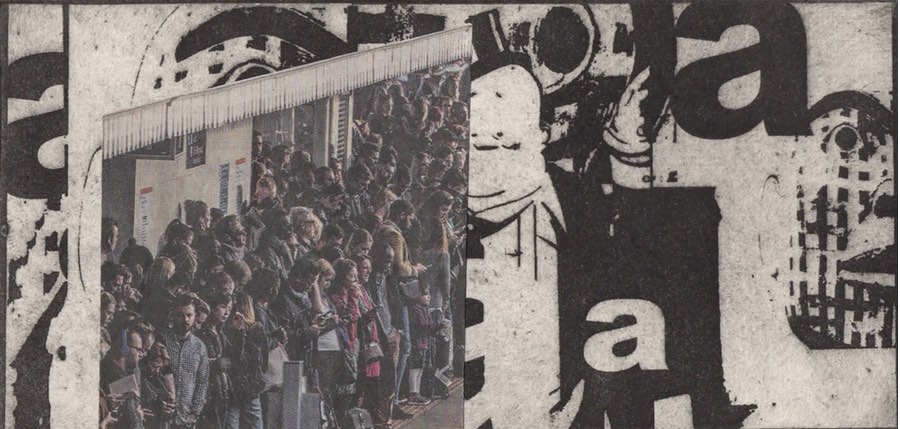
Manhattan Wanting X 2018 plate size …. 85 x 180 mm
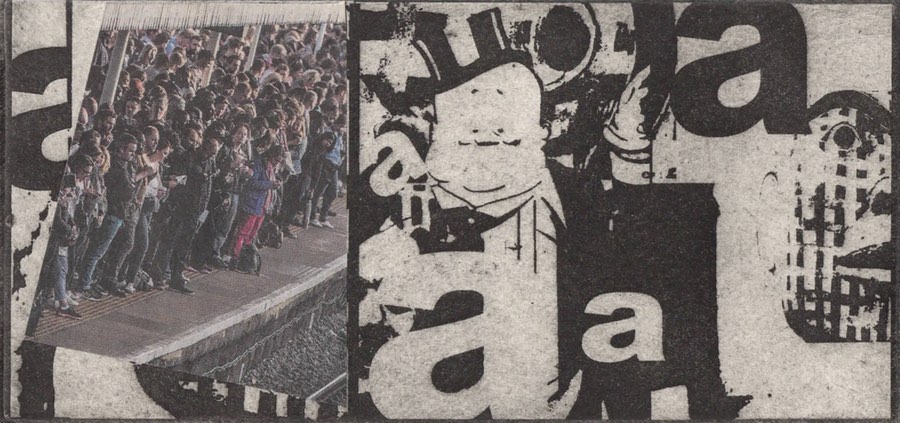
Manhattan Wanting Y 2018 plate size …. 85 x 180 mm
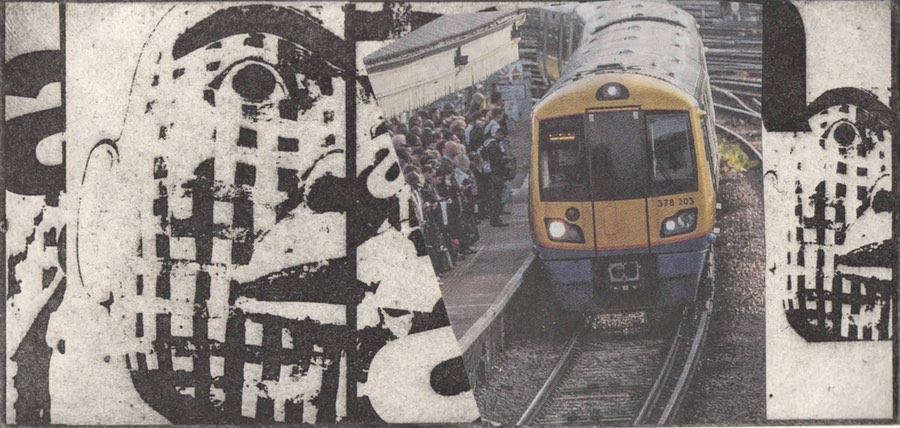
Manhattan Wanting Z 2018 plate size …. 85 x 180 mm
30 October 2018
I’m finally setting out a chronological display of “everything” in paintings and etchings. Here below is one of the first paintings from 1969.
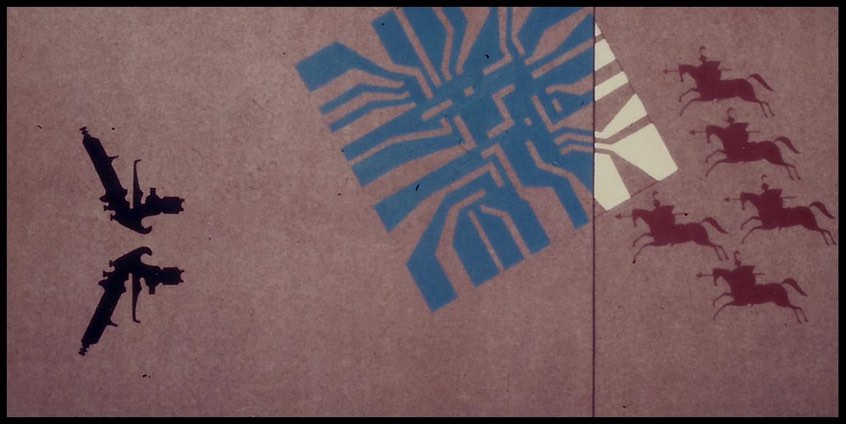
Boardpainting 6 1969 acrylic …. 610 x 1220 mm
28 October 2018
As well as keeping up with the making of new paintings which seems to take months and months, I’m getting a number of etchings mounted and framed. Here’s Blood Simple.

Blood Simple 2018 framed etching …. 520 x 405 mm
And here’s another.
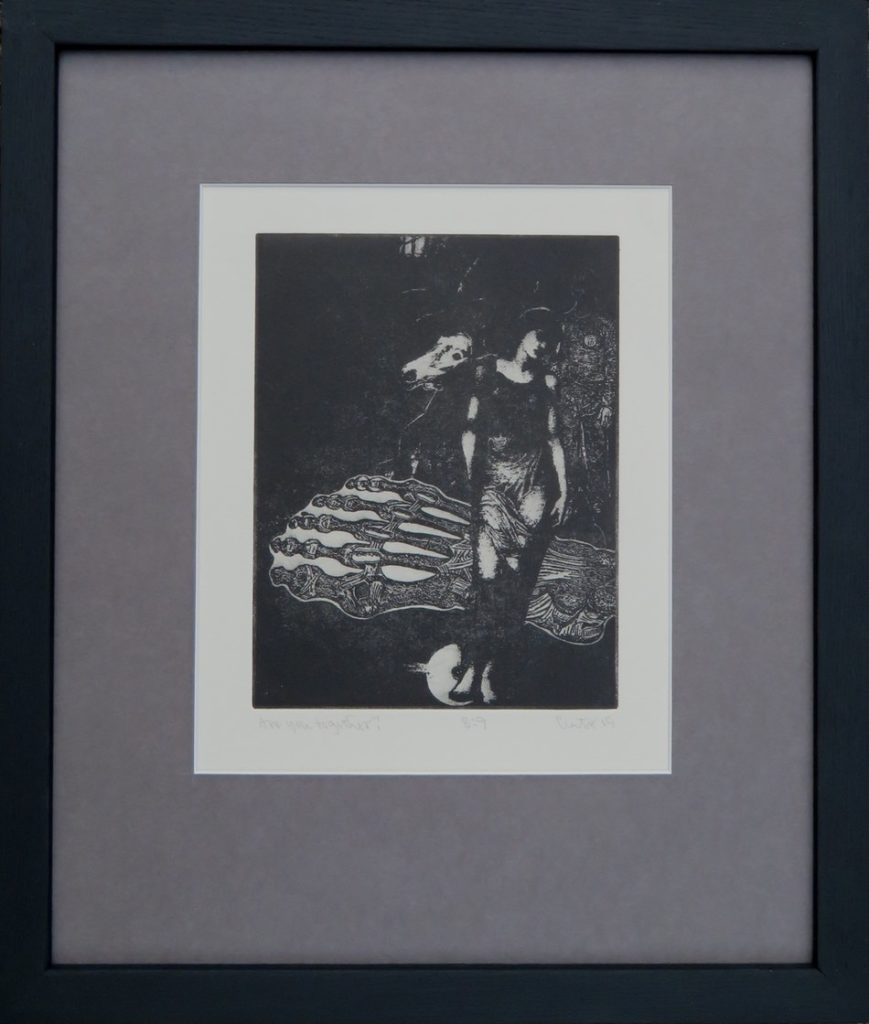
Are You Together? 2015 framed etching …. 388 x 325 mm
7 October 2018
The etching from late summer, “2666”, required a lot of work to pull through to its final shape in an edition of 9. Here is 6/9 , framed size: 434 x 383 mm.
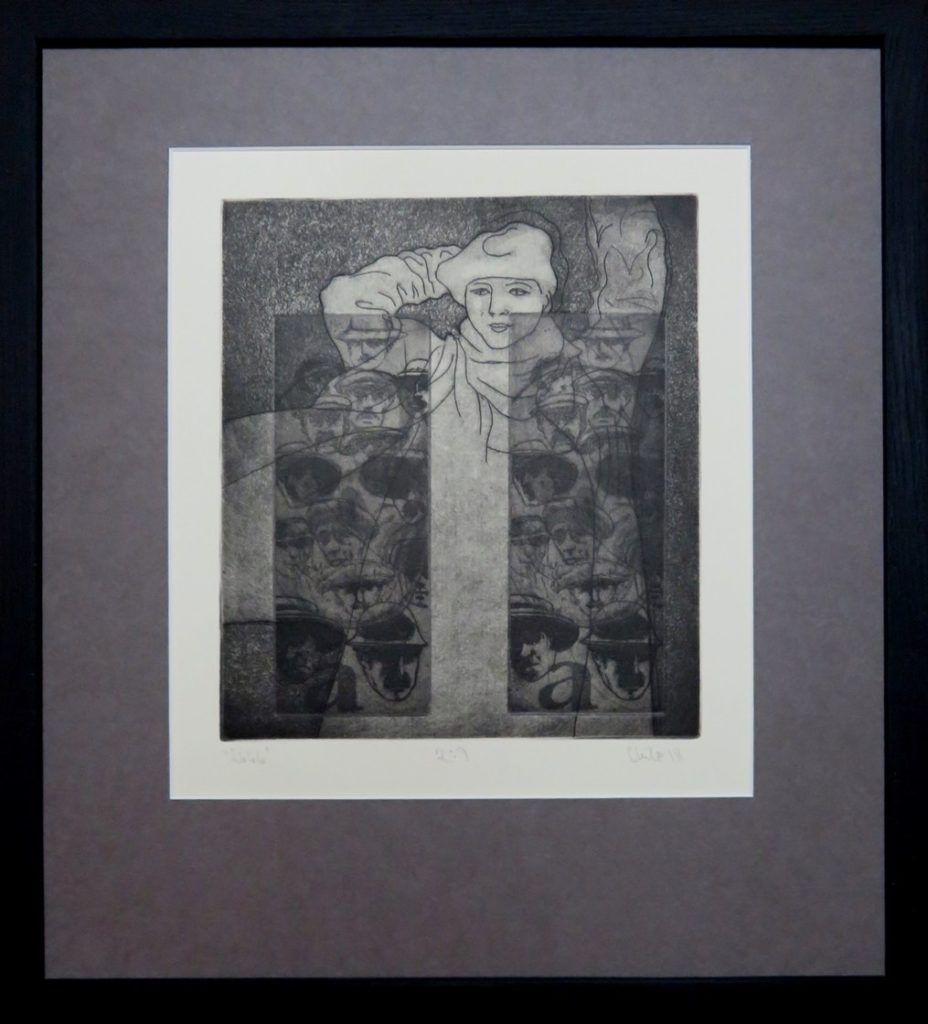
“2666” 2018 framed etching …. 434 x 383 mm
16 August 2018
A new etching. Something I’ve never tried before. I have printed three plates, one after the other, on one paper (dampened each time) to make one single print. It is based on a plate I made in the 1980’s, “Acclaimed”, and the other two are from one plate I made in 2008 for Henry Wessells’ s publication “Forever Peace: To Stop War”. It is titled “Tally” and refers to men lost in the Battle of the Somme. The resulting print makes reference to Roberto Bolaño’s long novel, “2666” .

“2666” 2018 etching …. plate size 220 x 200 mm
23 July 2018
With reference to the Arts Lab Continuum show opening on the 5th of July, I just received some photos from Morna Livingston. She was staying with me and so we had arrived together. She captured my anxiousness at the onset when David and I were wondering if we had everything in order. But of course I had forgotten to take off my handbag and had neglected to tuck the scarf under its collar. Whatever. Thank you, Morna, for capturing these early moments.

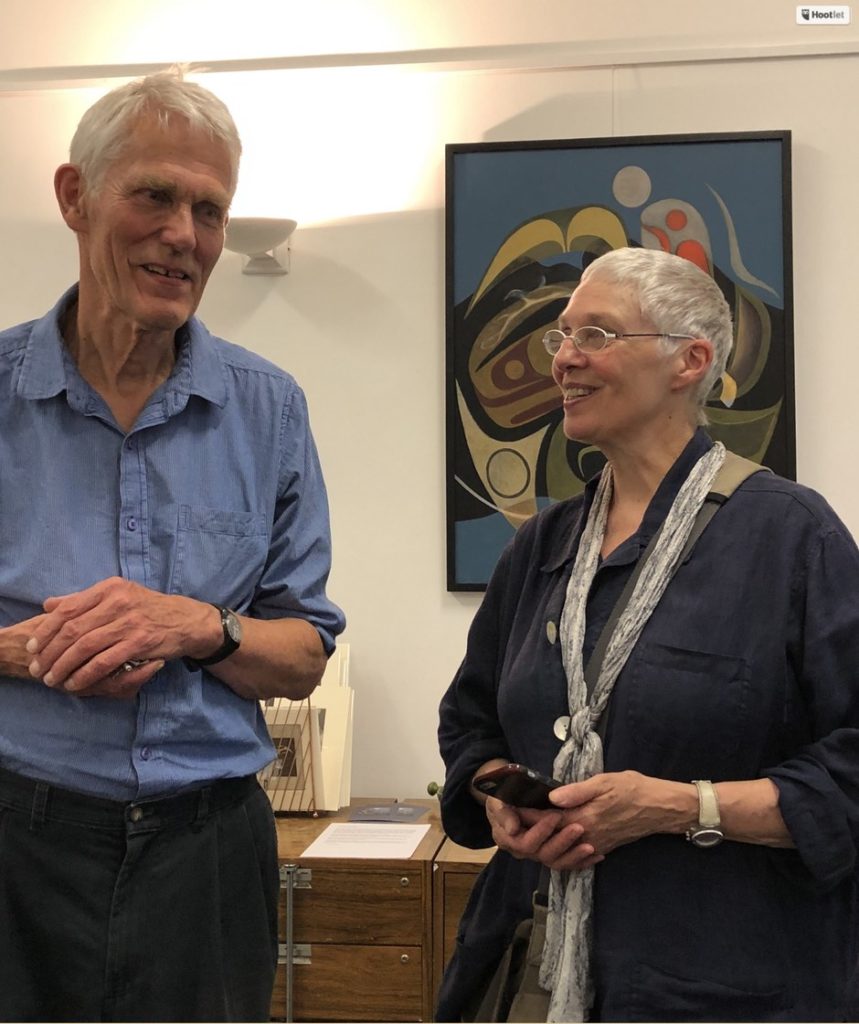
Morna managed an especially good angle so you can see people looking at Biddy Peppin’s posters made for the Arts Lab films in a big portfolio, and also we can see people sitting in a comfy couch looking at (out of shot) David Curtis’s text of the history of the Arts Lab projected onto the wall.
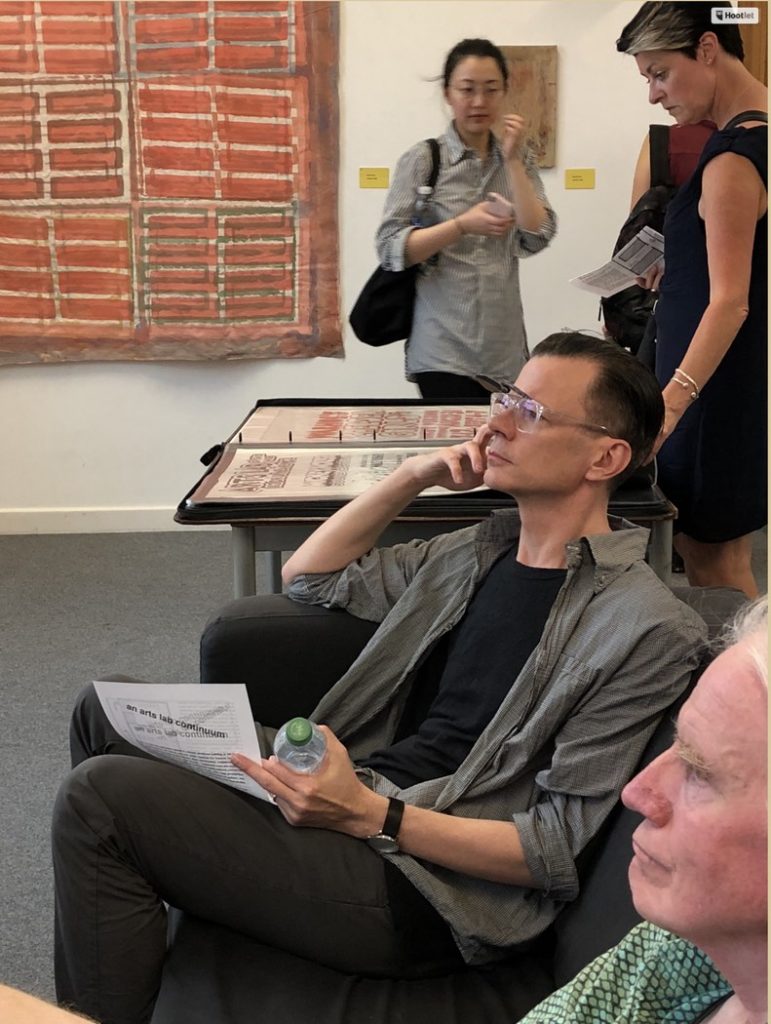
Also, an image of me being funny with Mathew Downward and Krishna Roy.
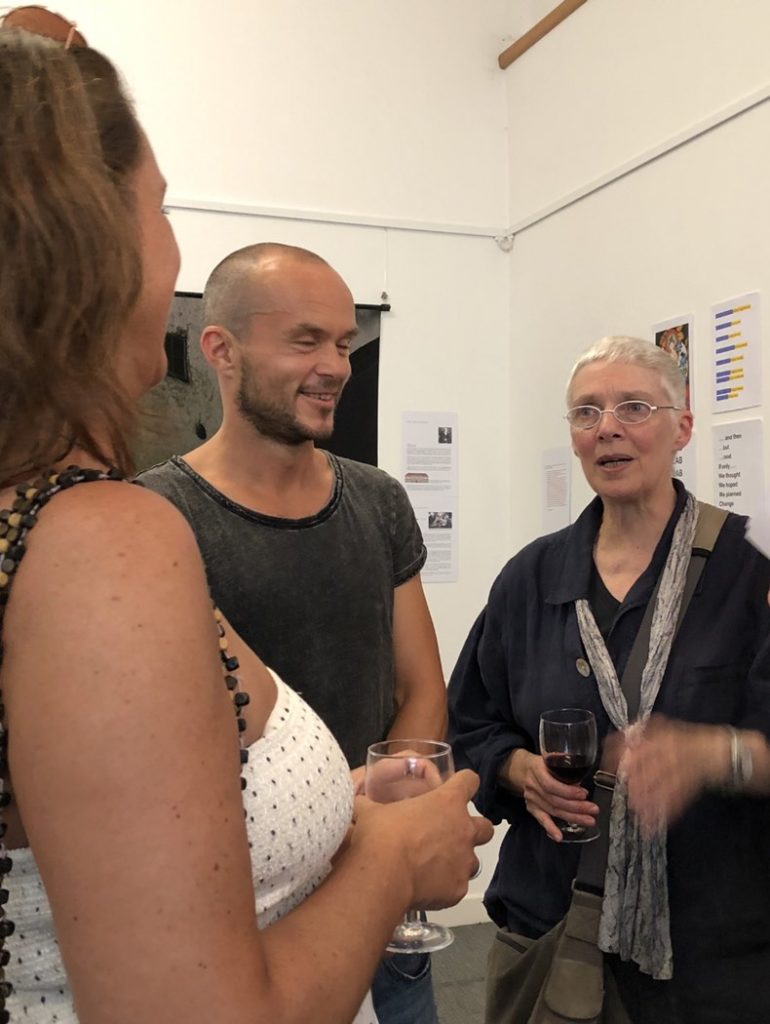
11 July 2018
Finally some pictures are emerging from the opening party last Thursday (5th July 2018). We have had record shot problems – just like the arts lab, where in the late 1960’s it was the moment that mattered, and never mind recording it. First one camera failed and then another was forgotten (mine). Whatever, here is one photo right at the beginning. Anne Wittman and Krishna Roy are talking. You can see David Curtis’s power point in the background, on the wall.
And below, people are sitting, watching the story of the old Arts Lab at that power point.
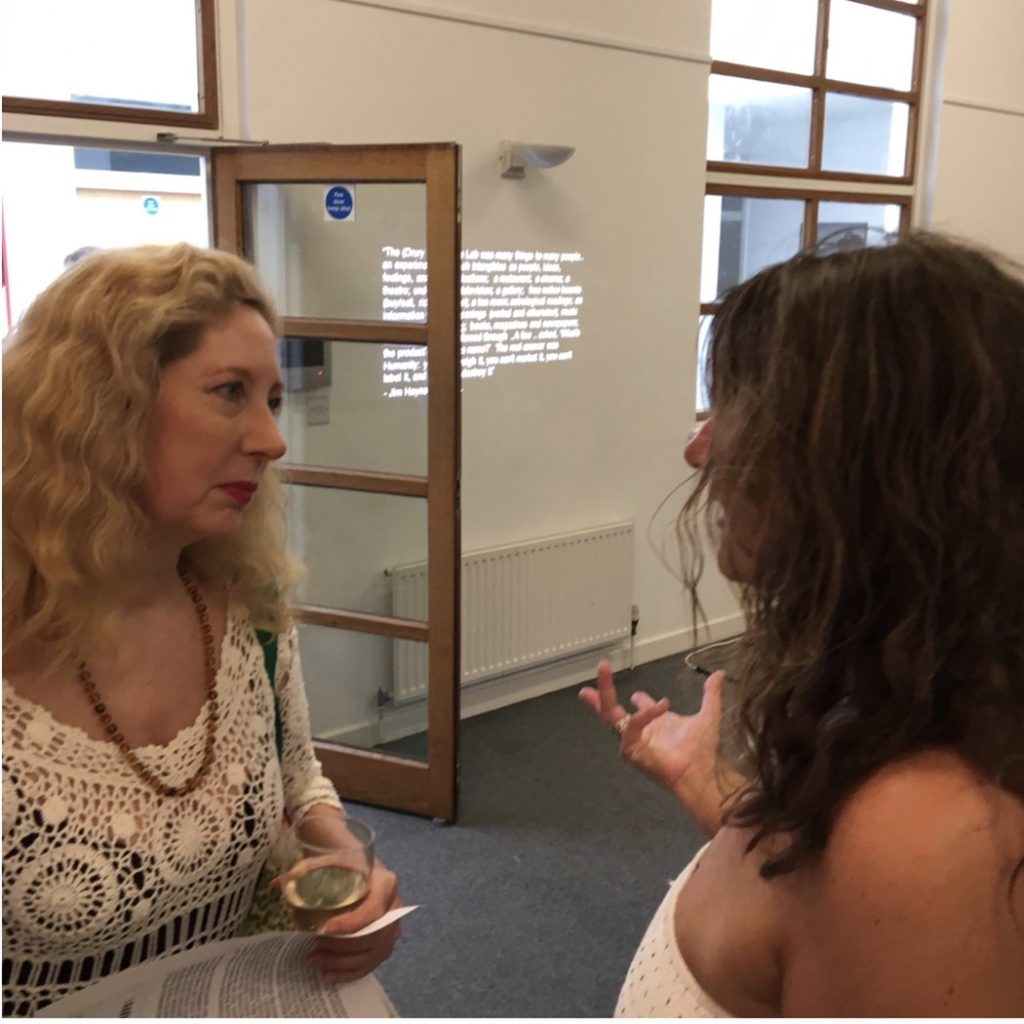
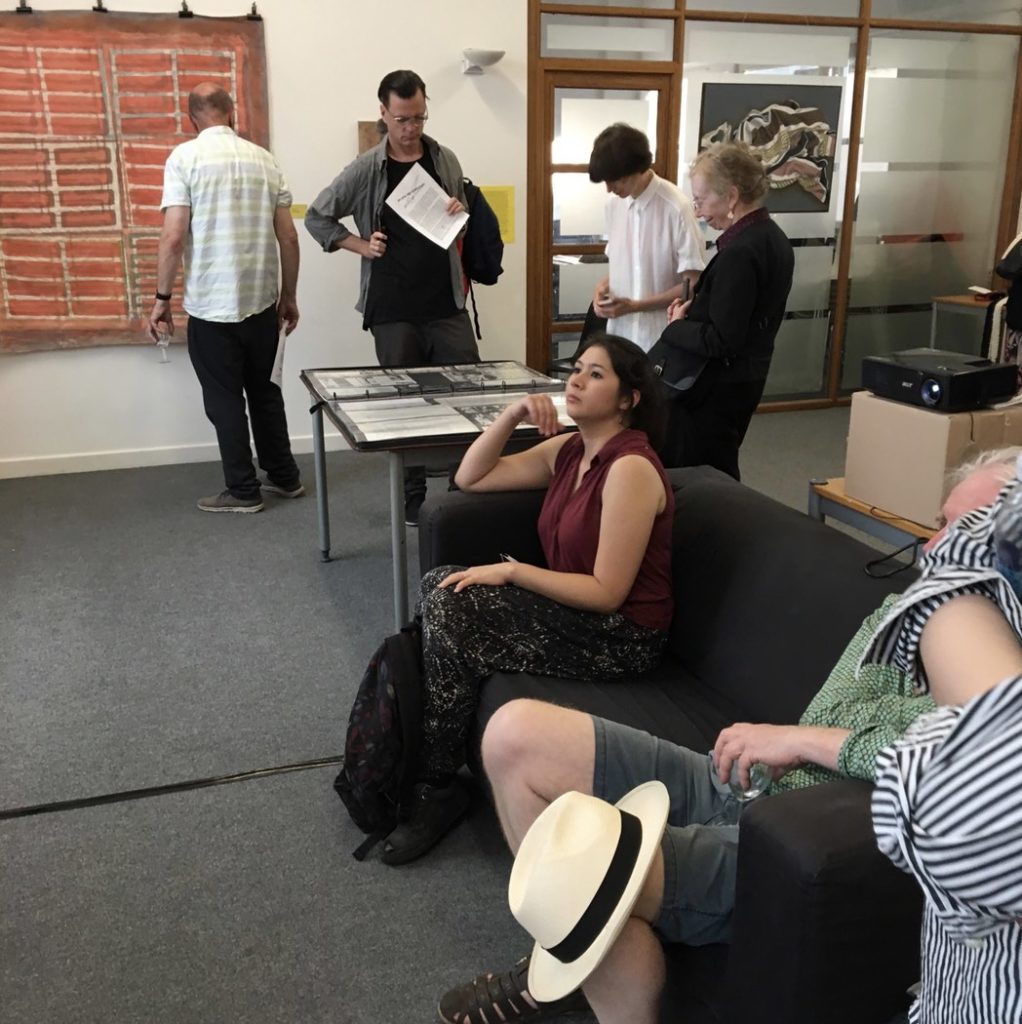
A view beyond Pamela Zoline’s board game, where we have the backs of Judith and Barry Forshaw, and Paul McAuley facing.
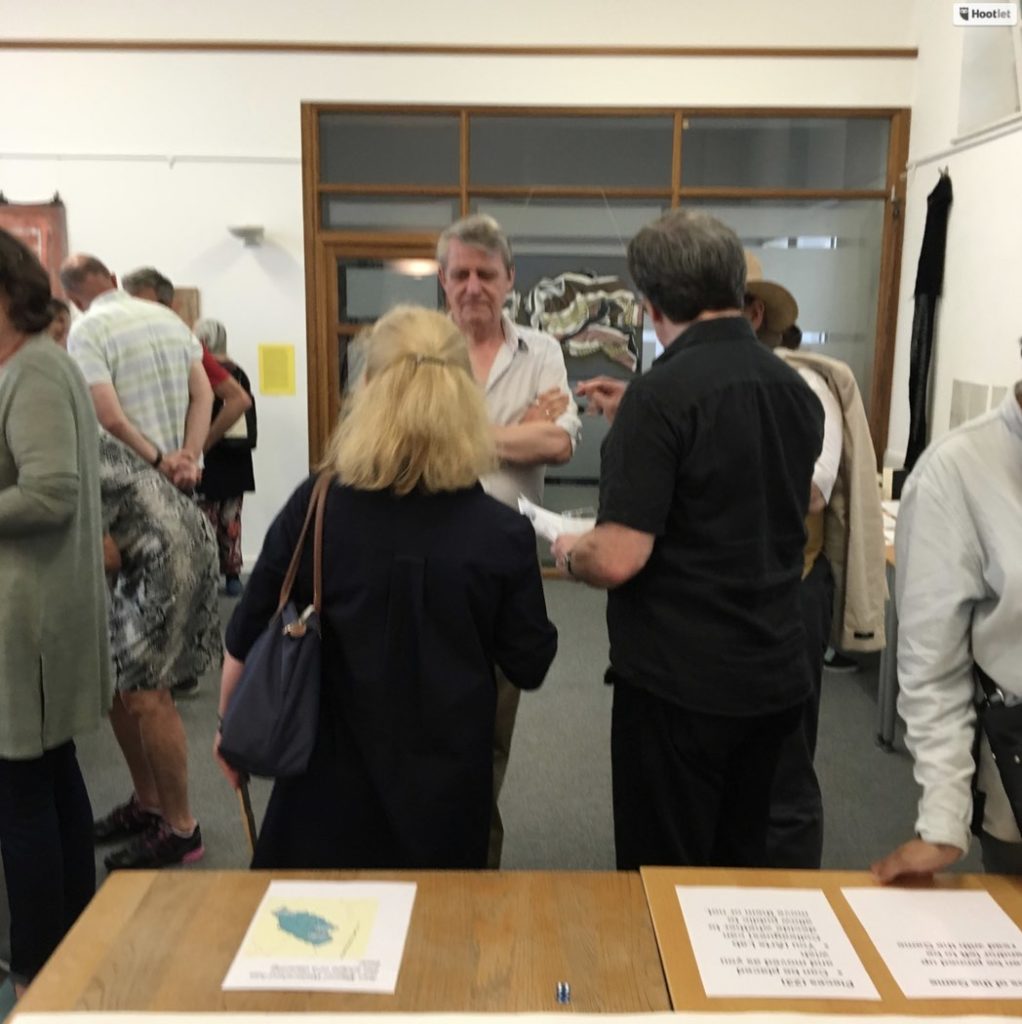
Here are two book sellers. Good people always. Mathew Downward and David Tobin of Walden Books (almost out of picture).
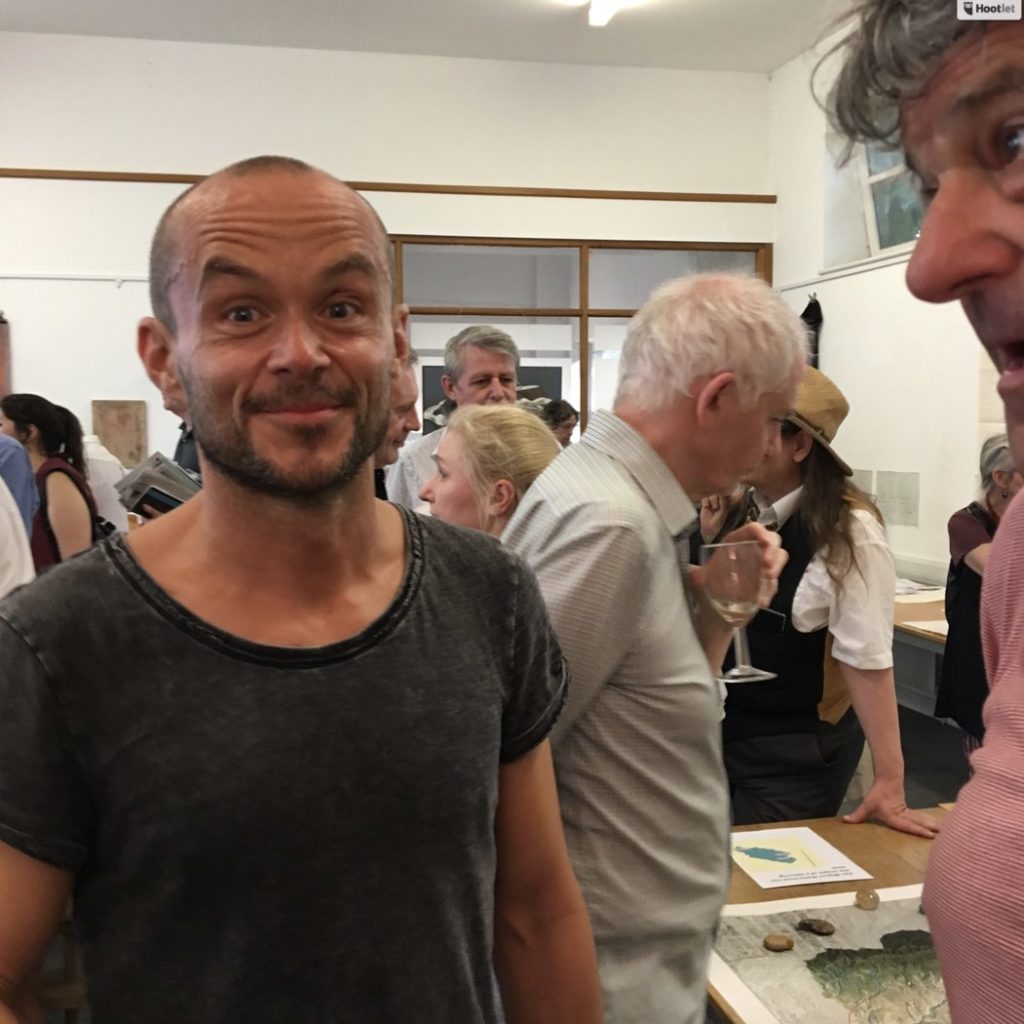
The so-called Sky Gallery had a few of my etchings. Here is David Selley standing in front of some. David Selley is also www.DianeChorley.com. Not to me missed.
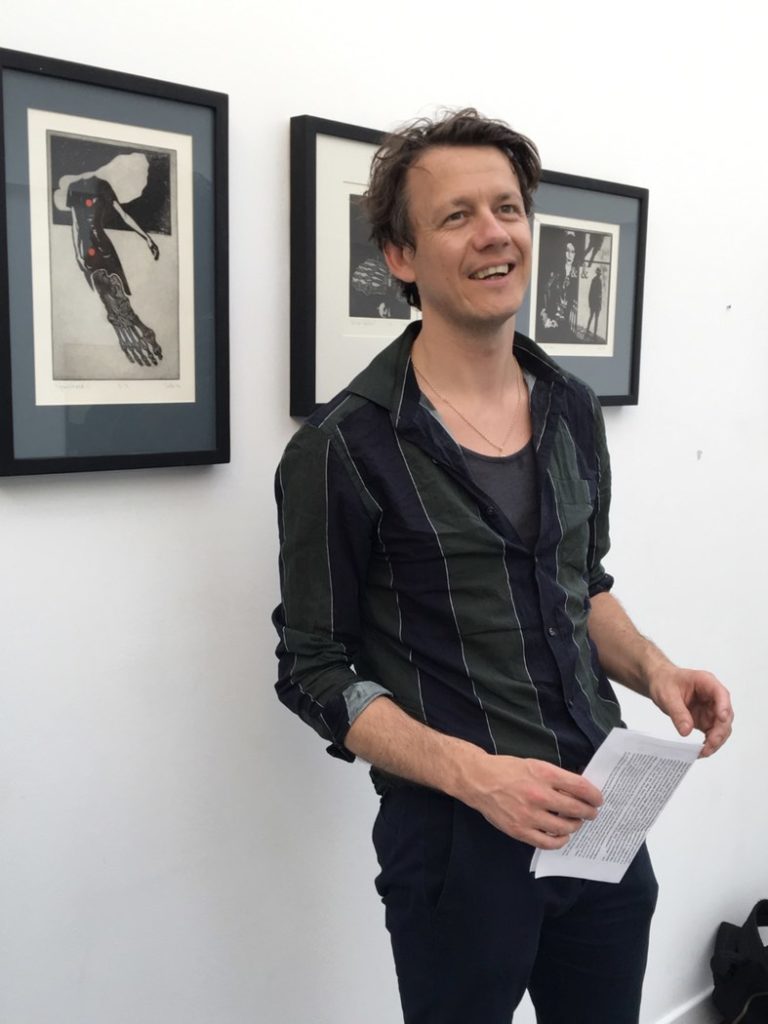
Also upstairs (with a couple of my paintings in the background) was Graham Stevens. He is to be found at bluegreen.com. Solar energy and all good things dealing with water and the atmosphere.

7th July 2018
The Arts Lab Continuum on Thursday night (5th July) at Spitalfields Studios was a grand party. Thank you to everyone who turned up. Below is a calm picture of my “Night and Silence” triptych taken before visitors arrived. (Cavé – Night and Silence – Cliff).
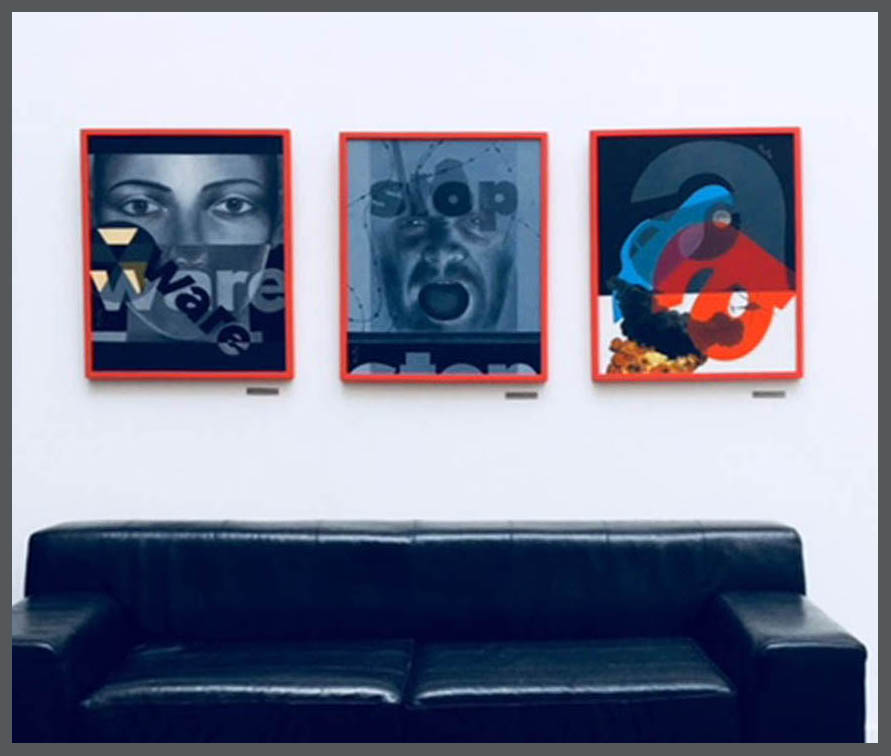
And here’s the note that went with it. “This set of three paintings titled Night and Silence, rests within the overarching Blood Simple category that obsesses me these days. It is my way of staying true to our Arts Lab intentions of the 1960’s when we knew, as we know today, that all the governments of the world will send young people to fight their battles. Old men and old women in executive positions killing off young men and young women: I know it’s part of our animal nature but I still try to make a statement. And try to, as Pamela has put it: “shift our interior furniture, just a little, bit by bit, and so the world moves.”
In the main room: Judith Clute’s table, see below. The painting is “Voiced”, and on the table is a range of things like a print rack and also, almost invisible in this photo, John Clute’s “Stay” (Beccon Press) with this painting depicted on the cover.
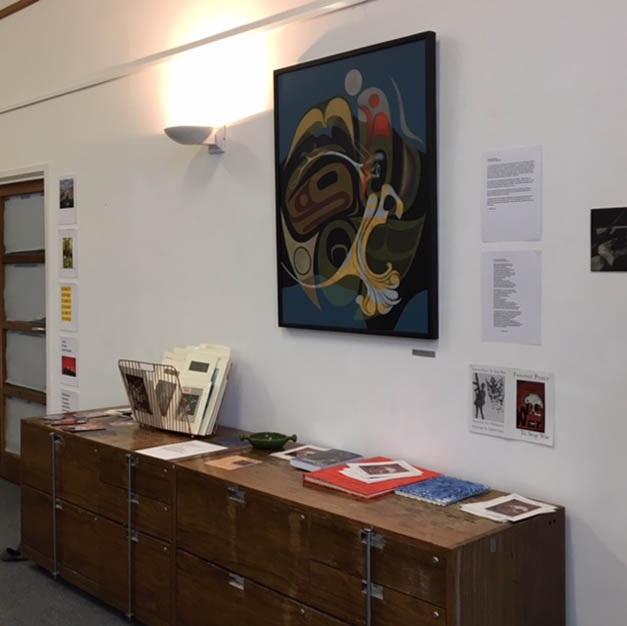
5th July and 6th July 2018
“an arts lab continuum” at Spitalfields Studios. See below.
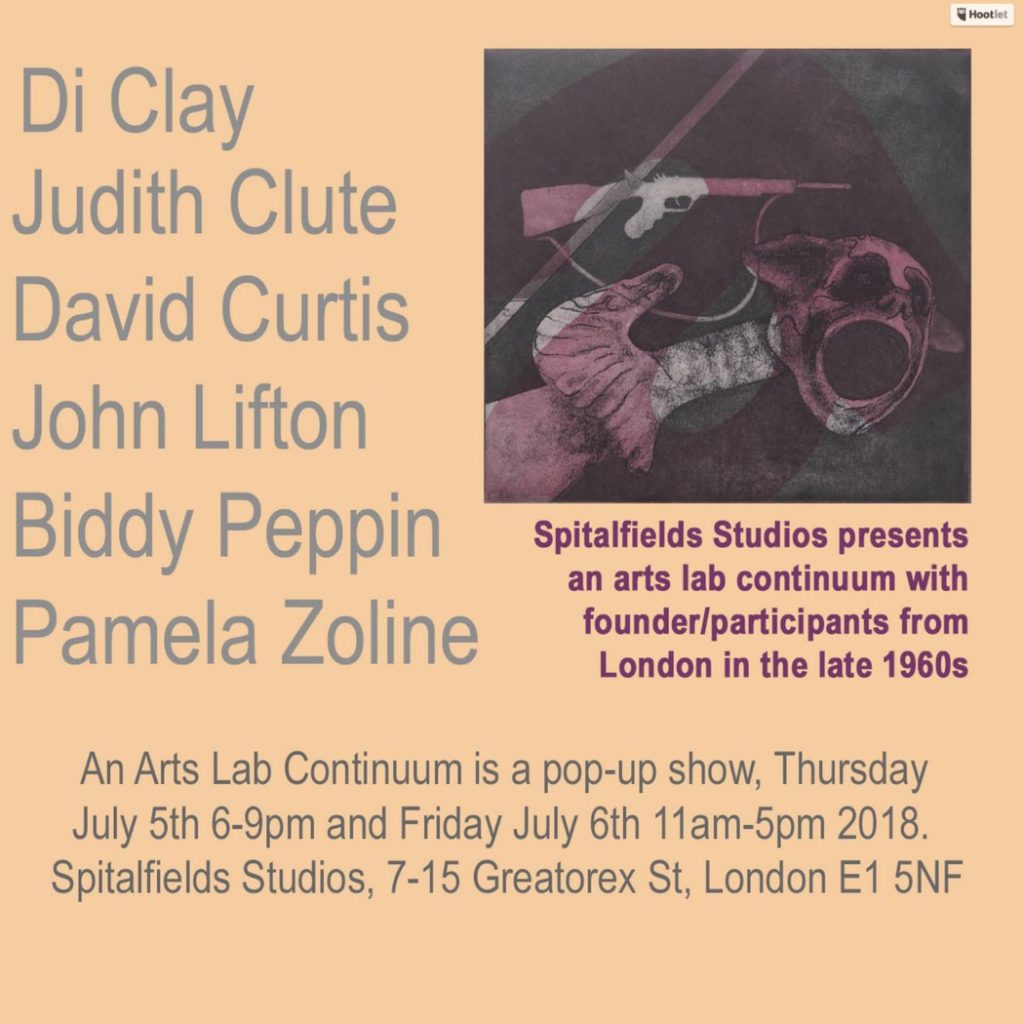
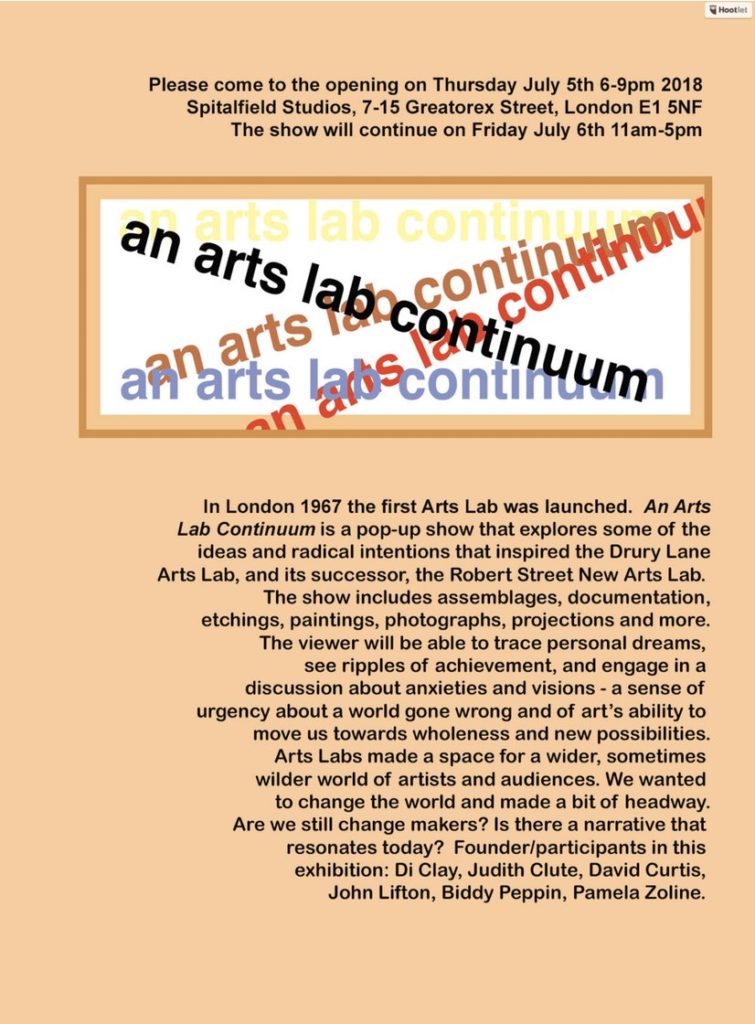
1st July 2018
As I work deep down in the factory of the mind there is a certain shape syntax that develops and likewise a sort of – word syntax. This may not make sense but I can’t think how else to explain that place I inhabit where I try to establish visual meanings: meanings that will not resolve into easy outcomes. There are stories within stories being told. And this is all totally visual. The works dramatise the feel of being a human animal in the global village we all inhabit. Again, visual. Ben Shawn once said: “Shape of Content”. I like that.
The paintings and etchings have developed into themes. There’s one responding to the sad issues of war throughout our planet: Blood Simple. And the one that has somehow always been there – even before John Clute wrote his book with this very title: Darkening Garden.
Some of my ideas are lifted (sampled) from Hieronymus Bosch’s Garden of Earthly Delights and also from Inuit art where compelling designs seem to come from the heart of our old world.
I intend that my work continues to sharpen an underlying presentation and a recognition of the contemporary world. This is becoming more and more urgent. My work is not bricolage; it is recognition.
21 June 2018
Antonia Moore, photographer, organised a little show at Gerry’s Club Soho. I was the mystery guest. It was fun. I sold all my etchings. We plan another in September.

29 March – 2 April 2018
Eastercon (Follycon). Poster for my work below. John Clute and I drove up with Stan Robinson, writer GOH, to Harrogate and I set up a small selection of etchings within the gallery arranged by Selena Culfeather with her partner, John Wilson. I sold 5 out of 12: a 70 % reduction made it possible for Eastercon fans to buy.
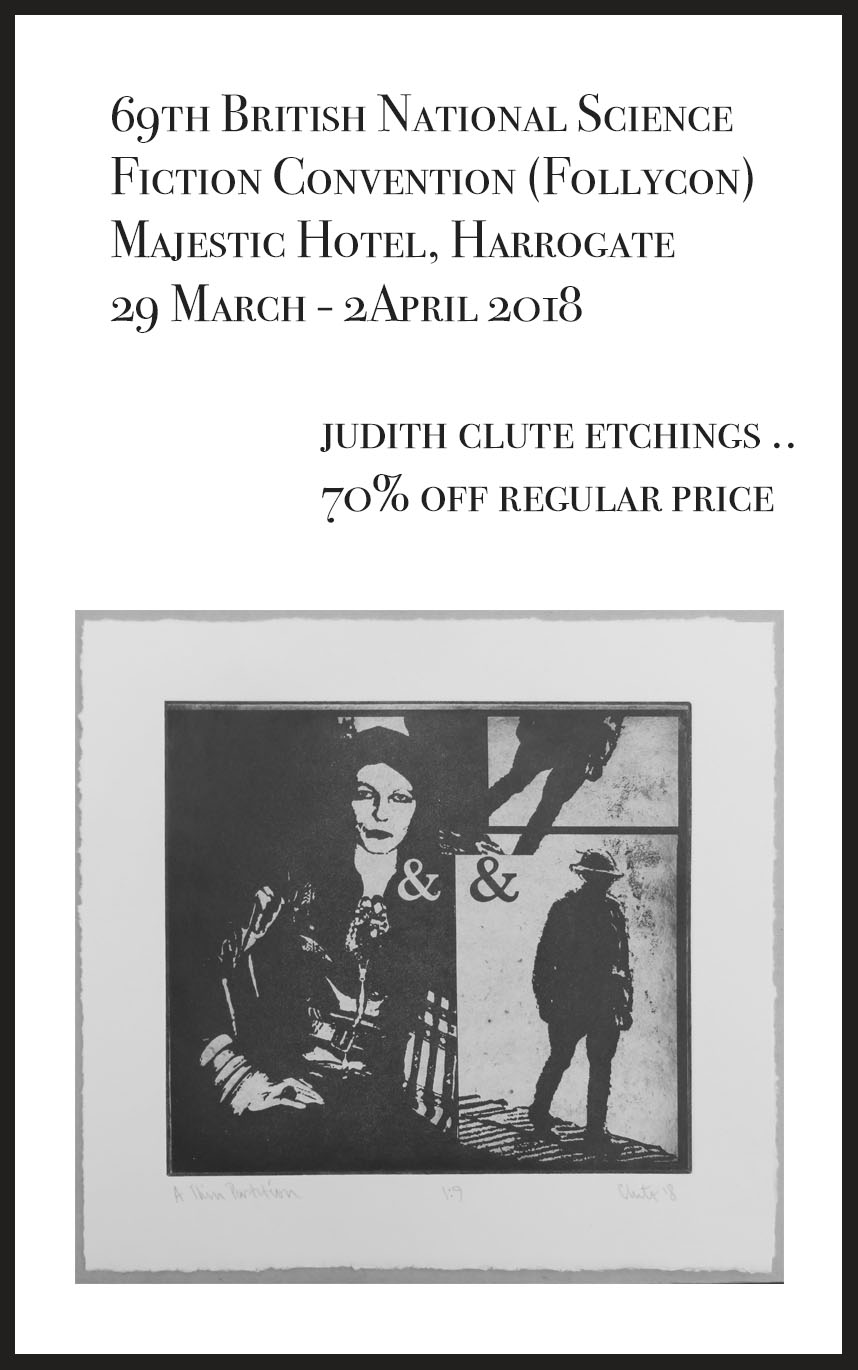
Then John Clute and I went to Knaresborough, famous for its beautiful 1852 viaduct crossing the Nidd Gorge. It is depicted on 1930 travel posters. And also special to Knaresborough are a few old buildings with sections painted in black and white squares. It seems that the old manor house, was treated to this pattern on its upper sections in 1832 because the then owner was mad about chess. Subsequently a few other buildings were likewise painted in this most striking checkered pattern.
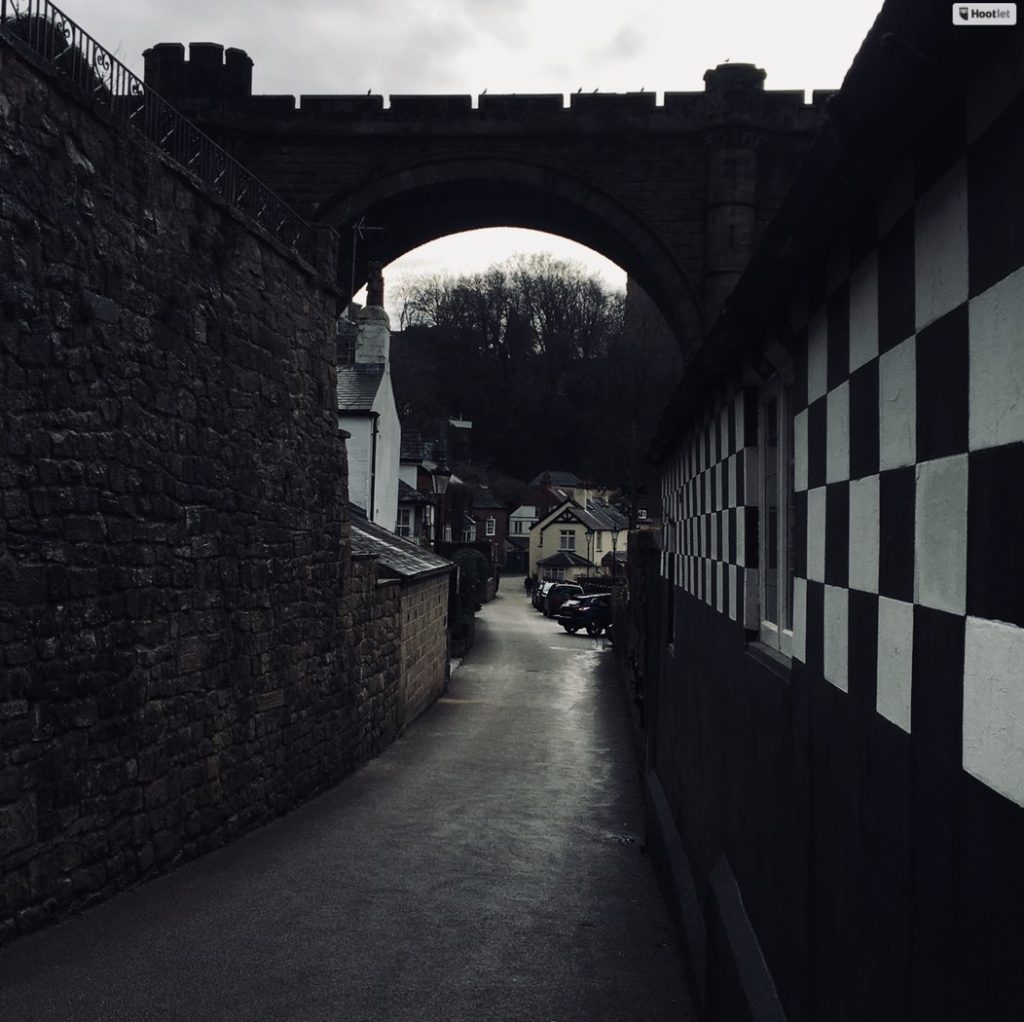
13 January 2018
A note on blood synchronicity: a painting, “So Tell Me I’m Wrong”, from early 2017 and the cover artwork for the record “Yo Mae Leh” currently being played on radio 6.
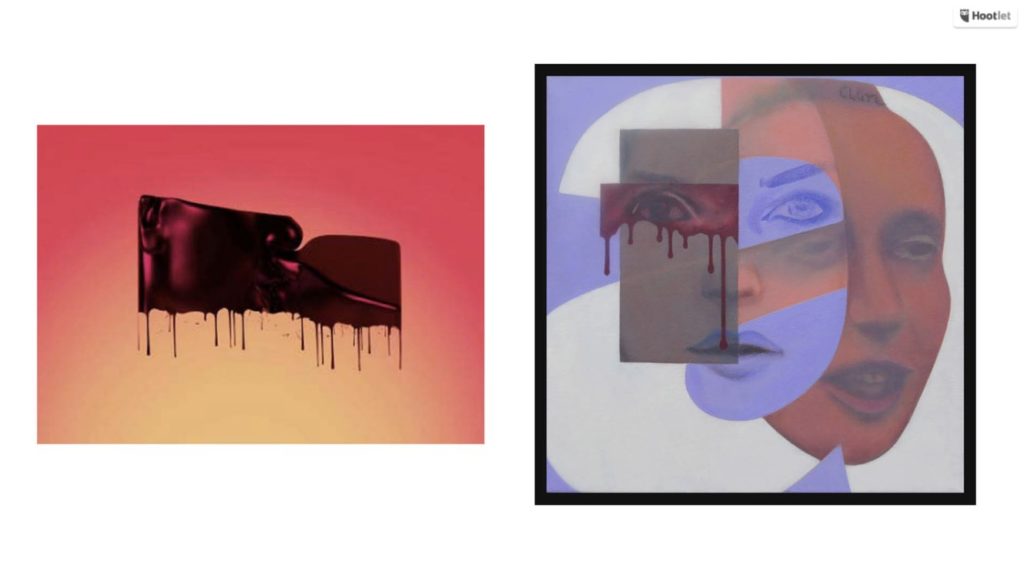
I like the record and especially the strand of chanting which seems to reference Native American ceremonial singing. And I do wonder if it is synchronicity in the artwork or perhaps in fact, I myself, am being referenced. Either way, I’m happy.
31 December 2017.
Art note – how I got to where I am now. I feel that I’m still that same human-creature/machine-in-harness that I discovered myself to be, back in the 1950’s. In English class I learnt about T.S. Eliot. He helped sort some of the confusions around me. I was a child born during WW2. I was, like many others of my generation, safely away in Canada, specifically kept from any stories of the war that had just finished. I was part of the clean slate. But that wasn’t going to work, was it? My Darkening Garden theme started then, although of course I didn’t put it in those words. When I was at school I was reading not only about WW2, but also about some of the awful things that happened in WW1. How to make sense of these terrible losses and all the others around them? A world of big sadnesses. Then T.S. Eliot and The Waste Land. And a little later, Science Fiction and Fantasy. Books, all sorts of books, but mainly fiction. The stories we tell ourselves: they all feed – present tense – into these big rooms, my inside factory where art happens. It’s all a-hum in here. And so I’m still making paintings. Just the way I used to.
But back in the day when I was starting out, I noticed, for instance, Joseph Kosuth, a young American painter of my age, rejecting painting and going a quite different path. I saw him sailing off from “my” pond arguing that only ideas mattered in art. Fine: we’ve already had Marcel Duchamp and his urinal in 1917. But that moment in the late 1960’s had me smiling and crying because the rift was being clearly set up between “ideas” on one side and “making” on the other. I felt somewhat depressed by painting being lessened in that way and not until the 1970’s in London did I get to grips with my problem. I got John Clute to help me with my titles. I wanted people to see that there really was thinking embedded in the craft of making these works.
Titles. They should help you as you look, reassure you, that you can interpret as you choose. I give open-ended directions. But that’s not to say there isn’t an element of mystery. In this context I’d like to pass on a neat observation by Peter Viereck in his play, The Tree Witch: “Truth is not graph and glare, but fluff and side-glance.”
21 June 2017
The touring for “I Can Spin a Rainbow” has finished this June 2017 and Amanda has given me signed copies of the Vinyl and the Cd: they are signed by Amanda Palmer and Edward Ka-Spel of course, but also by Patrick Q. Wright who played the violin. What a delight to have done this artwork for them.
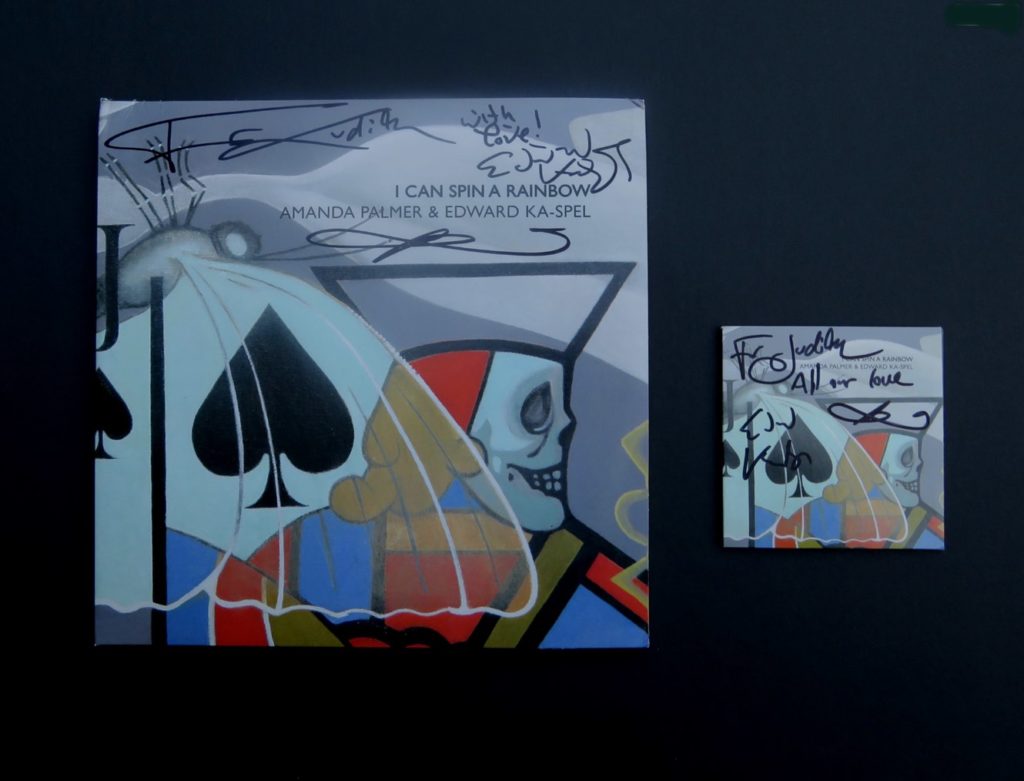

And here is the back of the Vinyl.
20 June 2017
I want to thank the ESFS (European Science Fiction Society) for the award they have just given me. I’m entered in a tie with Aurélien Police for Best Artist in their Hall of Fame award this year, 2017. Thanks to everyone involved.
14th to the 17th of April 2017
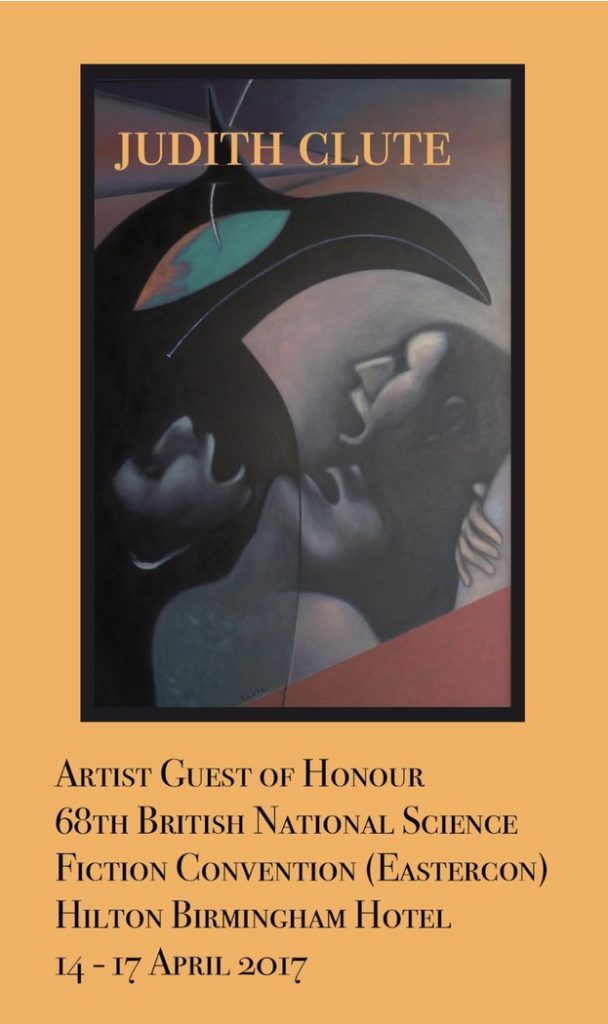
Artist Guest of Honour at the Birmingham Metropole Hotel: Eastercon.
7 March 2017

Exhibition in Gainesville, Florida.
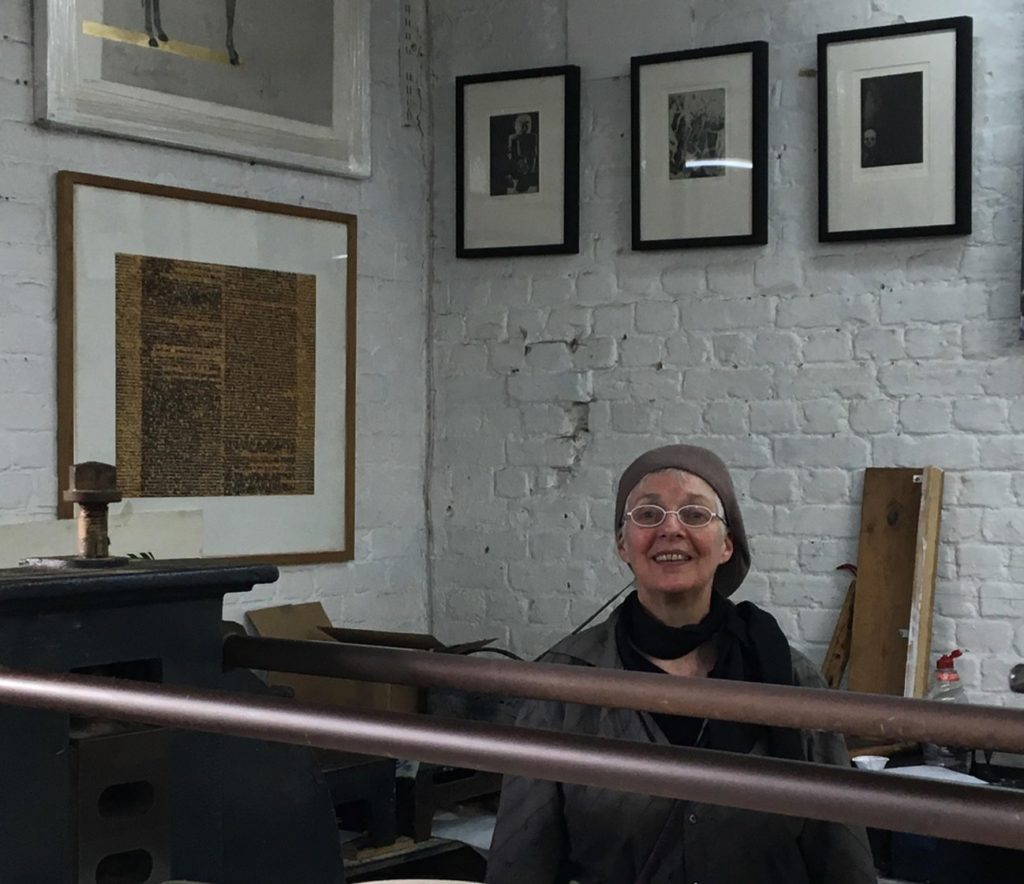

Judith in Artichoke print workshop, January 2017
